Category: 2024
Minerva Skyttä
(ma) MS_01
MS_01

Minerva Skyttä MA Graduate collection Photographer: Sofia Okkonen
MS_01 MS_02
MS_02

Minerva Skyttä MA Graduate collection Photographer: Sofia Okkonen
MS_02 MS_03
MS_03

Minerva Skyttä MA Graduate collection Photographer: Sofia Okkonen
MS_03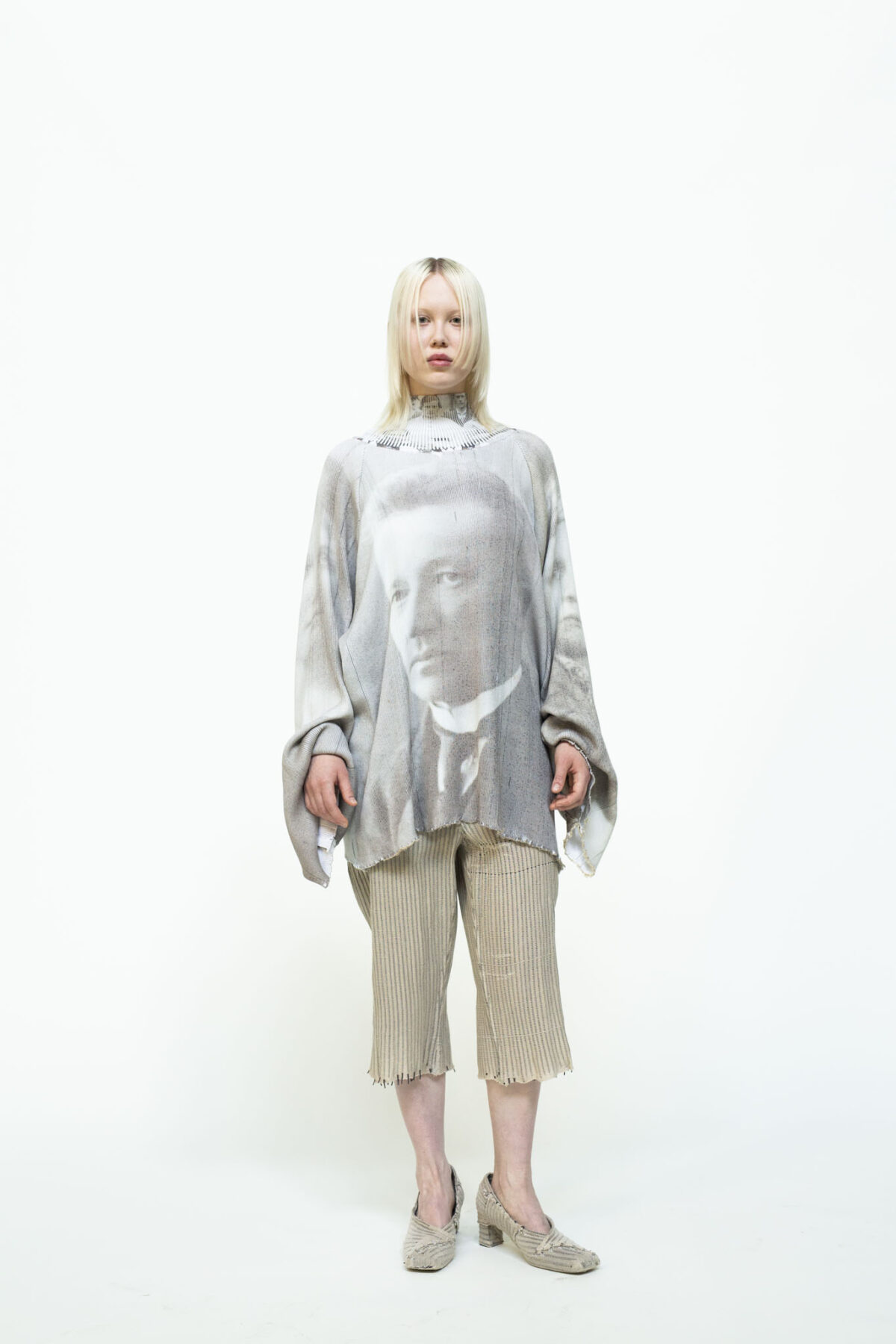 MS_04
MS_04

Minerva Skyttä MA Graduate collection Photographer: Sofia Okkonen
MS_04 MS_05
MS_05

Minerva Skyttä MA Graduate collection Photographer: Sofia Okkonen
MS_05 MS_06
MS_06

Minerva Skyttä MA Graduate collection Photographer: Sofia Okkonen
MS_06Knitting Memories
Minerva Skyttä’s graduate collection consists of knit structures she has designed. Skyttä has re-attached the knit back to the machine and knitted it in different directions. The shapes of the garments are sculptural and evolve through the process. Her goal is to create something that is not possible to replicate.
– My knits are born in the moment and express my current feelings and “mood”. I approach knitting as a form of painting, where I master the technique perfectly and reserve the right to creative freedom, Skyttä says.
For the collection, Skyttä drew inspiration from the correspondence of her relatives in the early 20th century in Kymenlaakso in South-East of Finland, and China, where some of her family members were located.
– There were several authors in the letters, and the letters and memories were passed on from generation to generation in my family. Understandably, the letters hold a lot of emotional value for me; they tell the forgotten story of my relatives and paint images of what my relatives’ lives might have been like.
In her collection, Skyttä examines the nature of the letters and tries to replicate their appearance, handwriting, smell, fragility, folds, feel of the material, passage of time, stains, sun fading, yellowing of ink, and written content in the collection.
Contact information:
Minerva Skyttä
+358407528244
Mette Wik
(ba)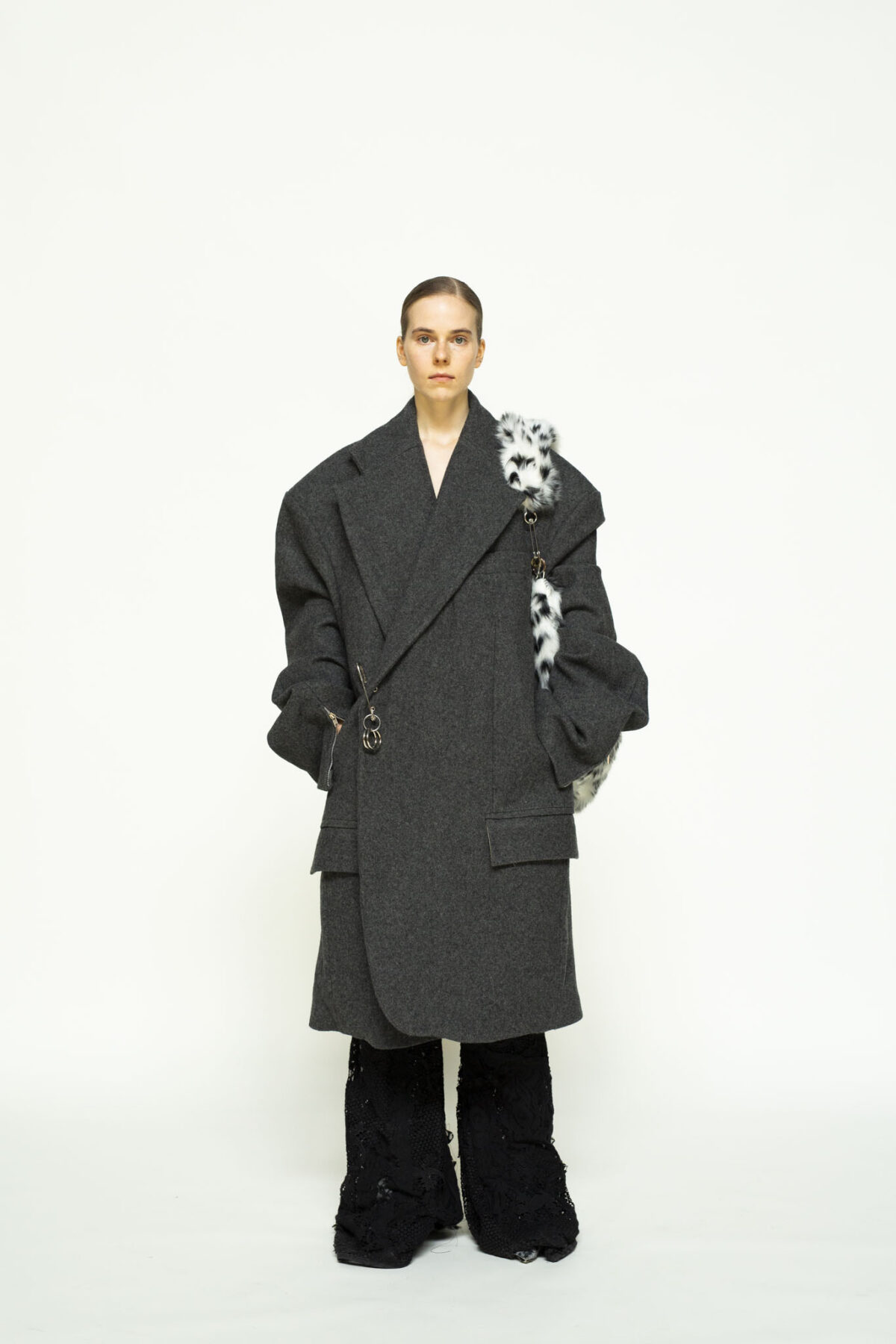 MW_01
MW_01

Mette Wik BA Graduate collection Photographer: Sofia Okkonen
MW_01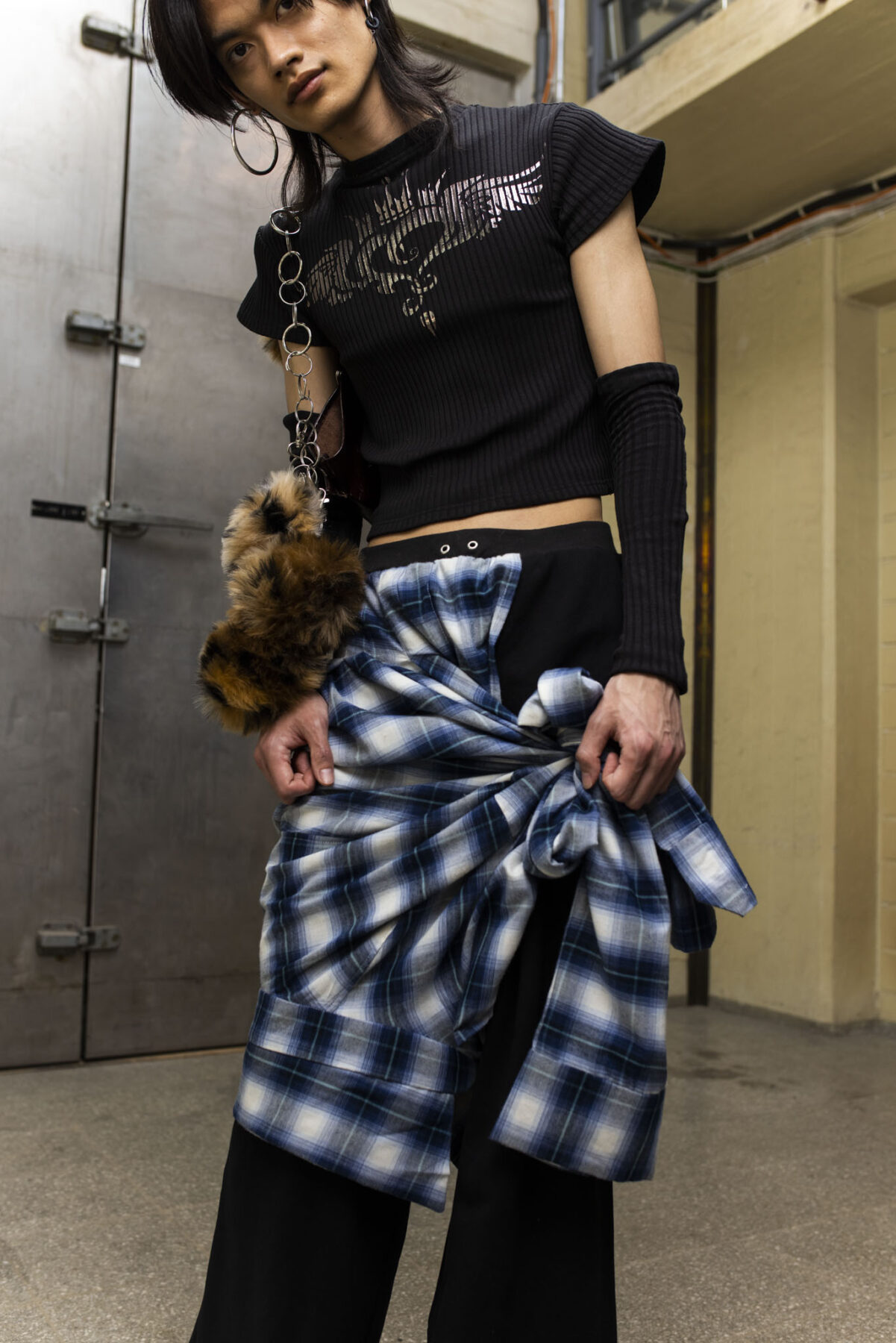 MW_02
MW_02

Mette Wik BA Graduate collection Photographer: Sofia Okkonen
MW_02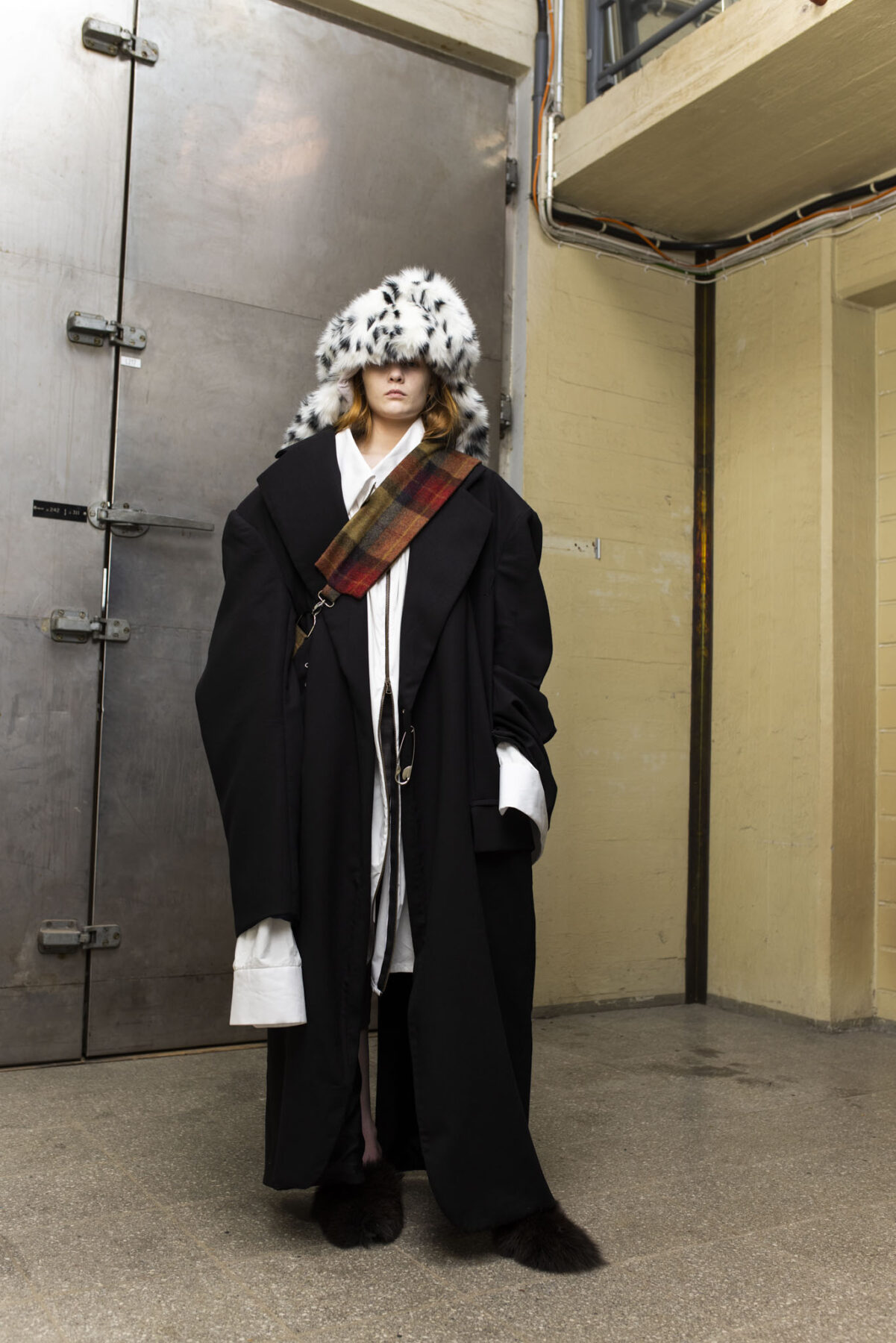 MW_03
MW_03

Mette Wik BA Graduate collection Photographer: Sofia Okkonen
MW_03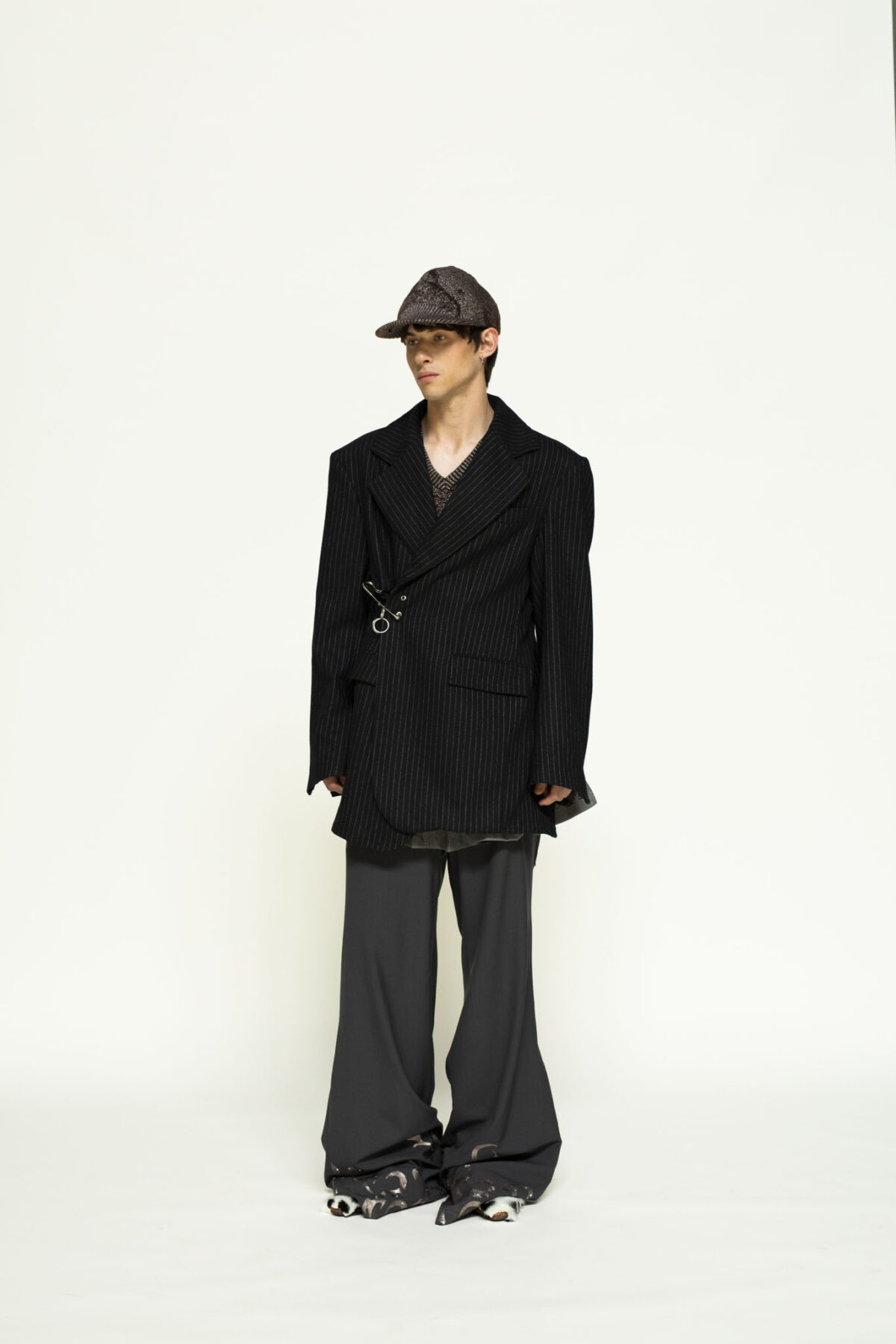 MW_04
MW_04

Mette Wik BA Graduate collection Photographer: Sofia Okkonen
MW_04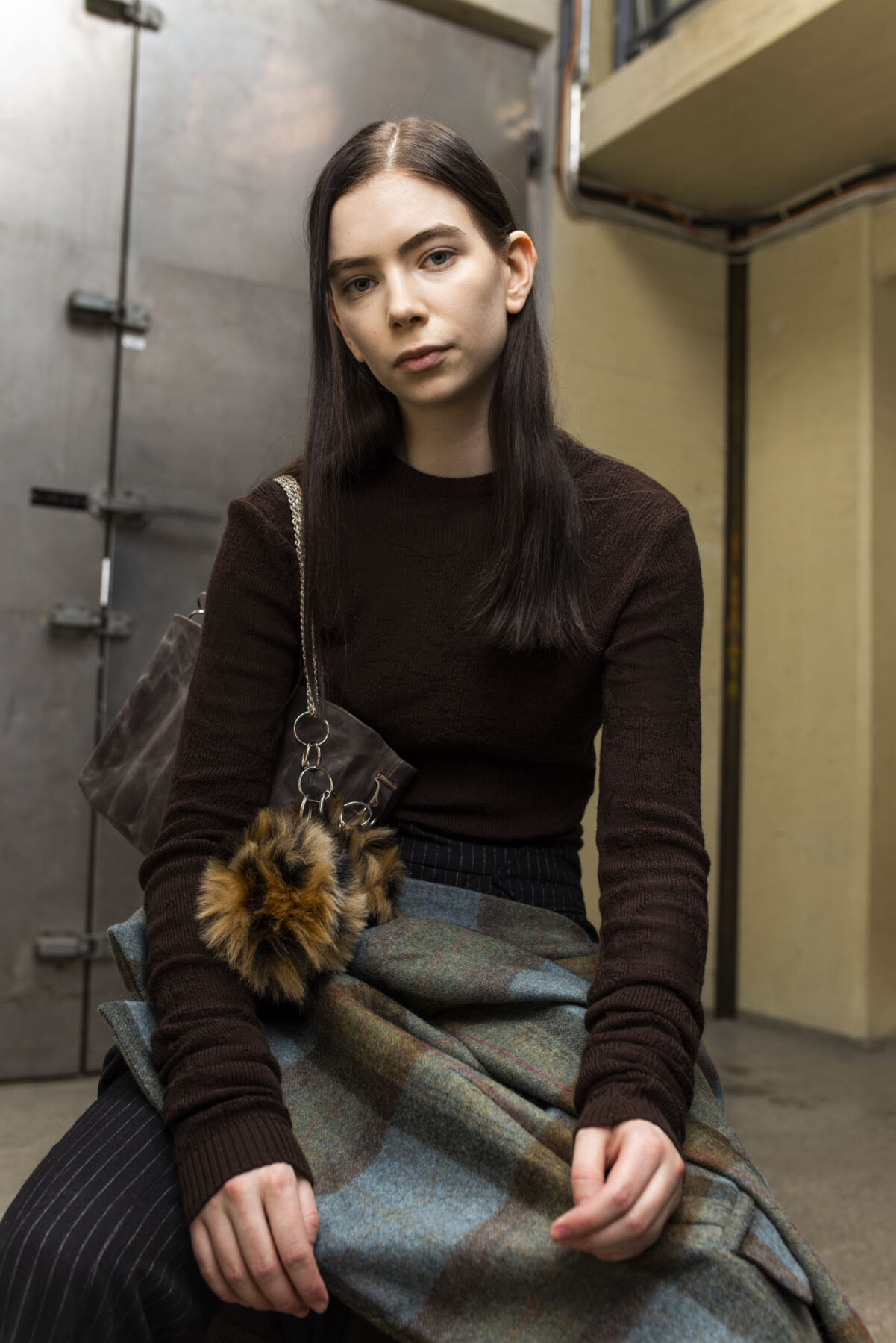 MW_05
MW_05

Mette Wik BA Graduate collection Photographer: Sofia Okkonen
MW_05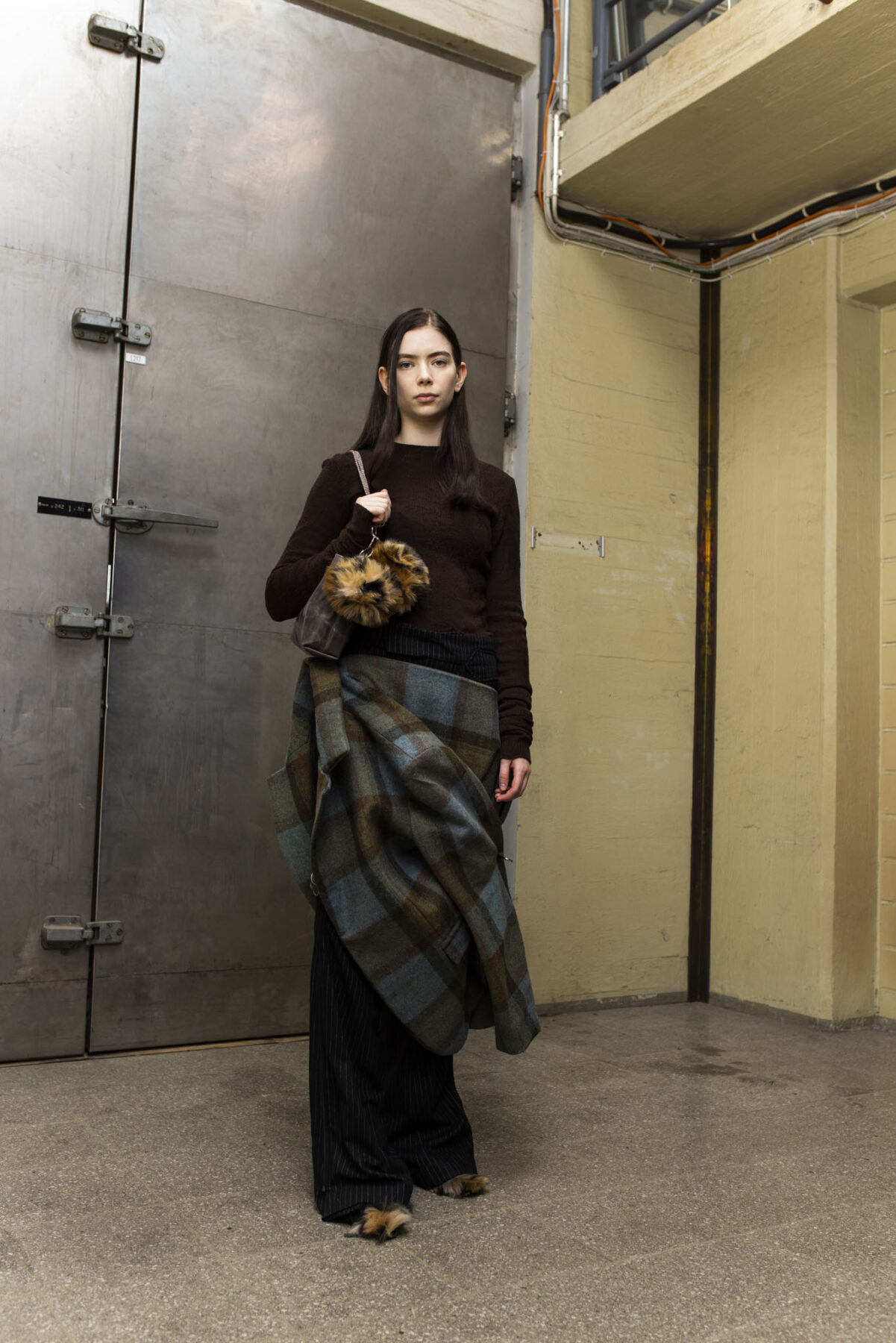 MW_06
MW_06

Mette Wik BA Graduate collection Photographer: Sofia Okkonen
MW_0660/40: LOST IN TRANSLATION
In her graduate collection, Mette Wik explores her experience of the language barrier encountered during her studies at Aalto University as a Swedish-speaking Finn.
– I feel that I can communicate up to 60 % in Finnish, whereas the remaining 40 % gets lost in translation, and this is what I wanted to address in my graduate collection, Wik explains.
The language barrier is an example of a flaw that is invisible to the naked eye, but which nonetheless presents a crack in the otherwise smooth facade. Both language and clothing are part of the image we build of ourselves, contributing to our communication through an often a polished exterior. Even though language itself is not visible, Wik believes there are connections between language, or the lack thereof, and the visual. Finnish has become Wik’s verbal school uniform during her studies, leading her to examine communication problems and misunderstandings through the lens of the classical school uniform, as well as through her own quasi-uniforms from her childhood years in the elementary school.
– I want to emphasize the feelings of vulnerability and frustration, as well as the awkwardness and humor that arise when trying to make oneself understood in a language other than one’s mother tongue. I aim to translate the experience of communication problems into something visible and tangible.
Wik deconstructs and mixes the tailored with the draped, the mature with the childish, in the pursuit of an expression lacking uniformity and collective consensus. By adding a zipper to the back of a blazer that allows seeing the body, or wearing the blazer as a skirt, the uniformity of the garment is deconstructed along with its previous associations. The fit of the garment is intended to be somewhat awkward, almost theatrical; in other words, the clothes will either be oversized to create the effect of clothes to hide in, or small and close-fitting to show skin and expose.
– Claustrophobic clothes can be linked to the feeling of having too limited a vocabulary. My collection is a celebration of those who are not afraid to speak even if they only know 40 % of the language and may hence feel inadequate.
Contact information:
Mette Wik
+358 504000855
Lauri Greis
(ba)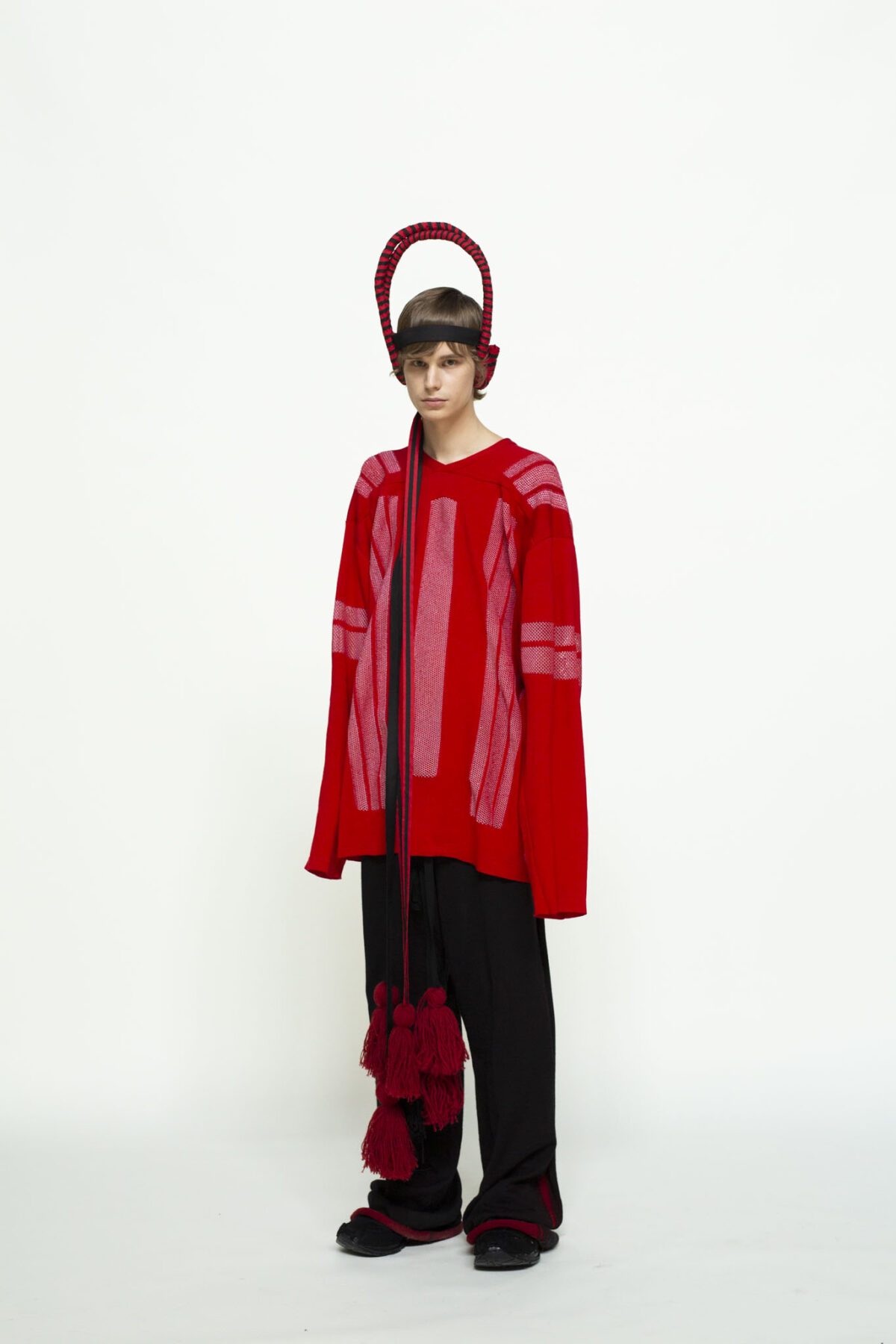 LG_01
LG_01

Lauri Greis BA Graduate collection Photographer: Sofia Okkonen
LG_01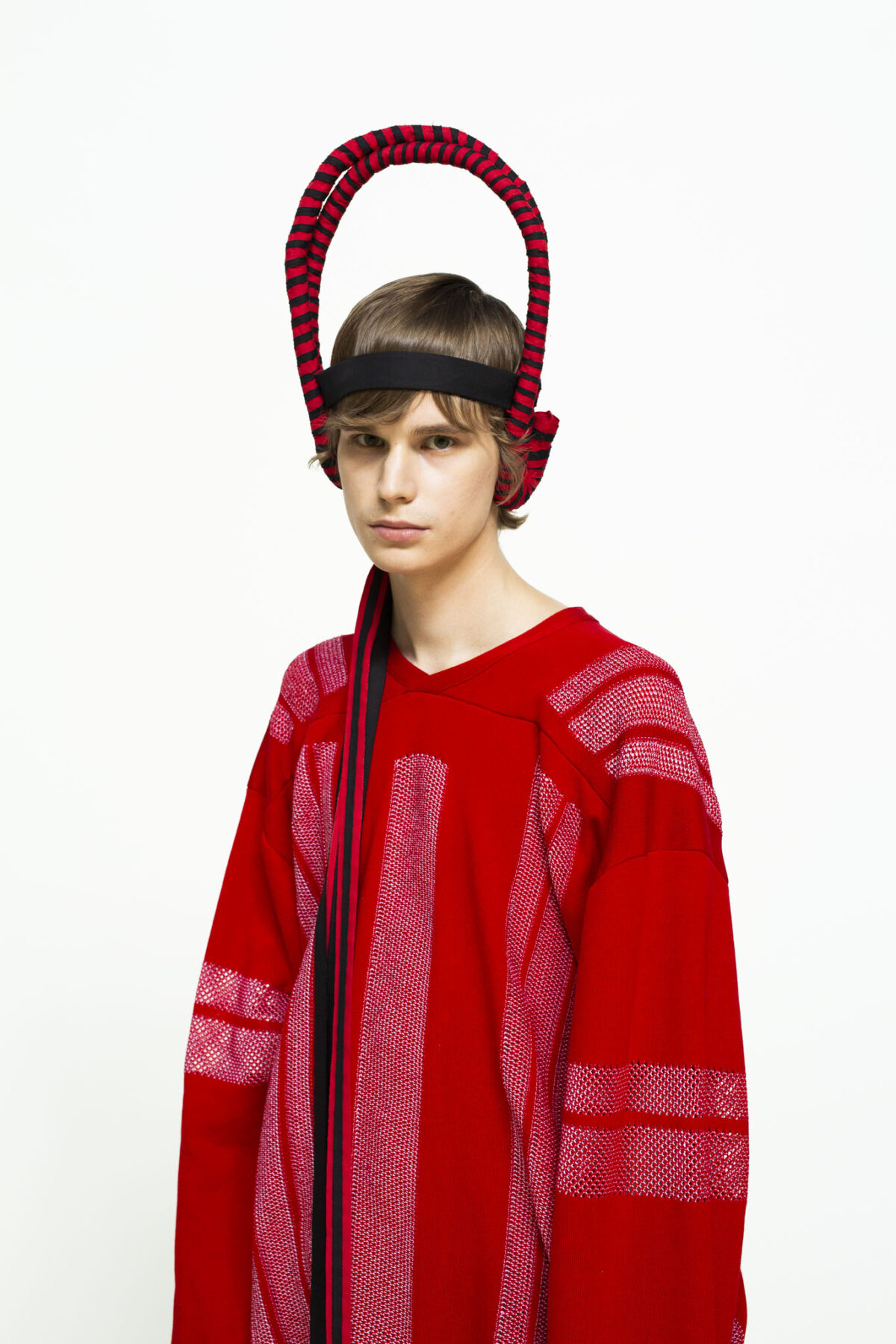 LG_02
LG_02

Lauri Greis BA Graduate collection Photographer: Sofia Okkonen
LG_02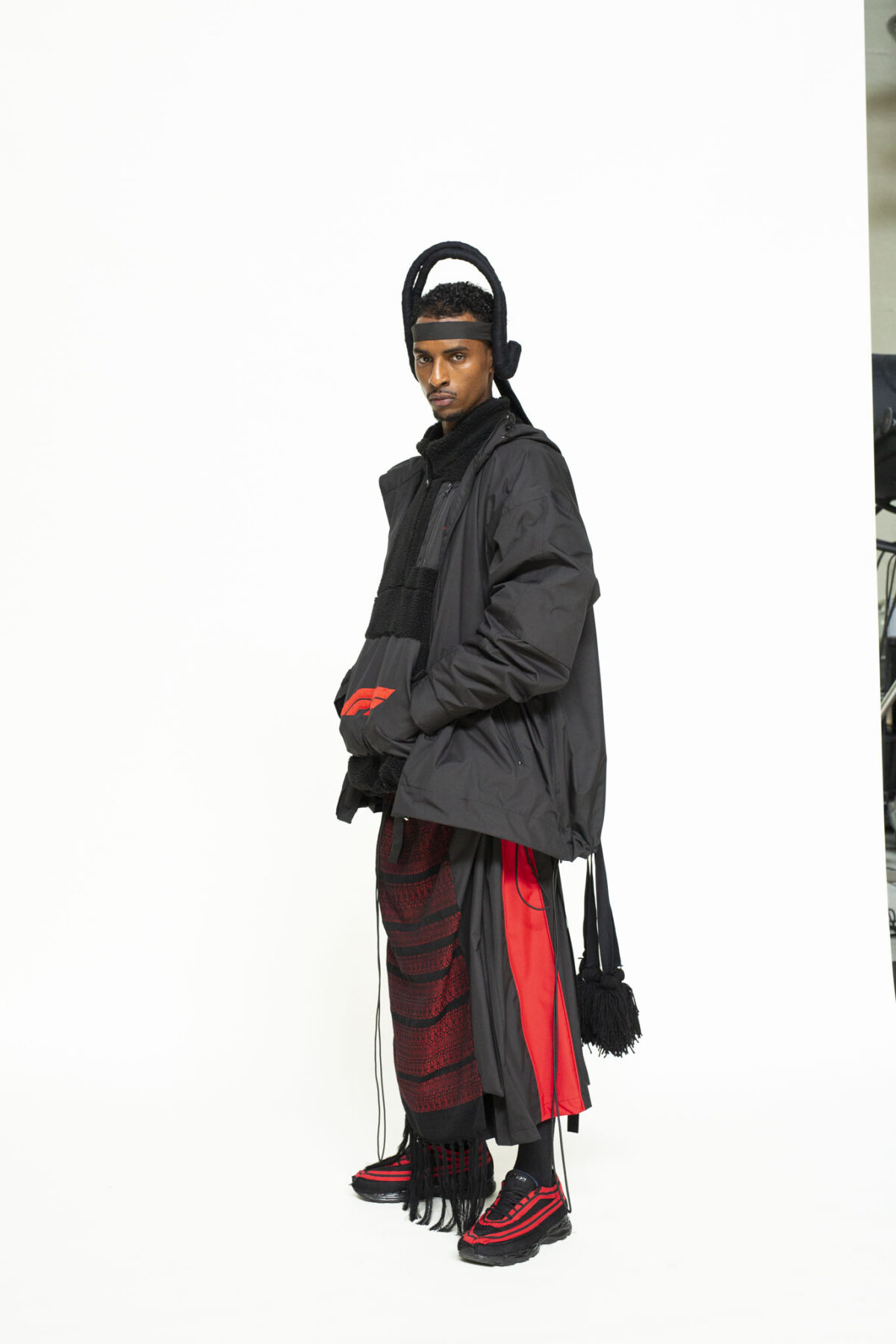 LG_03
LG_03

Lauri Greis BA Graduate collection Photographer: Sofia Okkonen
LG_03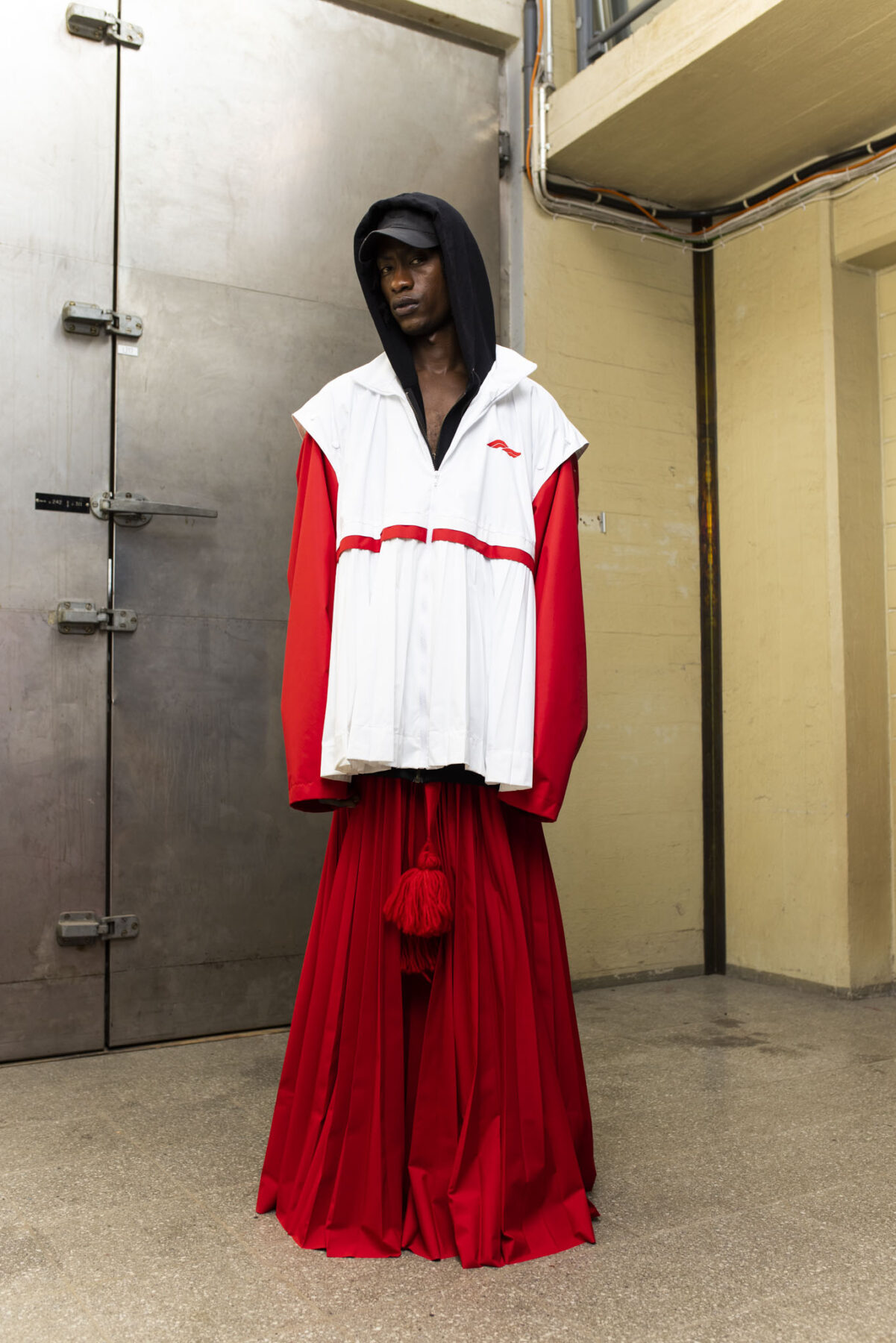 LG_04
LG_04

Lauri Greis BA Graduate collection Photographer: Sofia Okkonen
LG_04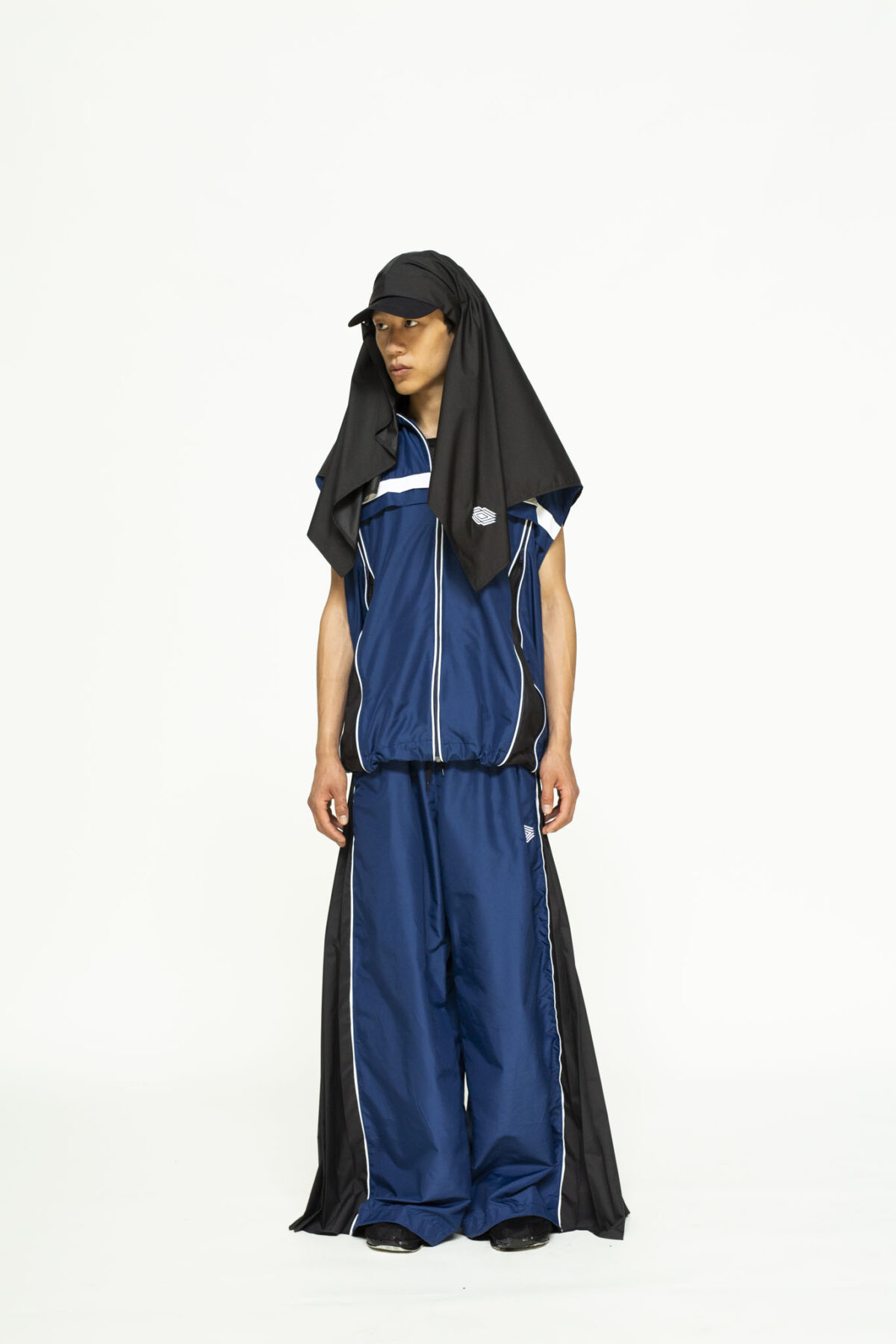 LG_05
LG_05

Lauri Greis BA Graduate collection Photographer: Sofia Okkonen
LG_05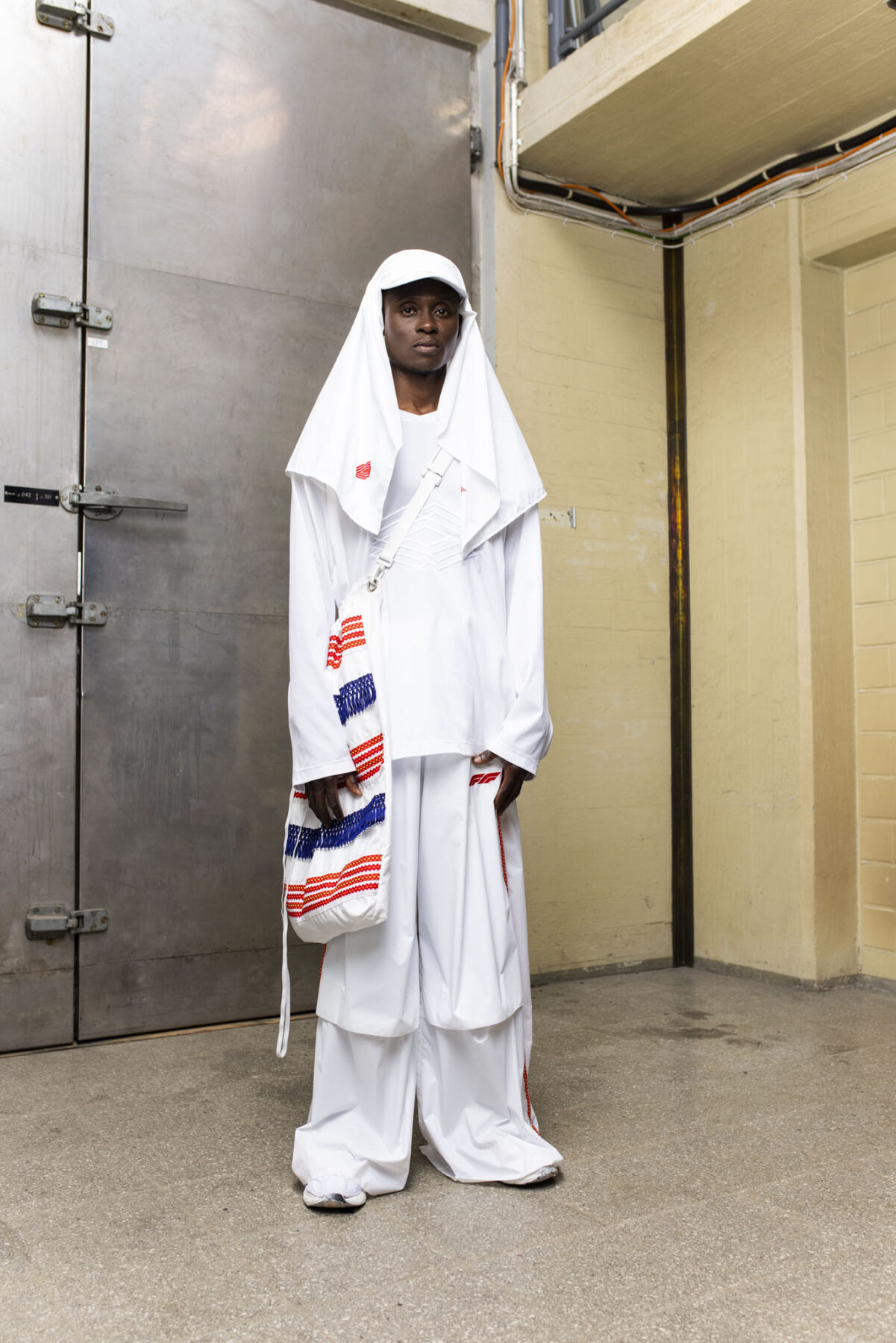 LG_06
LG_06

Lauri Greis BA Graduate collection Photographer: Sofia Okkonen
LG_06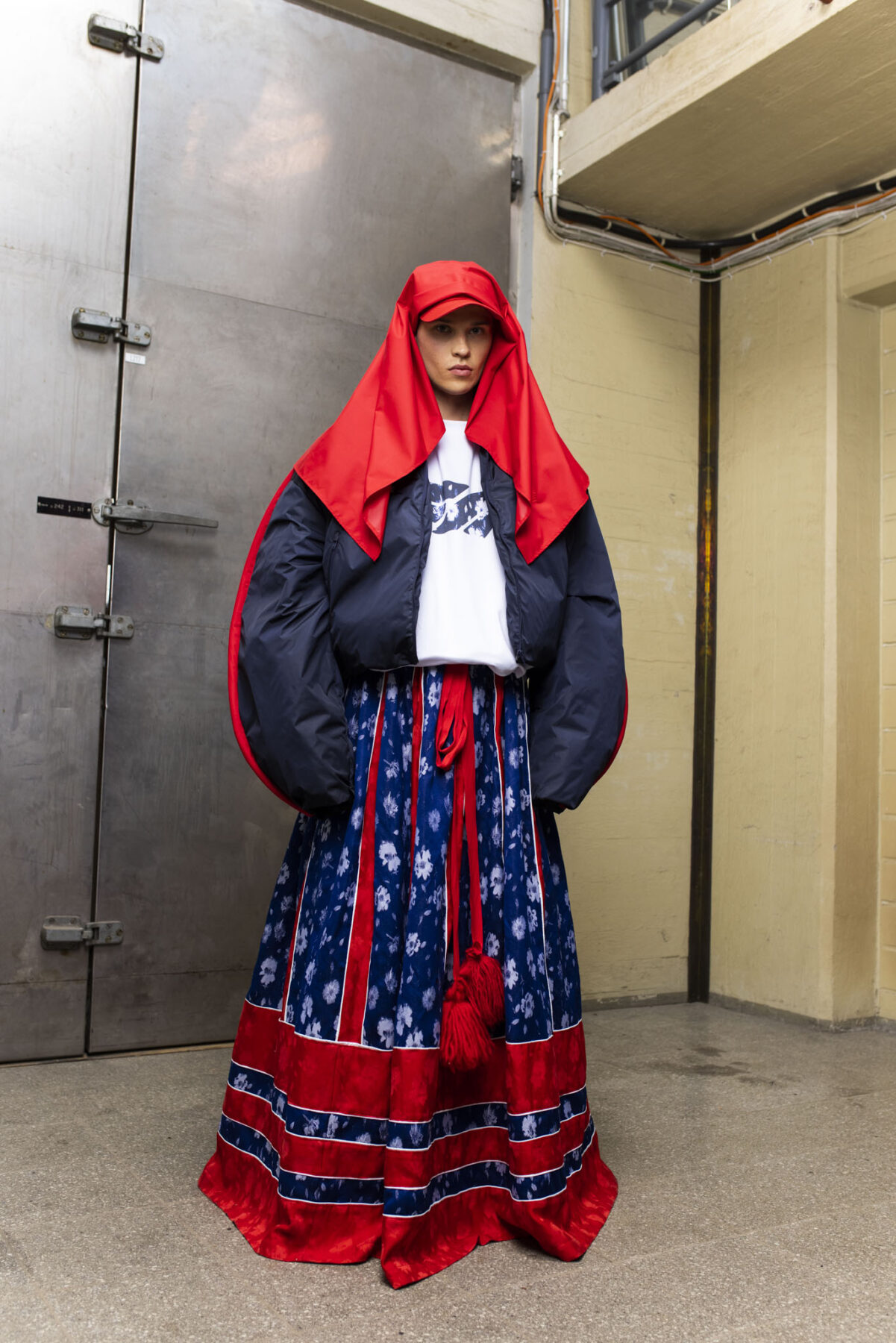 LG_07
LG_07

Lauri Greis BA Graduate collection Photographer: Sofia Okkonen
LG_07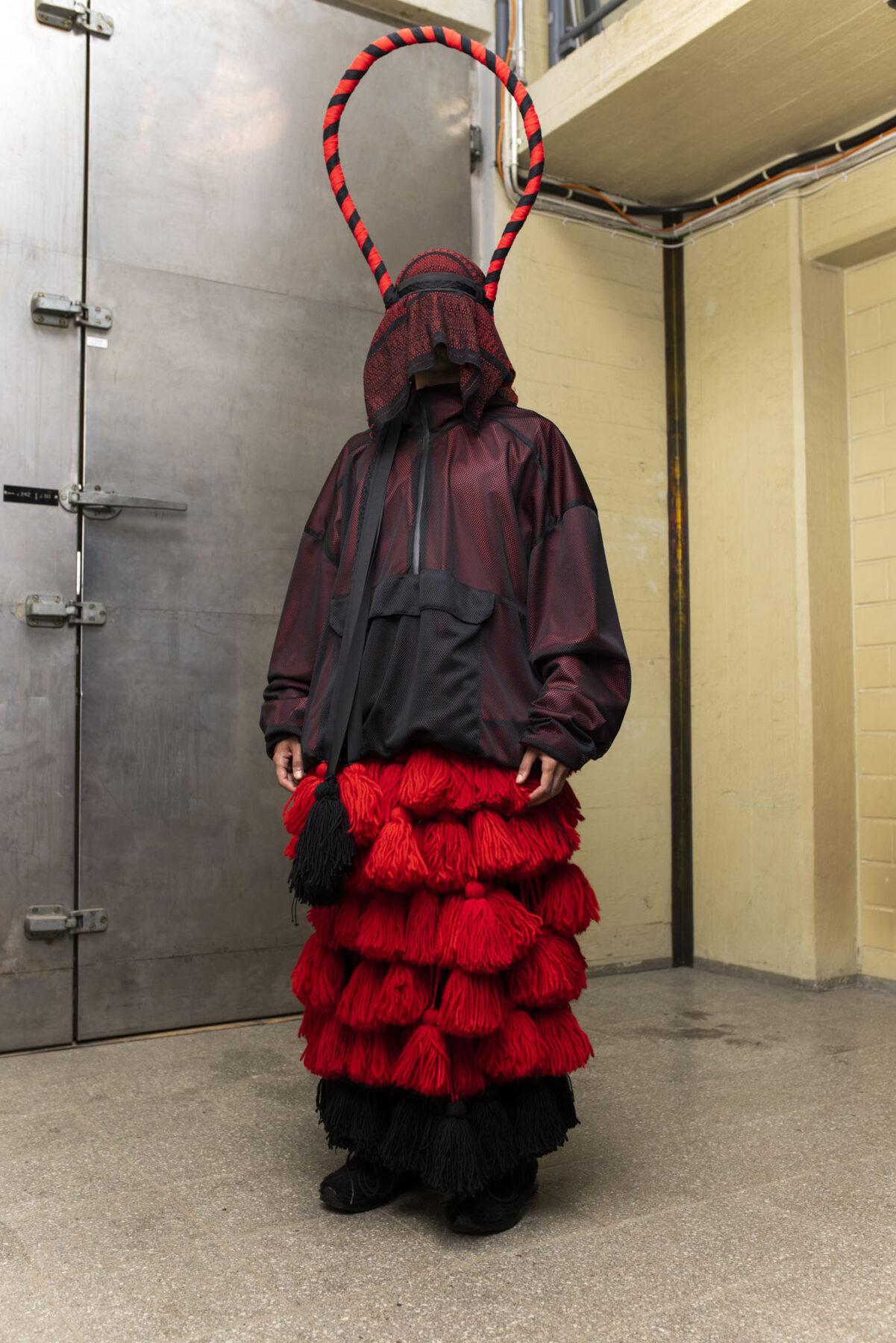 LG_08
LG_08

Lauri Greis BA Graduate collection Photographer: Sofia Okkonen
LG_08Karelian Sportlore
In his BA collection Lauri Greis combines elements from the Karelian national costume with modern sportswear. The idea came to be when Greis received his grandmother’s old Antrean national costume. The collection is strongly based on academic research: Greis has studied Finnish romantic nationalism, history and functions of Finnish folk dresses and national costumes. The sportwear element on the other hand represents contemporary Finnish identity, suggesting that sportwear is the modern version of the folk dress. This is not far-fetched: Finns are often ironically described as “shell suit people”, referring to Finland as a nation where everyone wears sporty clothes.
– Education is an intrinsic value for me. I like to learn about new things and always try to see the bigger picture. This collection is a fantasy-like self-portrait based on history, ethnography and my memories of 00’s sportswear. The mission of the collection is to explore my roots, after all, the collection is a tribute to my grandmother, Greis says.
Folk dress is a functional ensemble consisting of shirts, vests, skirts and aprons. The collection includes similar garments while the connection to sportswear is created by using technical fabrics and familiar details such as stripes, pleating and embroidery.
– National costume is an interesting piece of clothing. First of all, it feels timeless but in reality, it is a reconstruction of the 18th and 19th century folk dress. Secondly, folk dress has been seen as static and anti-fashion even though the dress has changed and affected fashion as well, Greis explains.
He also says that even though the fashion context has given him freedom of interpretation he also feels great responsibility as a designer.
– I have landed quite far from the original Antrean national costume since I wanted to do my own interpretation of it. Simultaneously I have also wanted to pay tribute to it and avoid misinterpreting let alone misappropriating the original costume.
Essential techniques in the collection include jacquard-weaving, industrial knitting and technical details deriving from functional wear. For traditional handcraft techniques Greis has studied woven structures, tassels and pleating used in folk dresses. Greis’s process-based working method means using textile design as a means to explore appropriate tones for the collection.
– Working with this project has been rewarding. I love folk dresses as much as I love big jackets and loose trousers, but I don’t see them as the core of my designer identity. I think I could design anything. Every garment and all the textiles are different and there are always specific demands and problems to solve.
Contact information:
Lauri Greis
lauri.greis@aalto.fi
+358 44 922 7615
@laurigreis.foodsandfashion
Joona Hakala
(ma)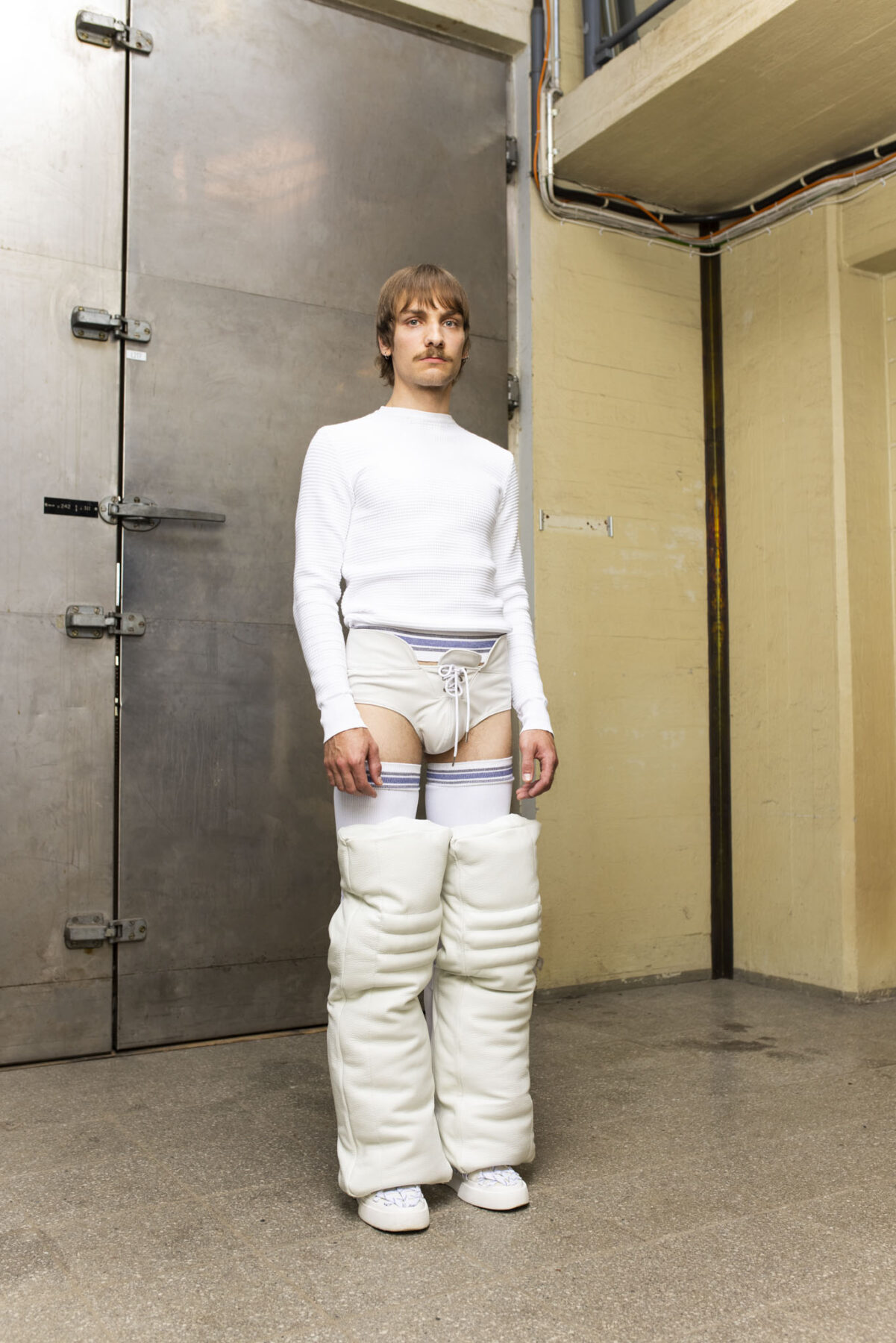 JH_01
JH_01

Joona Hakala MA Graduate collection Photographer: Sofia Okkonen
JH_01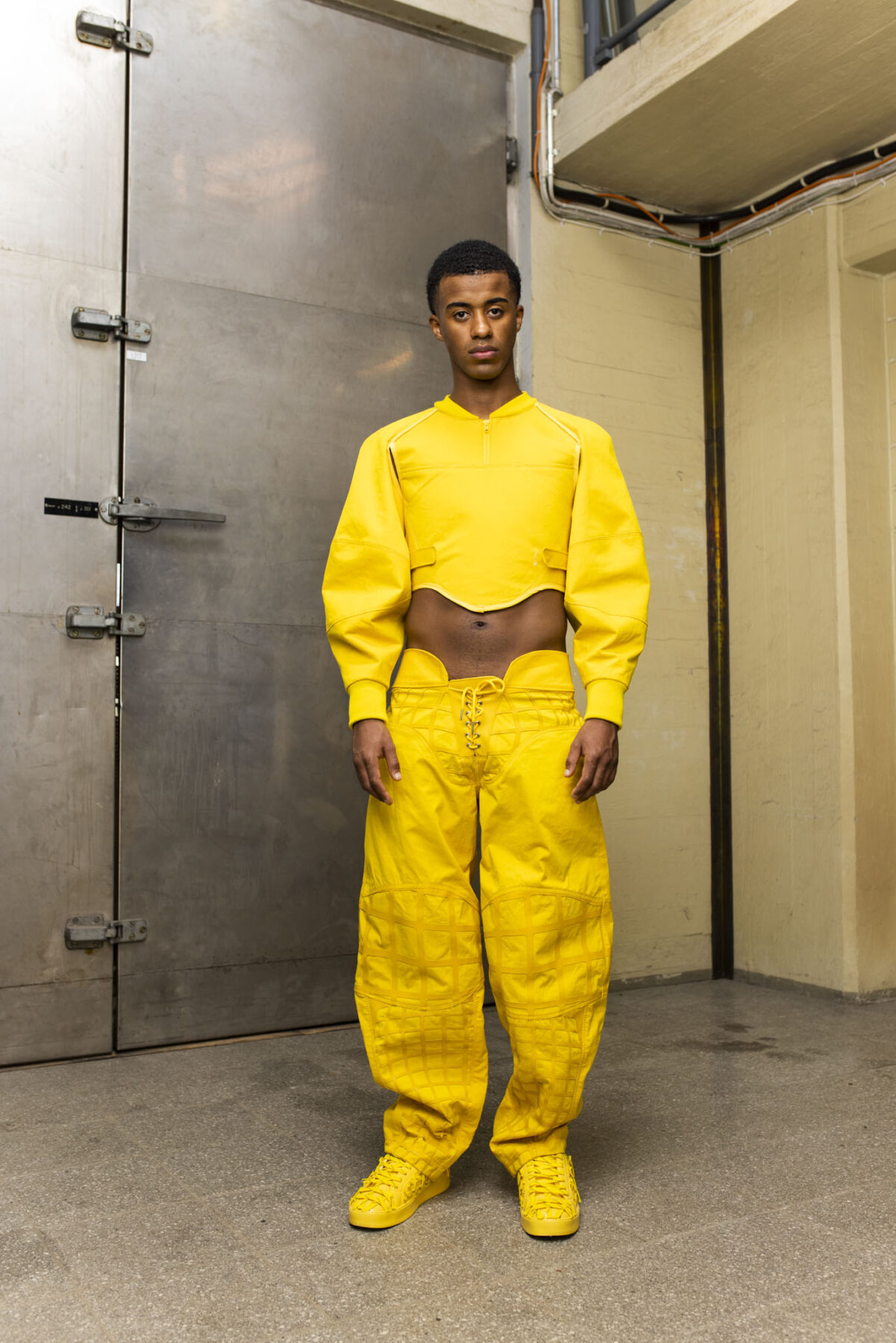 JH_02
JH_02

Joona Hakala MA Graduate collection Photographer: Sofia Okkonen
JH_02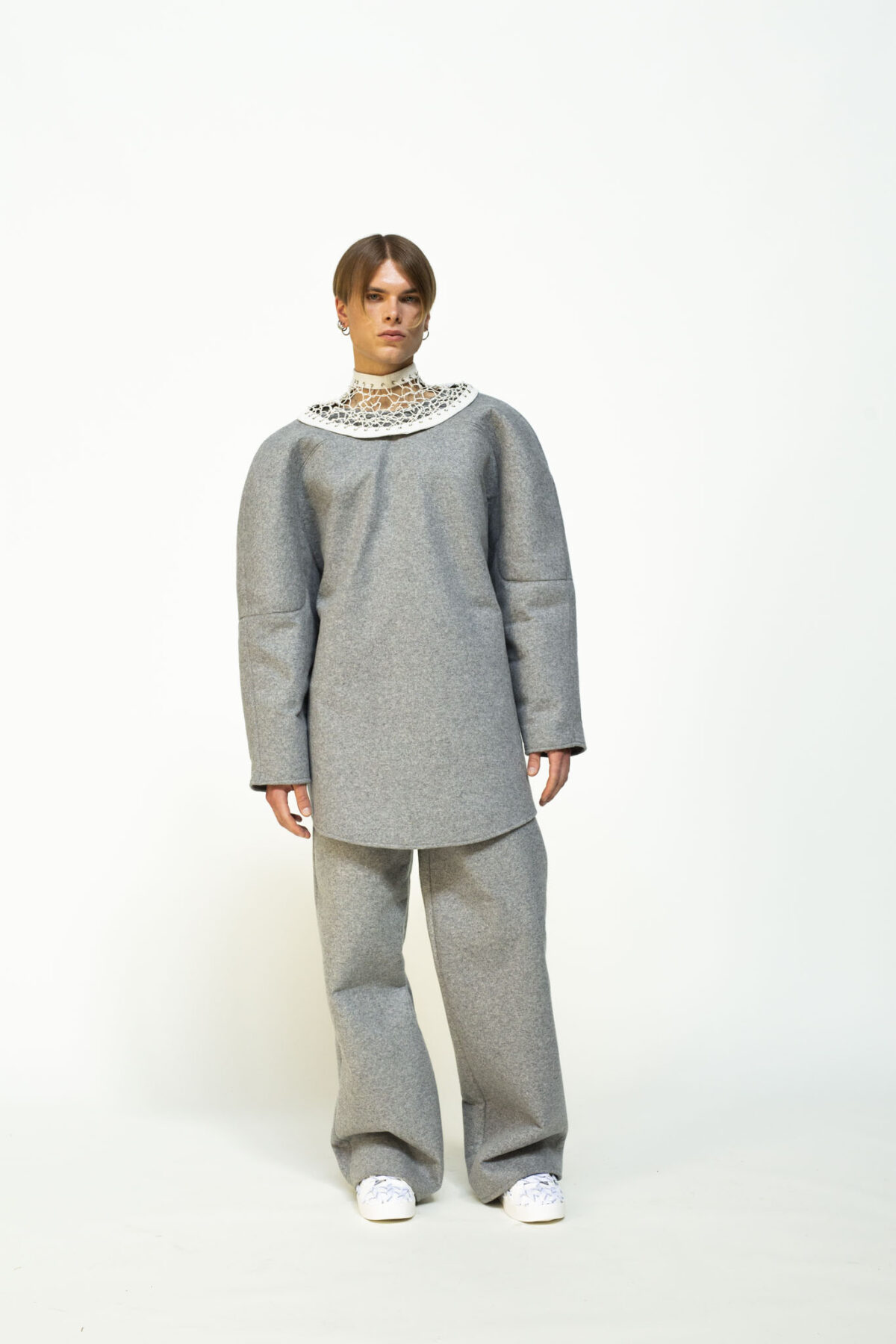 JH_03
JH_03

Joona Hakala MA Graduate collection Photographer: Sofia Okkonen
JH_03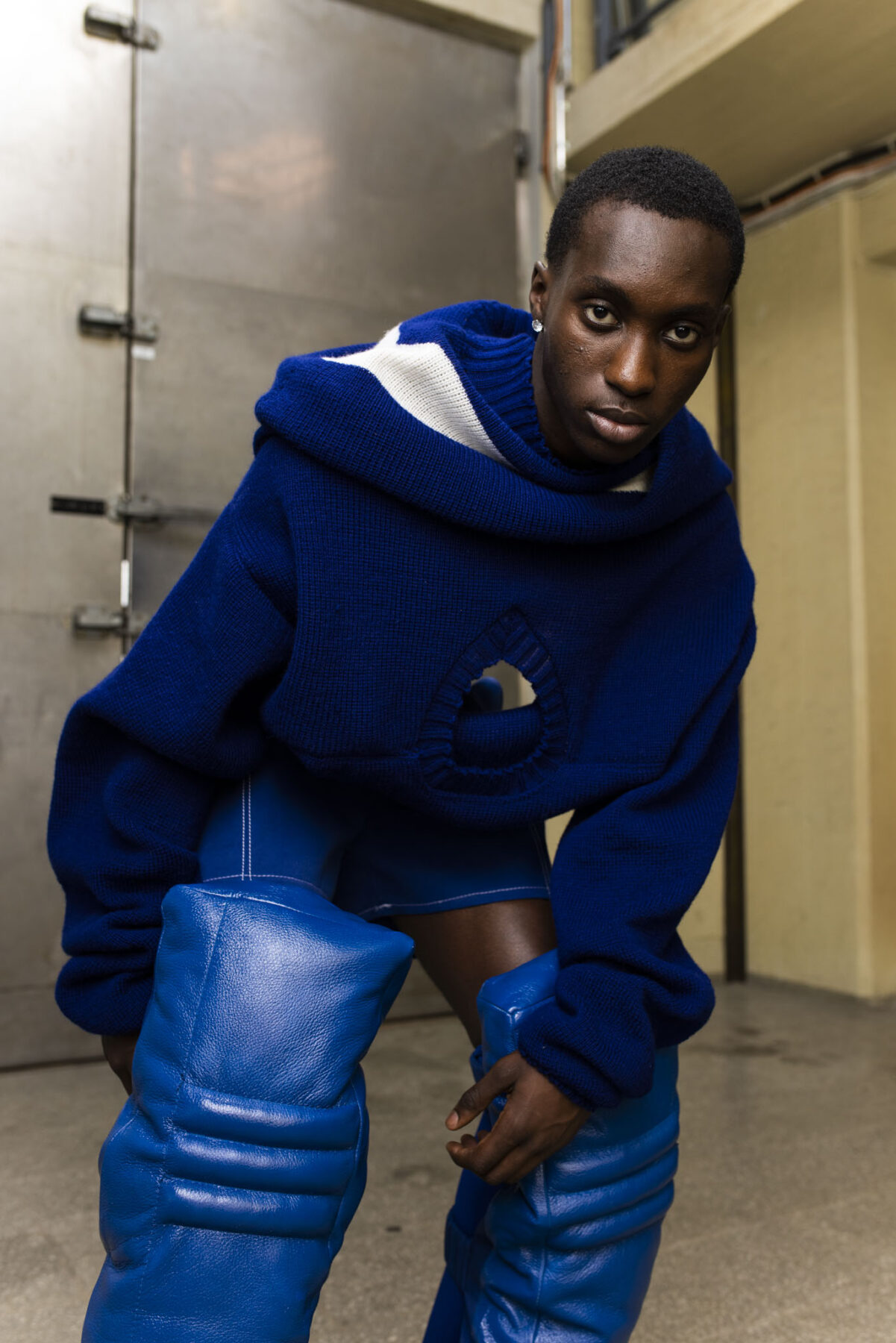 JH_04
JH_04

Joona Hakala MA Graduate collection Photographer: Sofia Okkonen
JH_04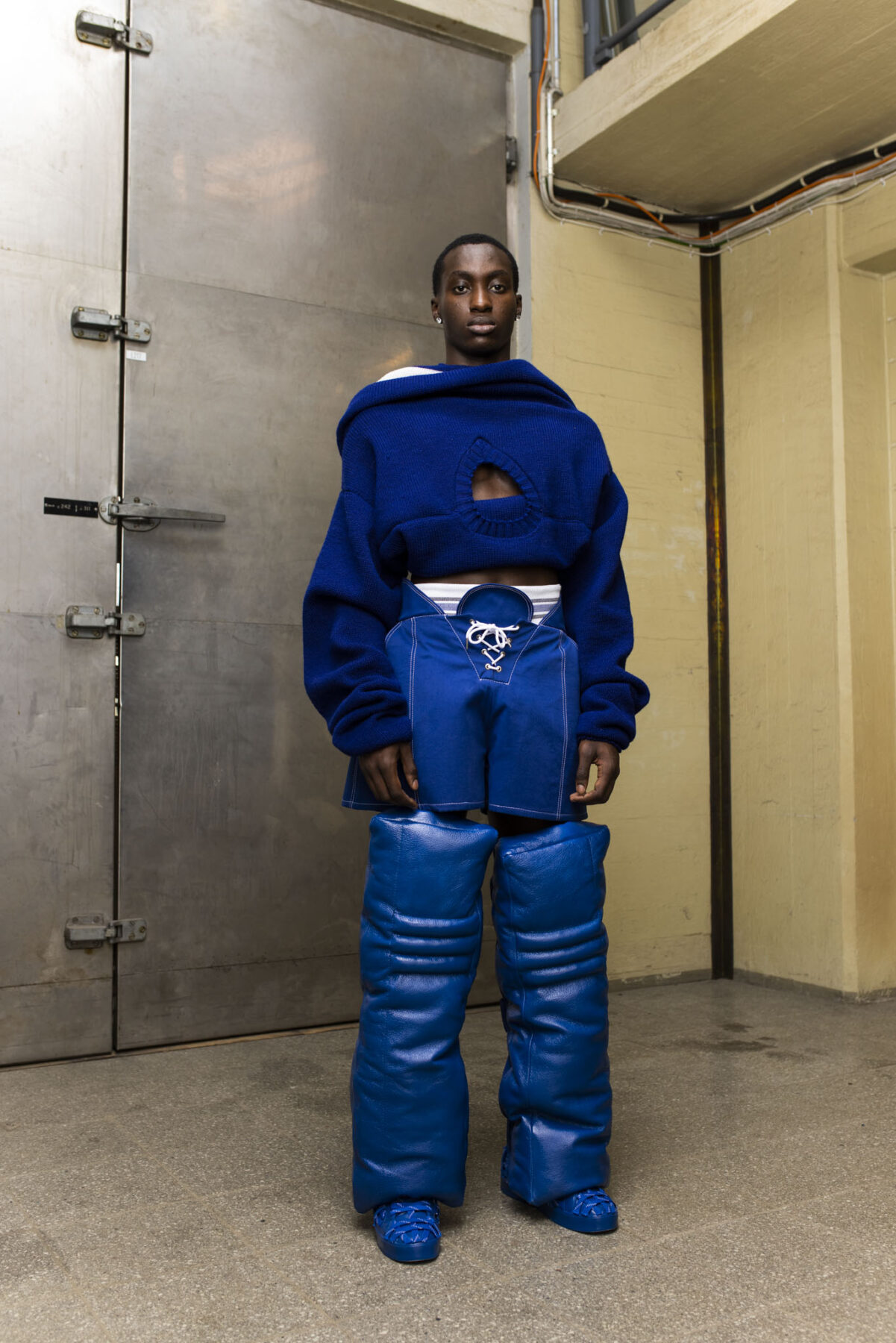 JH_05
JH_05

Joona Hakala MA Graduate collection Photographer: Sofia Okkonen
JH_05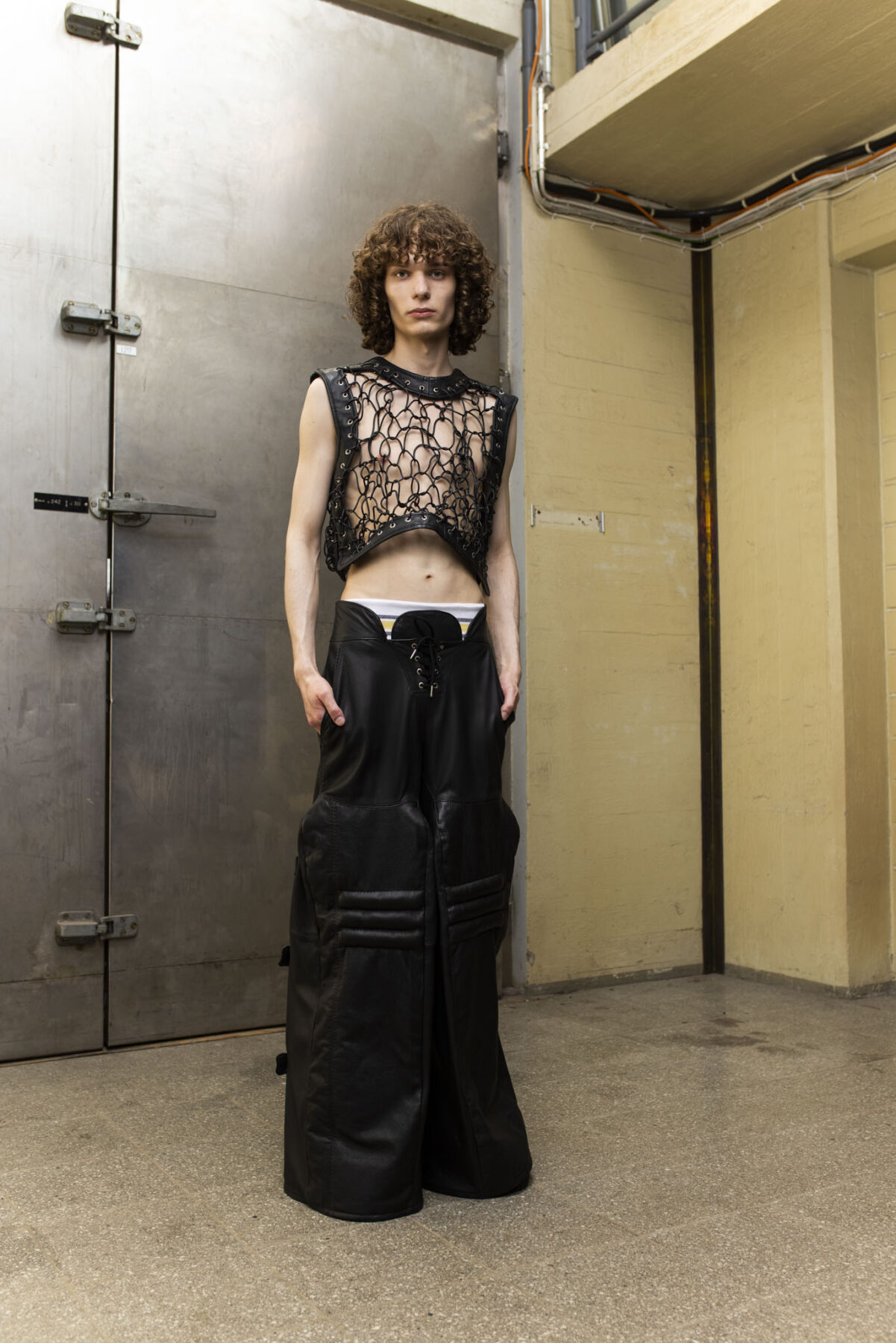 JH_06
JH_06

Joona Hakala MA Graduate collection Photographer: Sofia Okkonen
JH_06“He Shoots! He Scores!”
– As a queer man the world of sports has always presented itself for me in two contrasting ways. On one hand, it embodies overtly masculine environment which often excludes people like me but on the other hand, its display of certain kind of masculinity has become a stable part of gay iconography. This paradox inspired me to create my collection, Joona Hakala tells.
His graduate collection draws inspiration from ice hockey, exploring the shapes and details of the hockey player’s uniform combining it with queer imagery.
– My visual research included Stanley Stellar’s photography and gay erotica. It was fascinating to see how men were presented, what was shown and what was hidden and what is considered “sexy” in the context, and I tried to bring that feeling to my collection.
In addition, object analysis was an important part of the process as it served as a way to examine the details and the feeling of the ice hockey equipment and the materials the clothes are made of. The silhouettes and the cuts in the equipment became the starting point for patternmaking. With the selected materials like wool, cotton, and leather Hakala wanted the collection to feel like actual clothes rather than sportswear. Besides these, the collection includes knit mimicking jockstraps material which is yet another gay erotica staple and netting from the goal keeper’s glove.
The collection seeks to deconstruct the concept of hegemonic and heteronormative masculinity prevalent in sports culture. Doing so, it aims to challenge these conventional notions and celebrate the diversity of masculinity and sexuality.
Contact information:
Joona Hakala
(+358) 050 911 4510
@jonttuli
Johannes Ahlfors
(ma)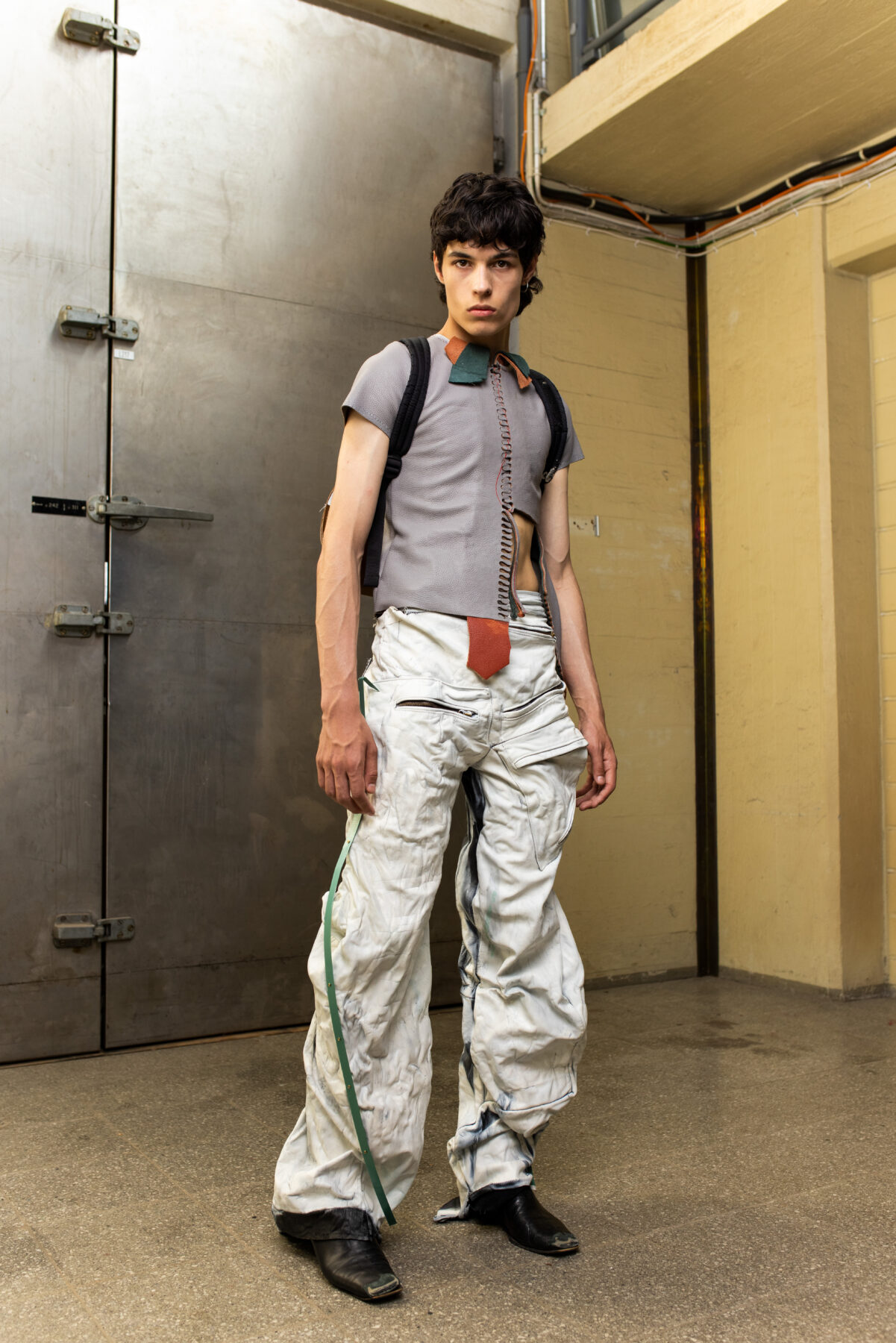 JA_01
JA_01

Johannes Ahlfors MA Graduate collection Photographer: Sofia Okkonen
JA_01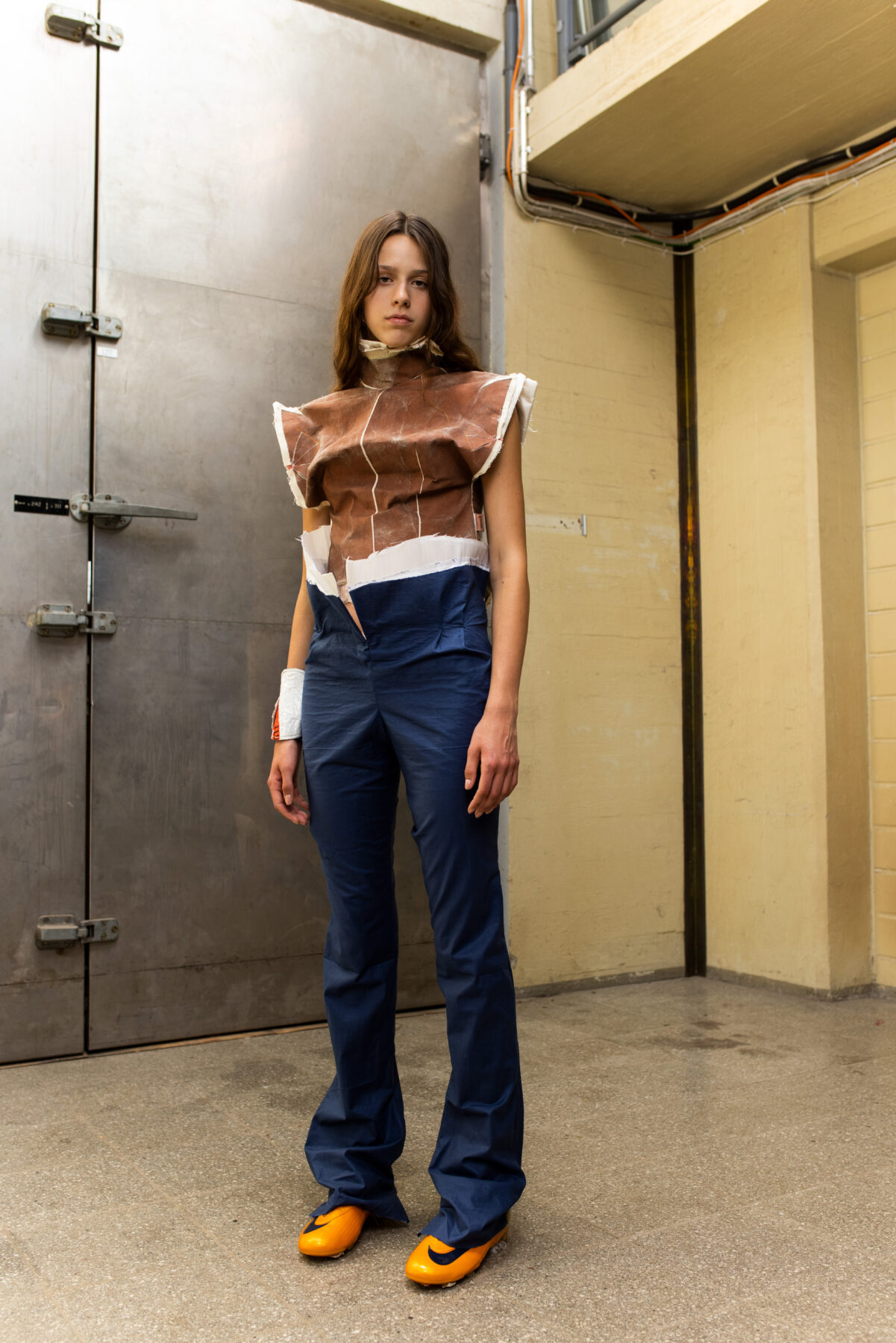 JA_02
JA_02

Johannes Ahlfors MA Graduate collection Photographer: Sofia Okkonen
JA_02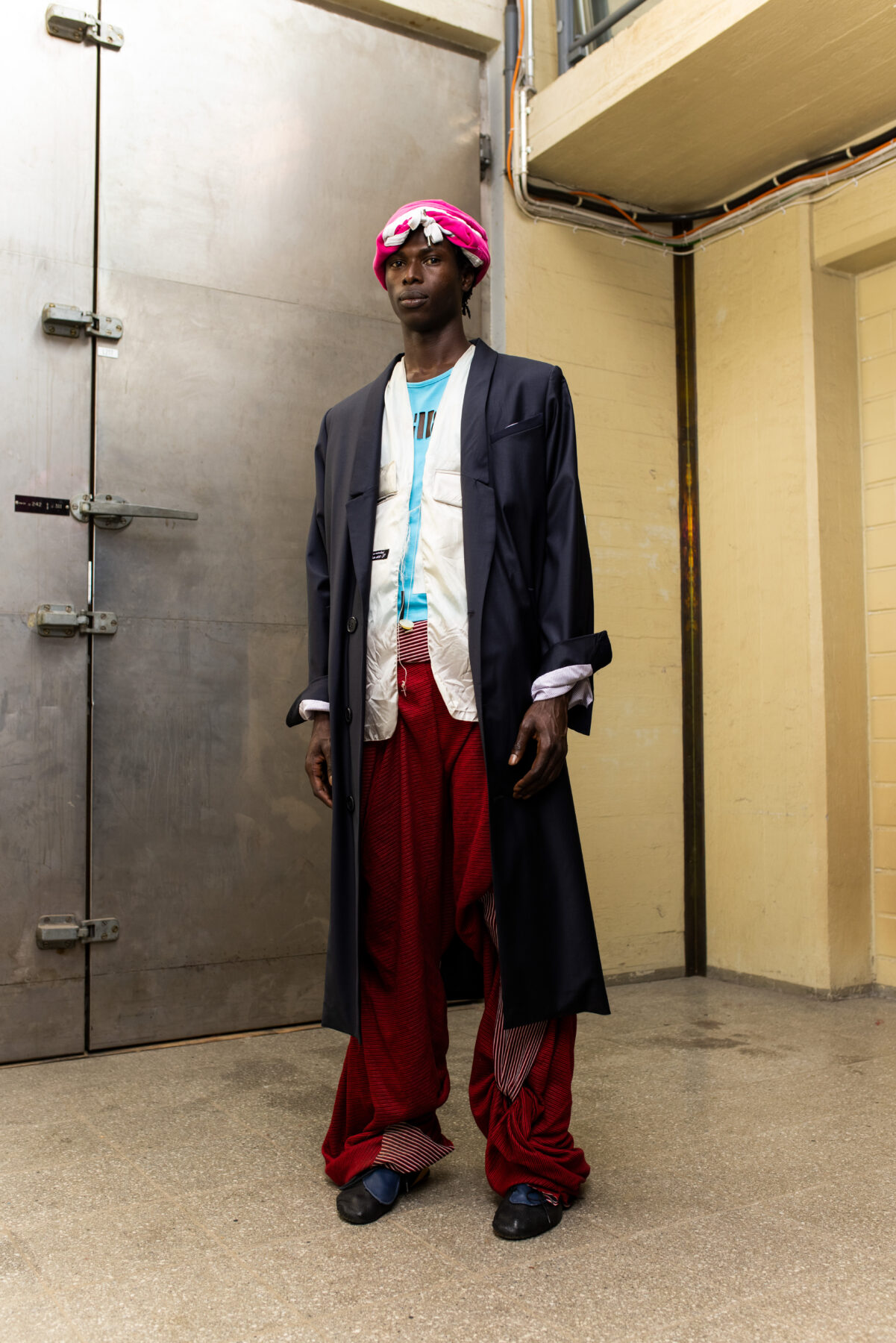 JA_03
JA_03

Johannes Ahlfors MA Graduate collection Photographer: Sofia Okkonen
JA_03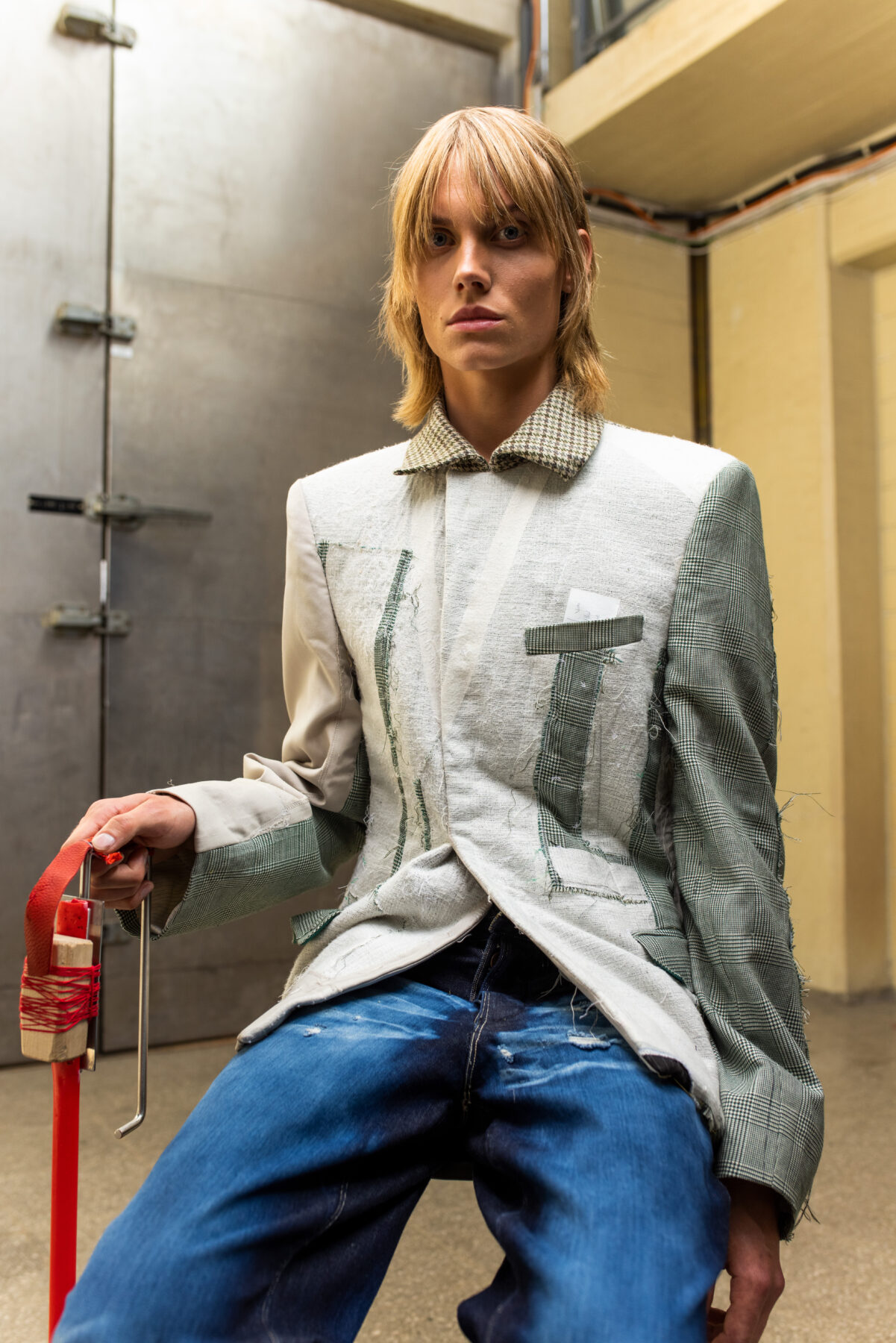 JA_04
JA_04

Johannes Ahlfors MA Graduate collection Photographer: Sofia Okkonen
JA_04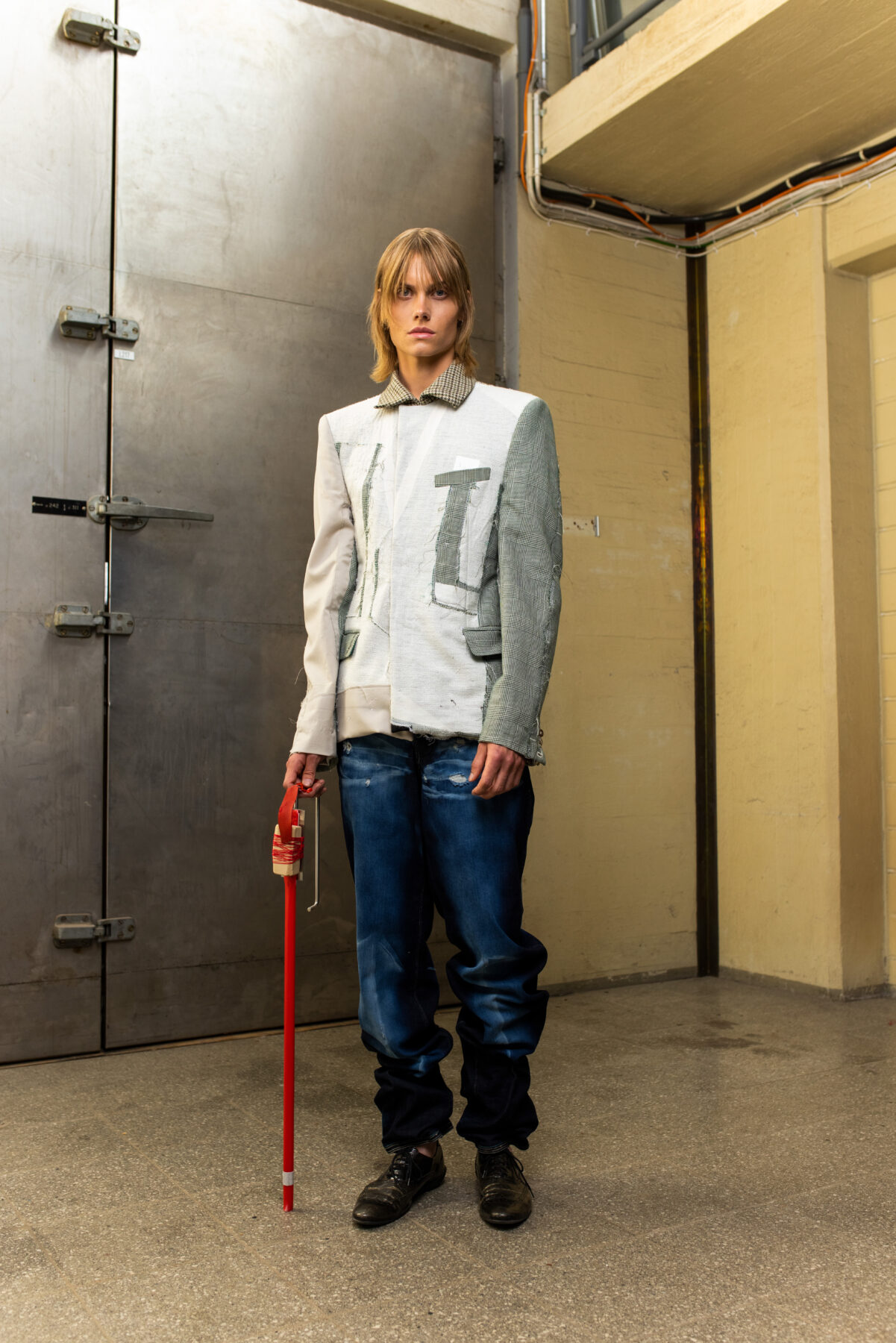 JA_05
JA_05

Johannes Ahlfors MA Graduate collection Photographer: Sofia Okkonen
JA_05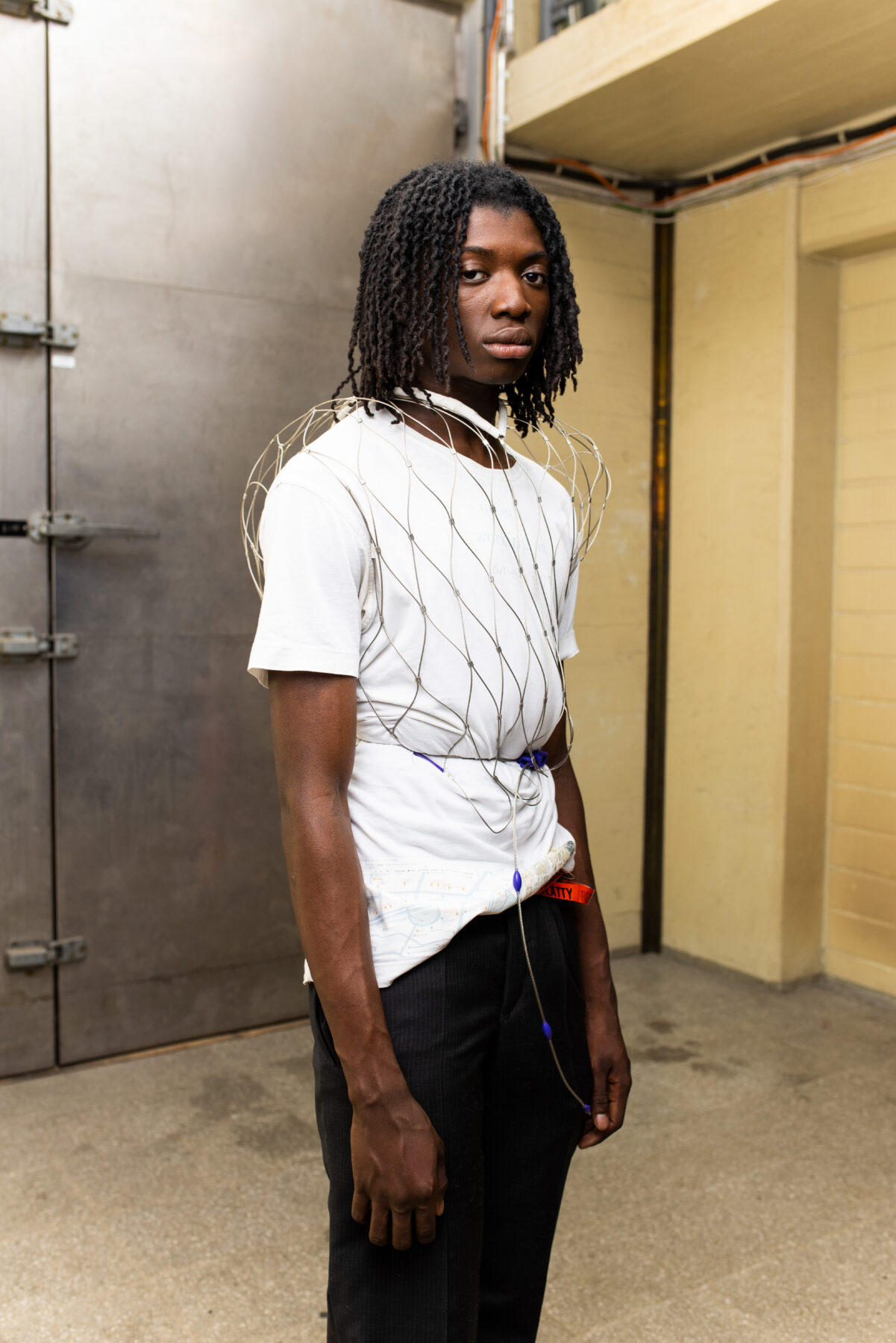 JA_06
JA_06

Johannes Ahlfors MA Graduate collection Photographer: Sofia Okkonen
JA_06 JA_07
JA_07

Johannes Ahlfors MA Graduate collection Photographer: Sofia Okkonen
JA_07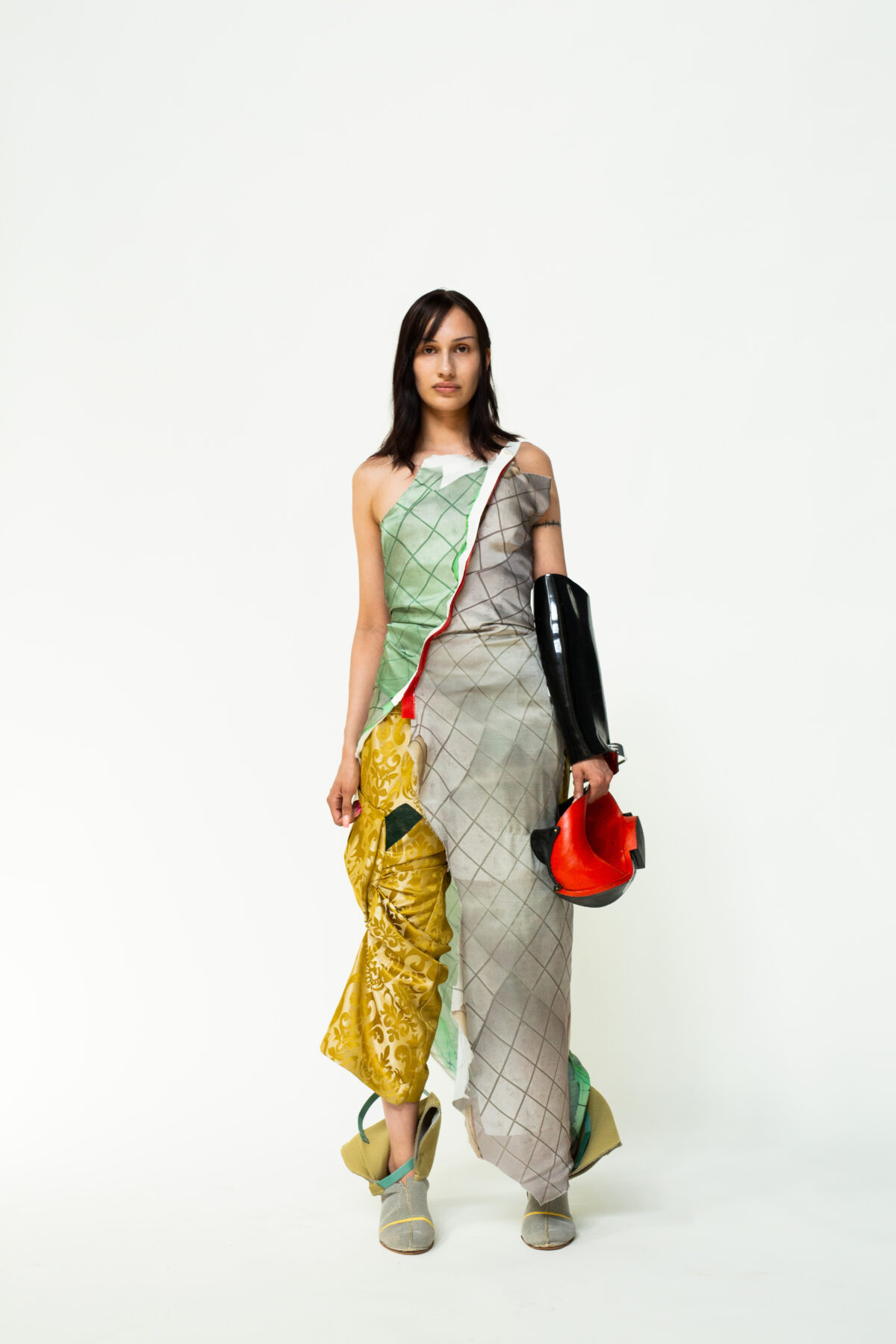 JA_08
JA_08

Johannes Ahlfors MA Graduate collection Photographer: Sofia Okkonen
JA_08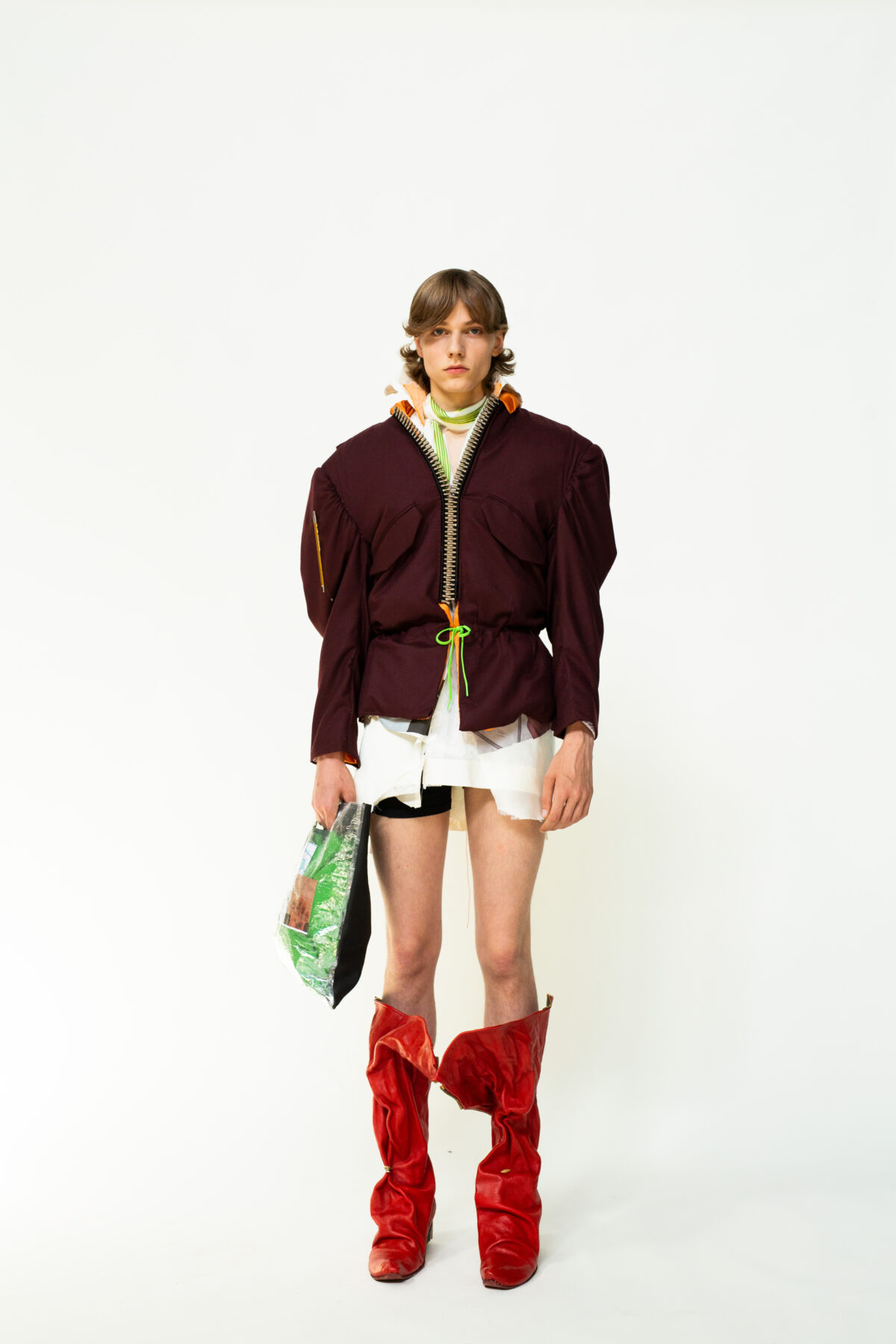 JA_09
JA_09

Johannes Ahlfors MA Graduate collection Photographer: Sofia Okkonen
JA_09Proto…typing
Often in creative projects, a predetermined theme or a concept is not as static as one would expect. Journey along a theory causes the theory itself to shift in new directions more often than not. Johannes Ahlfors has tried to reverse the roles of the chaser and the chased in his graduate collection.
– Rather than tracing a path towards a defined conceptual goal, I’m turning my back and hoping the concept starts following my actions, he states.
Ahlfors’ collection is constantly generating more and more material to communicate itself. The collection development started with an abstract idea of letting the products speak for themselves, he explains:
– I’ve often been reluctant to concretely define and position my work in strict frames, as in my view, words and other definitive symbols of communication always fail the initial idea and feeling that drives creative action.
Ahlfors’ work can be seen as a blank canvas where ideas and concepts are developed, ‘rejected’ or elaborated on, and this creative search for an underlying narrative is left visible onto the products themselves. Unfinished ideas and underdeveloped garments are worked on in different settings and from different perspectives, again and again, in order to develop a group of ‘enough-ready for exhibiting’ -objects that share similar material language.
– The first concept that stuck with me was the concept of a continuous prototype, where a prototype can be seen either as an object, as a thought, or as an act; main underlying properties are that prototyping is never finished, and that it always exists in a space of certain unclarity and uncertainty, a space I’ve attempted to inhabit for my own creative and communicative purposes, he says.
This prototypal orientation led the designer to a method of working where every part of the project was in constant flux; no one strict guide or manifesto is followed, rather all pieces go along their own paths.
– To make something experimental requires some level of confusion and vagueness of understanding for the maker as well. Any requirements for assertive all-encompassing theories for pieces of creative work defeats the purpose of experimental creation altogether, in my view.
In material terms, Ahlfors’s method manifests in objects that are elaborated on, again and again throughout the project, often resulting in detail-rich compositions that invite the viewer to interact more intimately with them. None of the products have a definitive finished state, rather new ideas can always be implemented onto already developed garments. Most of the collection is born out of repurposing found and used materials and trash, with clothing related inspiration leaning heavily to his own everyday wardrobe.
– My hope is to create objects that have their own, ‘To Be Continued…’, story to tell. This encourages more curious interaction between garments and humans.
Contact information:
Johannes Ahlfors
+358451361986
@josenchy.real
Jere Vilo
(ma)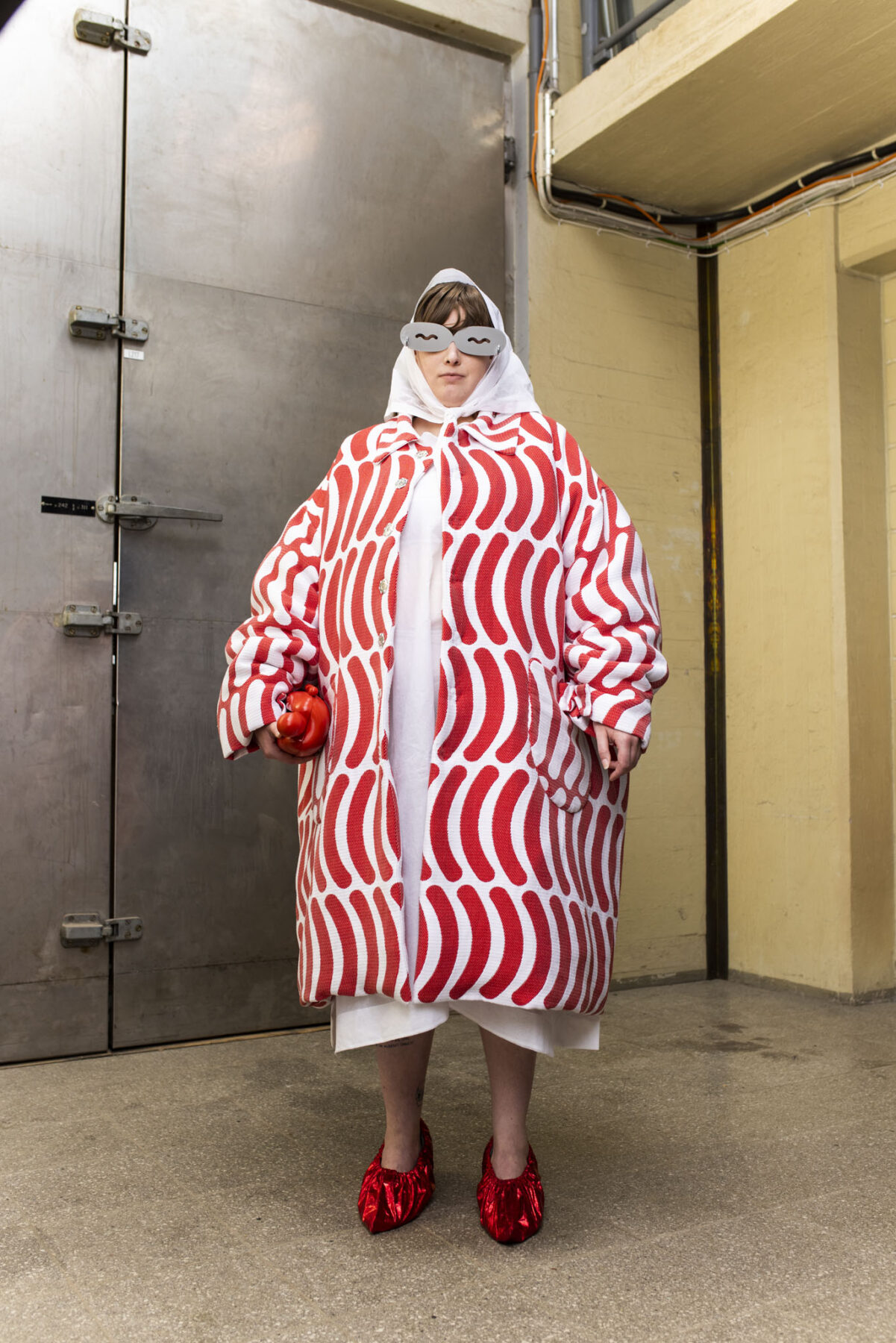 JV_01
JV_01

Jere Vilo MA Graduate collection Photographer: Sofia Okkonen
JV_01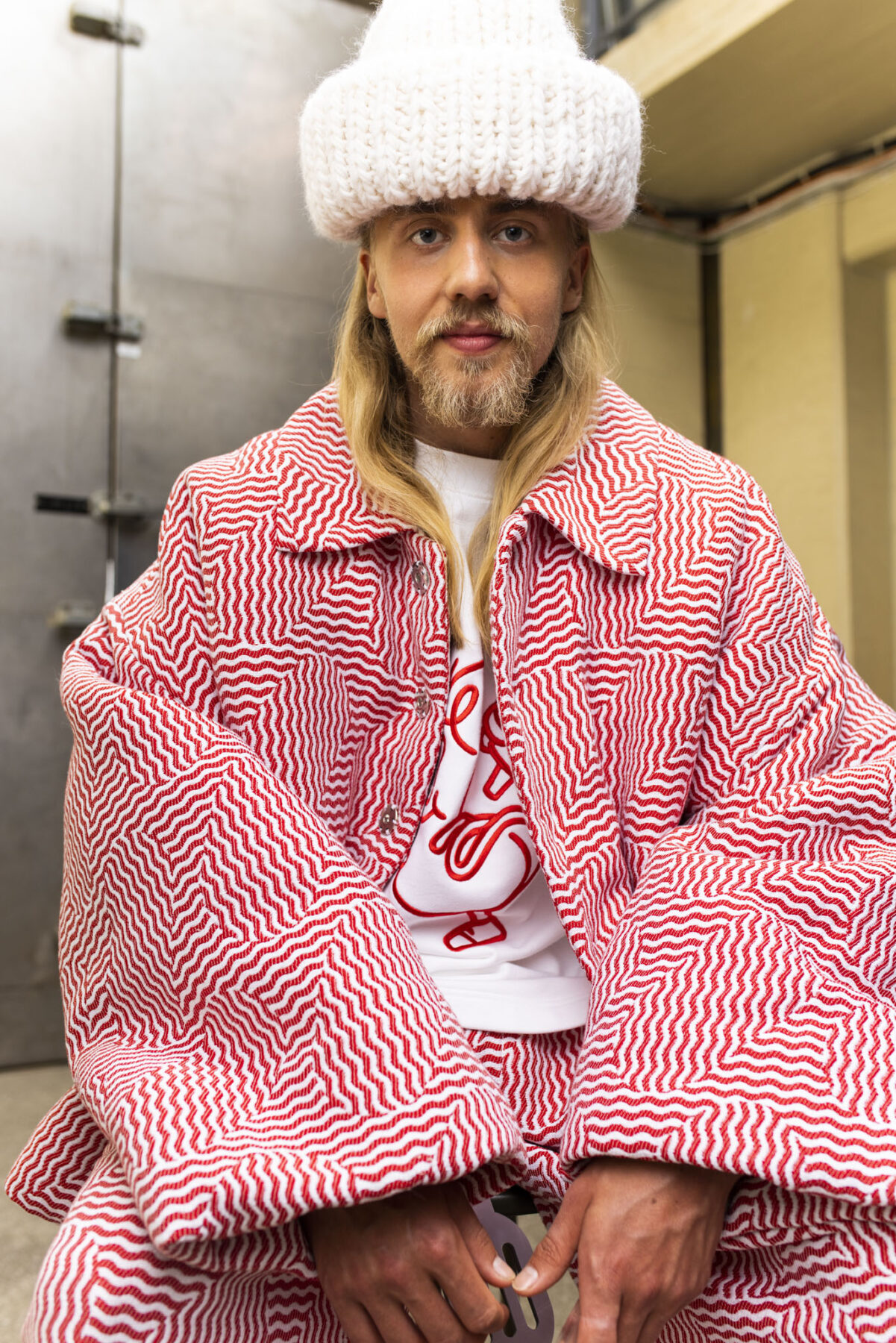 JV_02
JV_02

Jere Vilo MA Graduate collection Photographer: Sofia Okkonen
JV_02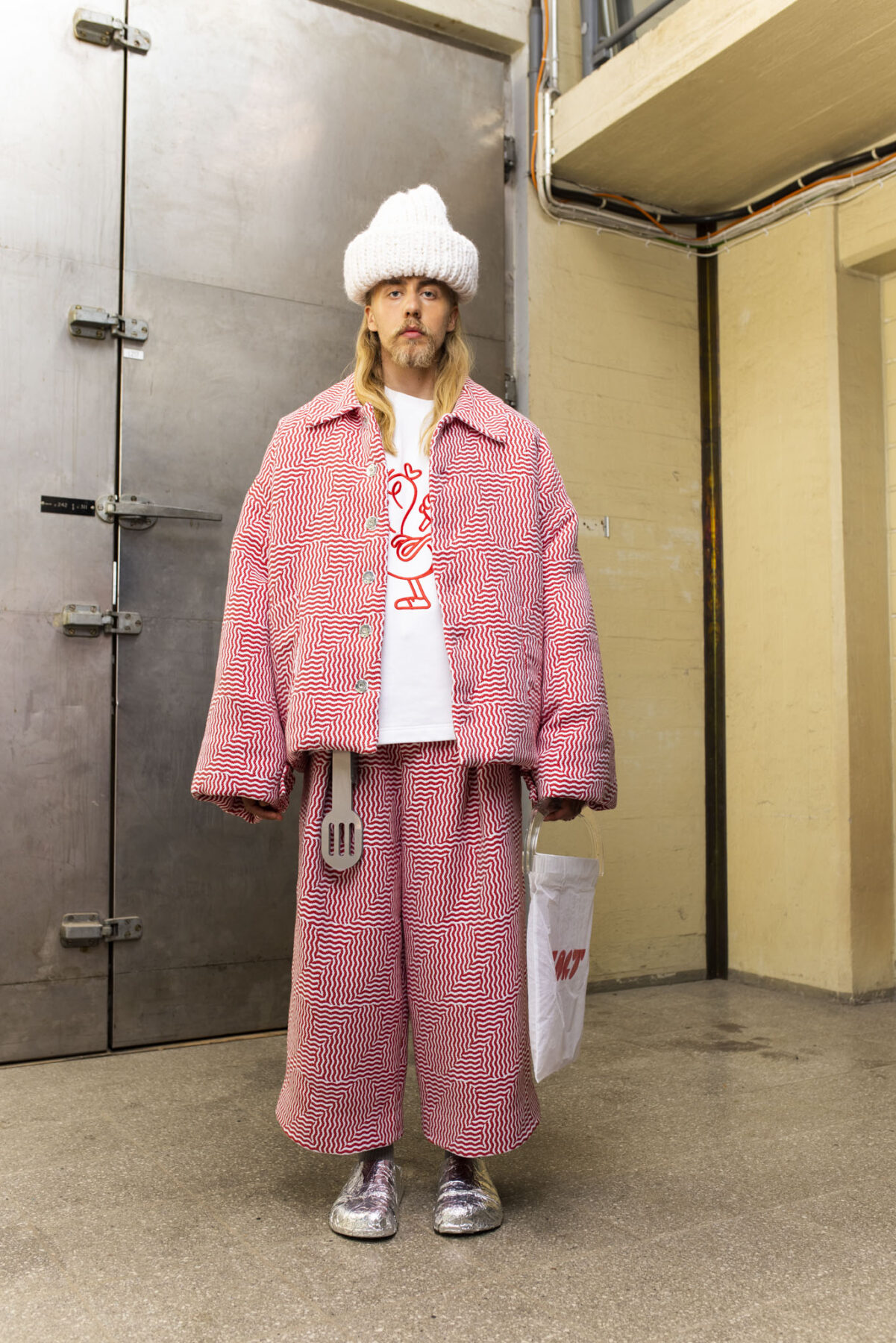 JV_03
JV_03

Jere Vilo MA Graduate collection Photographer: Sofia Okkonen
JV_03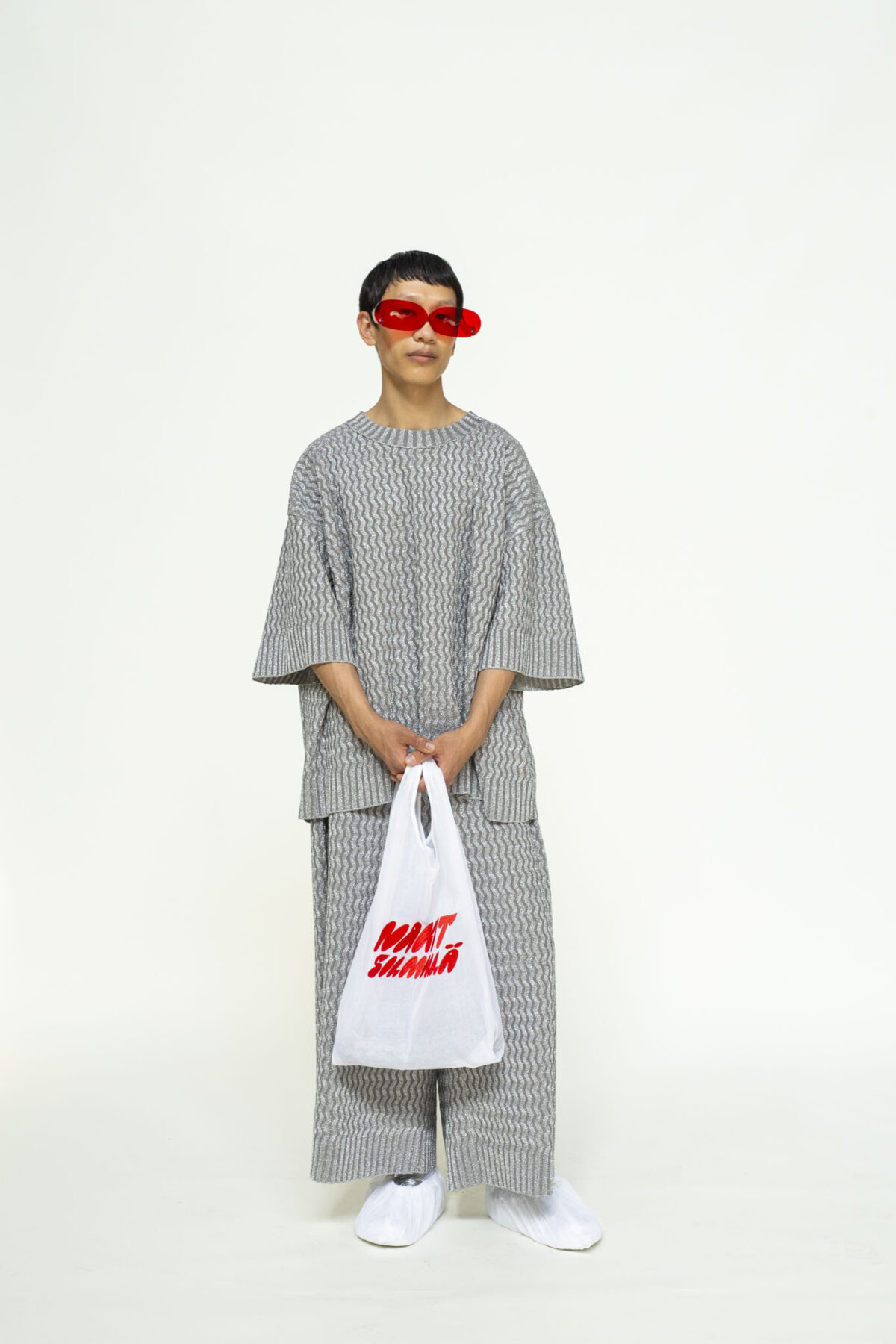 JV_04
JV_04

Jere Vilo MA Graduate collection Photographer: Sofia Okkonen
JV_04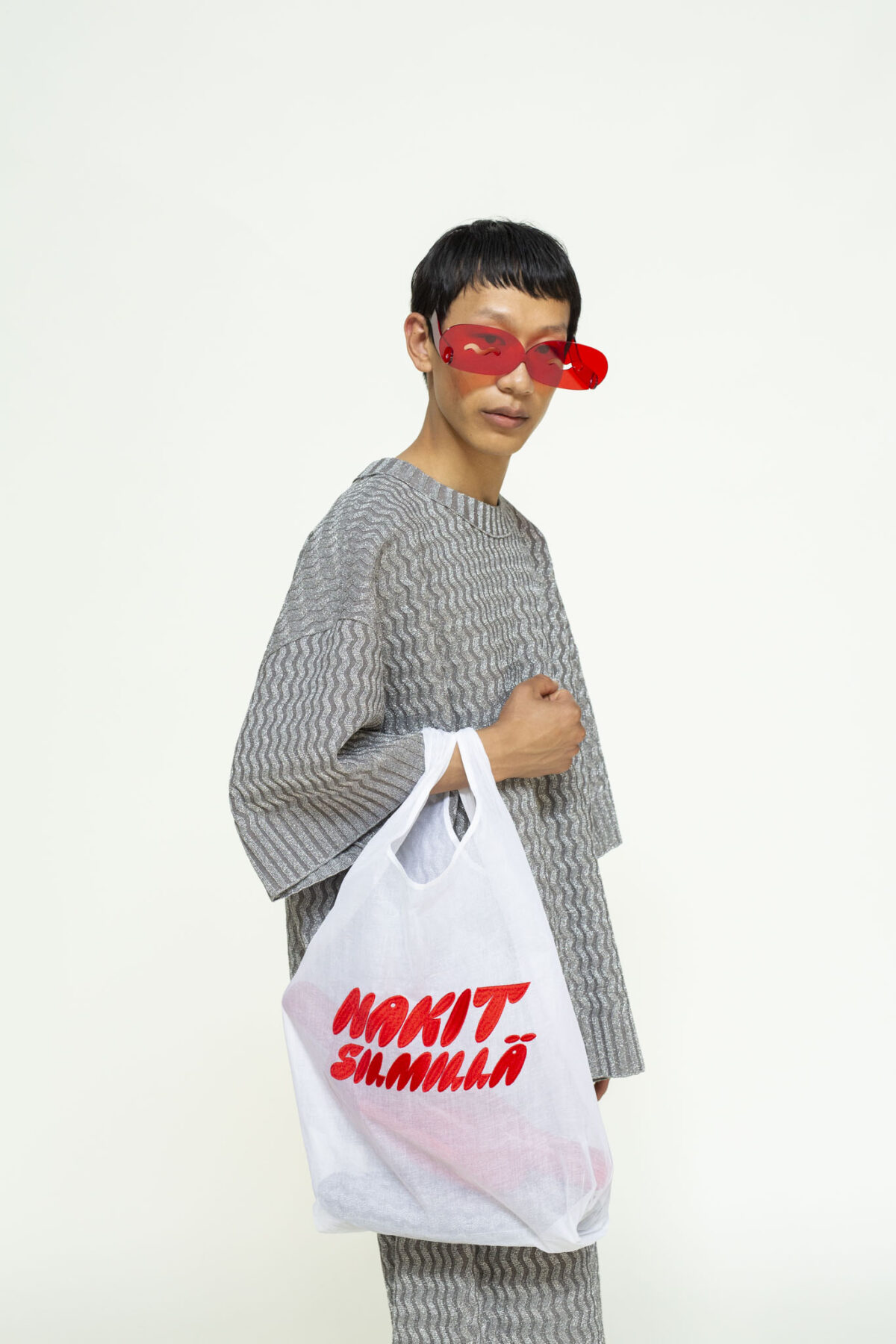 JV_05
JV_05

Jere Vilo MA Graduate collection Photographer: Sofia Okkonen
JV_05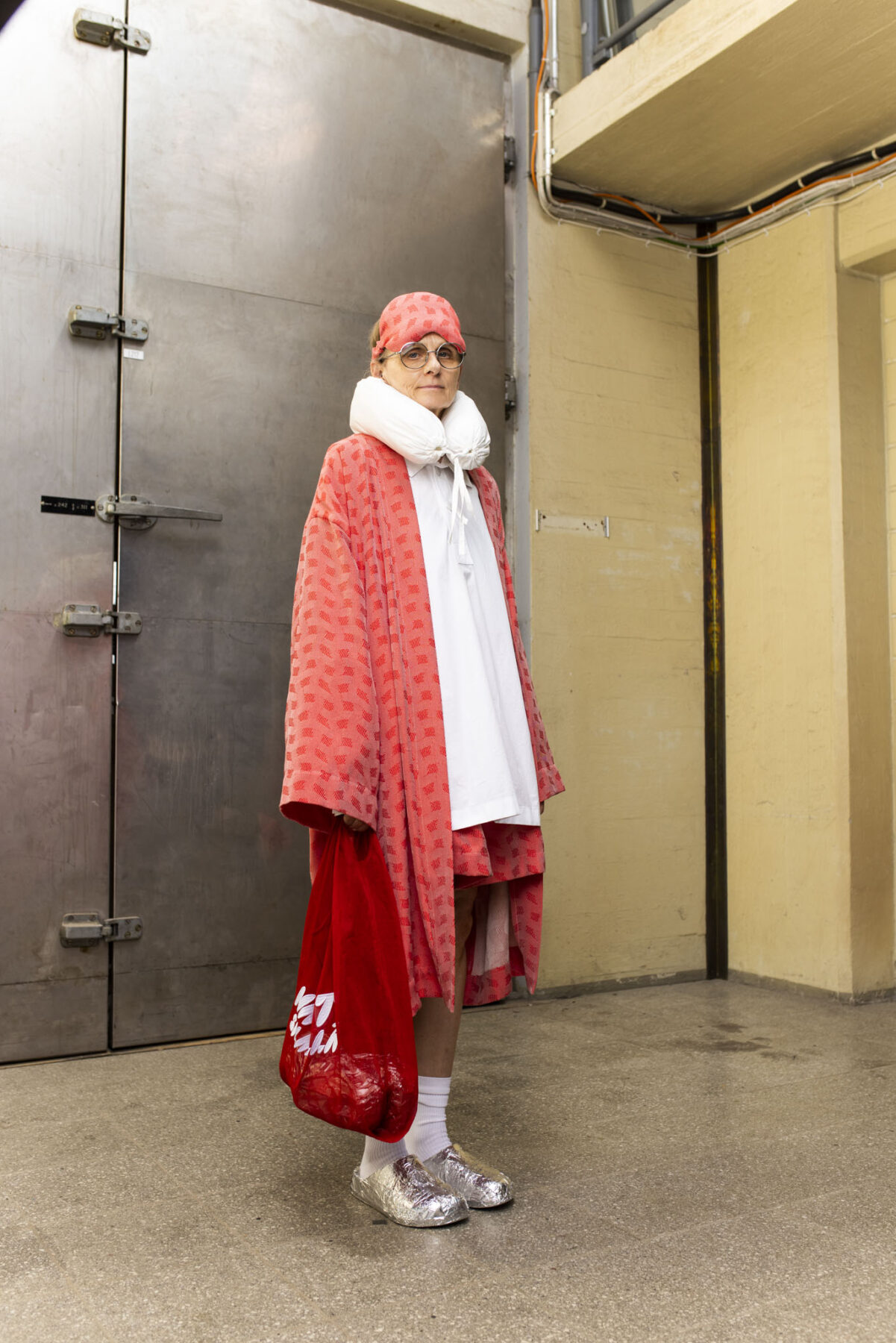 JV_06
JV_06

Jere Vilo MA Graduate collection Photographer: Sofia Okkonen
JV_06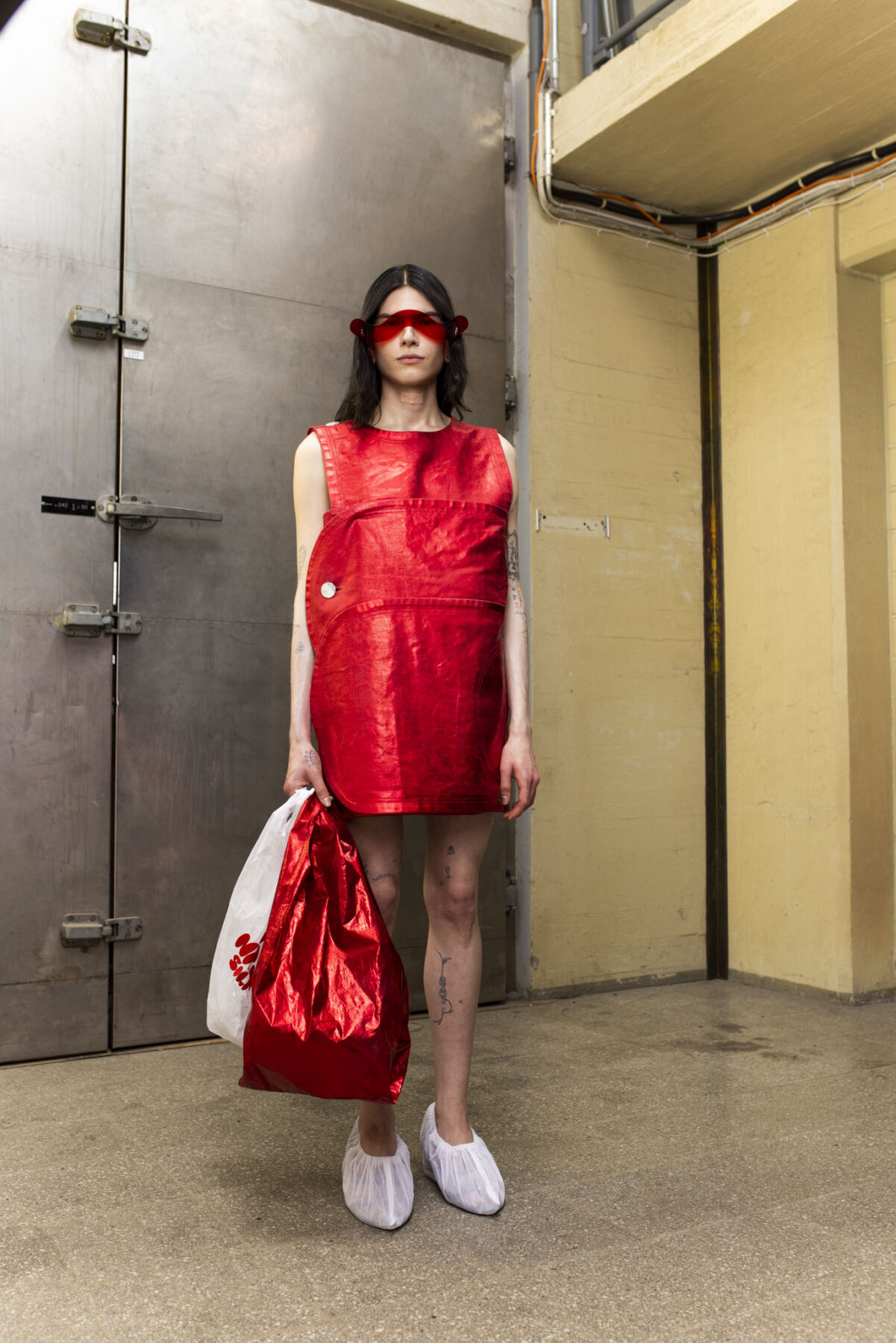 JV_07
JV_07

Jere Vilo MA Graduate collection Photographer: Sofia Okkonen
JV_07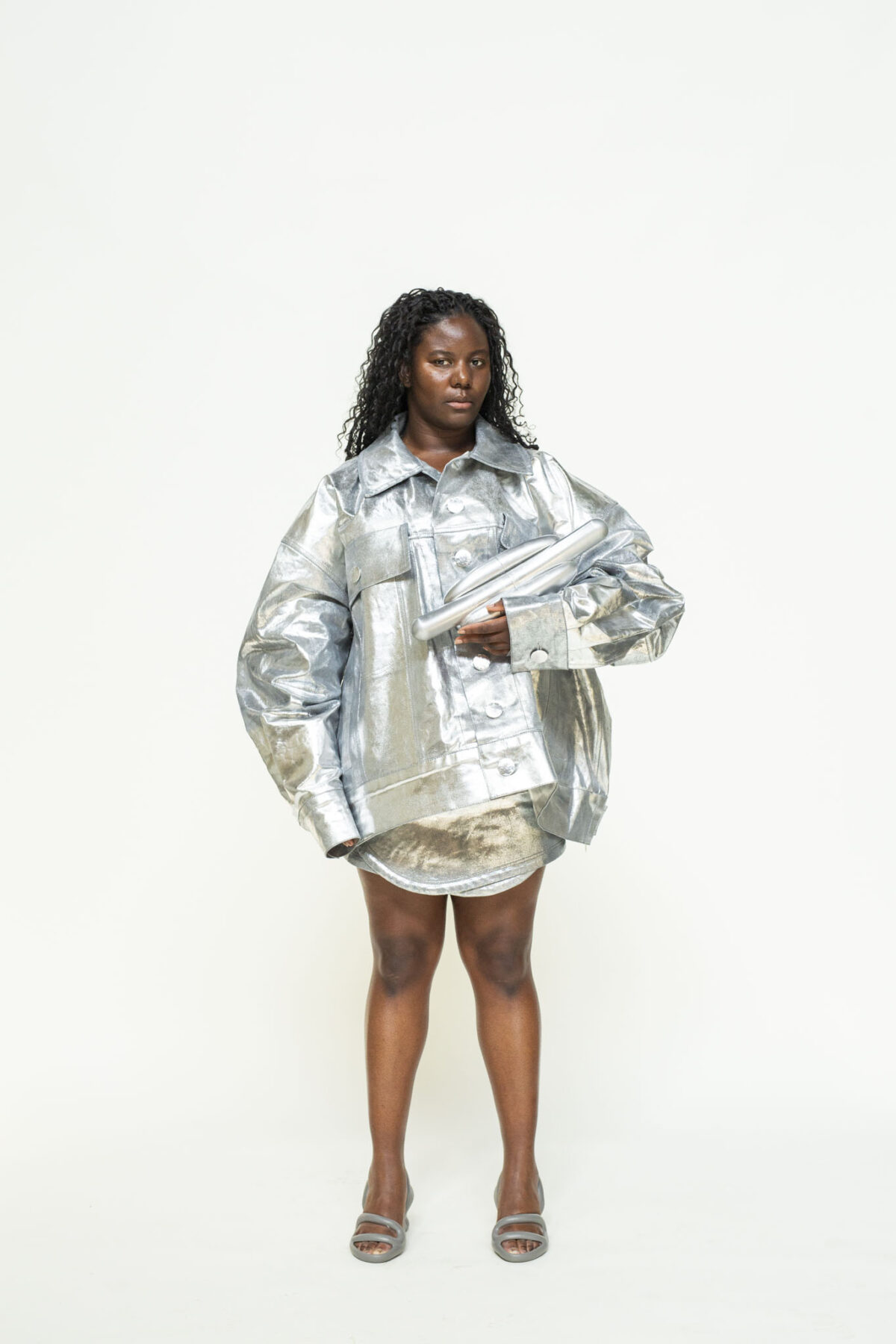 JV_08
JV_08

Jere Vilo MA Graduate collection Photographer: Sofia Okkonen
JV_08Nakit silmillä – Hot dogs over the eyes
In his graduate collection Jere Vilo researches how the working class has inspired fashion and how his own working-class background has affected his identity as a designer. During the process he has reflected on the middle-class standards that guide our choices and values, especially in the current rather polarized political climate in Finland. What brings us together?
For Vilo it is food. In his collection Vilo, an inventive storyteller, imaginines opening an imaginary hot dog stand of his dreams, called Nakit Silmillä (Hot Dogs Over the Eyes). The concept and the collection take the viewer to that stand and tell the story of the characters surrounding this imaginary place in a humorous yet observant way.
The name of the collection comes from a Finnish saying describing a deeply intoxicated person. While the viewer might not be intoxicated, the vibrant prints in the collection do make one feel like it. Previously printing most of his textiles, in this collection the prints are knitted and woven into the materials. The woven fabrics feature different twill structures traditionally found in workwear. The voluminous silhouettes emphasize the prints and maximize the use of the material leaving as little waste as possible.
– The idea was not to create functional workwear inspired by the working class, but to take the elements and turn them into a fun and absurd fictional hot dog brand that romanticizes the working class to the max. A key factor is that the work is done by the people inspiring the collection and not by the elite playing blue collar cosplay, Vilo reflects.
Having the experience of working in the service industry from a fast-food restaurant to an exclusive design boutique, the interactions with customers have partly shaped Vilo into the person and designer he is today. Stepping into the uniform and character of a salesperson is like playing a part in an everyday performance of middle-class values.
– Academic research is often not done by people from the working-class which has sometimes made me feel like an outsider, but I see this as an opportunity to tell my story and provoke thoughts in others. The financial cuts made by the current Finnish government will affect the amount of these voices in the future. But I have a message to the rulers: You can rain on my parade, but you can’t steal my fun! This is a sausage fest like no other!
Contact information:
Jere Vilo
+358 40 773 3202
@jerevilo
Iris Kareoja
(ma)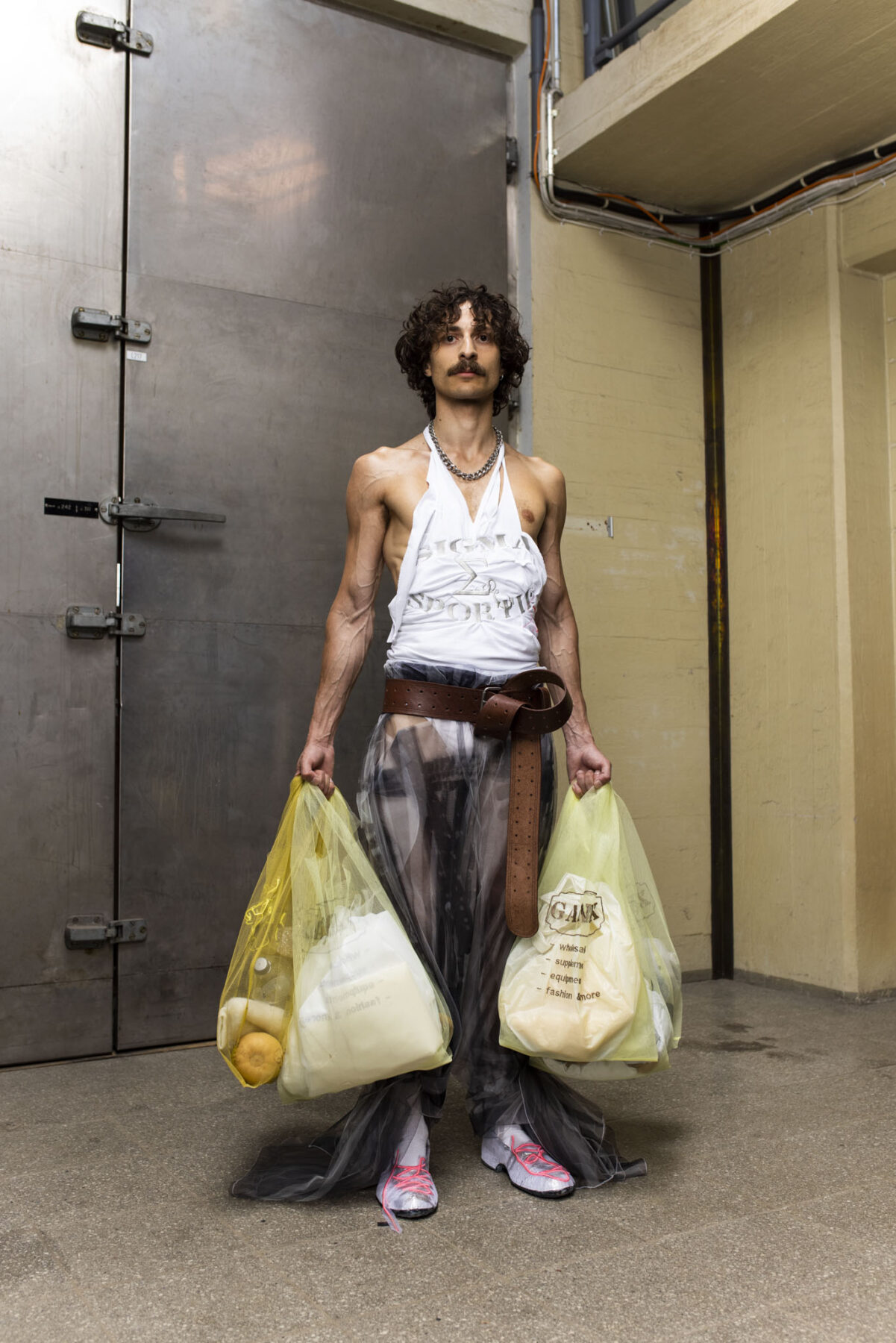 IK_01
IK_01

Iris Kareoja MA Graduate collection Photographer: Sofia Okkonen
IK_01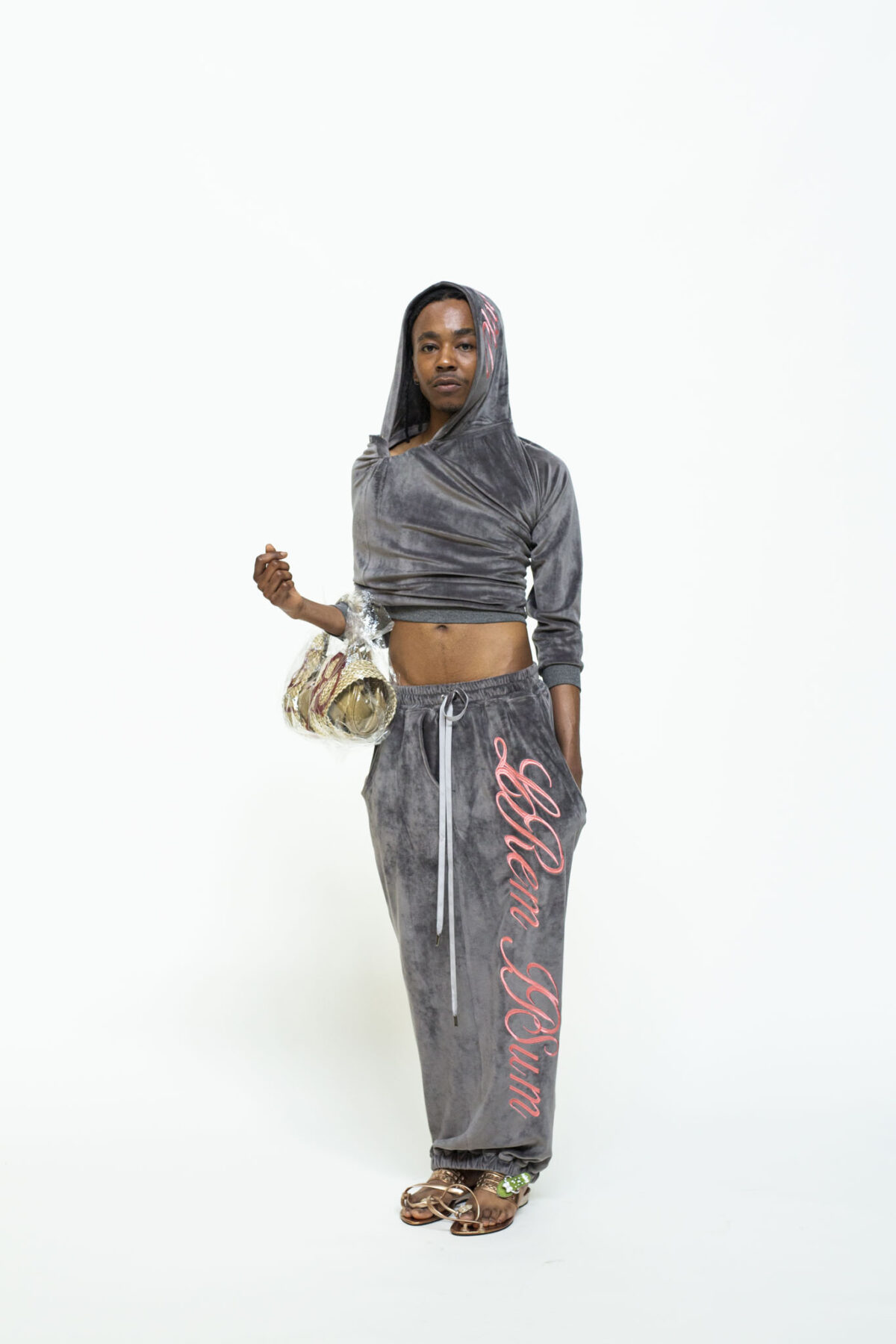 IK_02
IK_02

Iris Kareoja MA Graduate collection Photographer: Sofia Okkonen
IK_02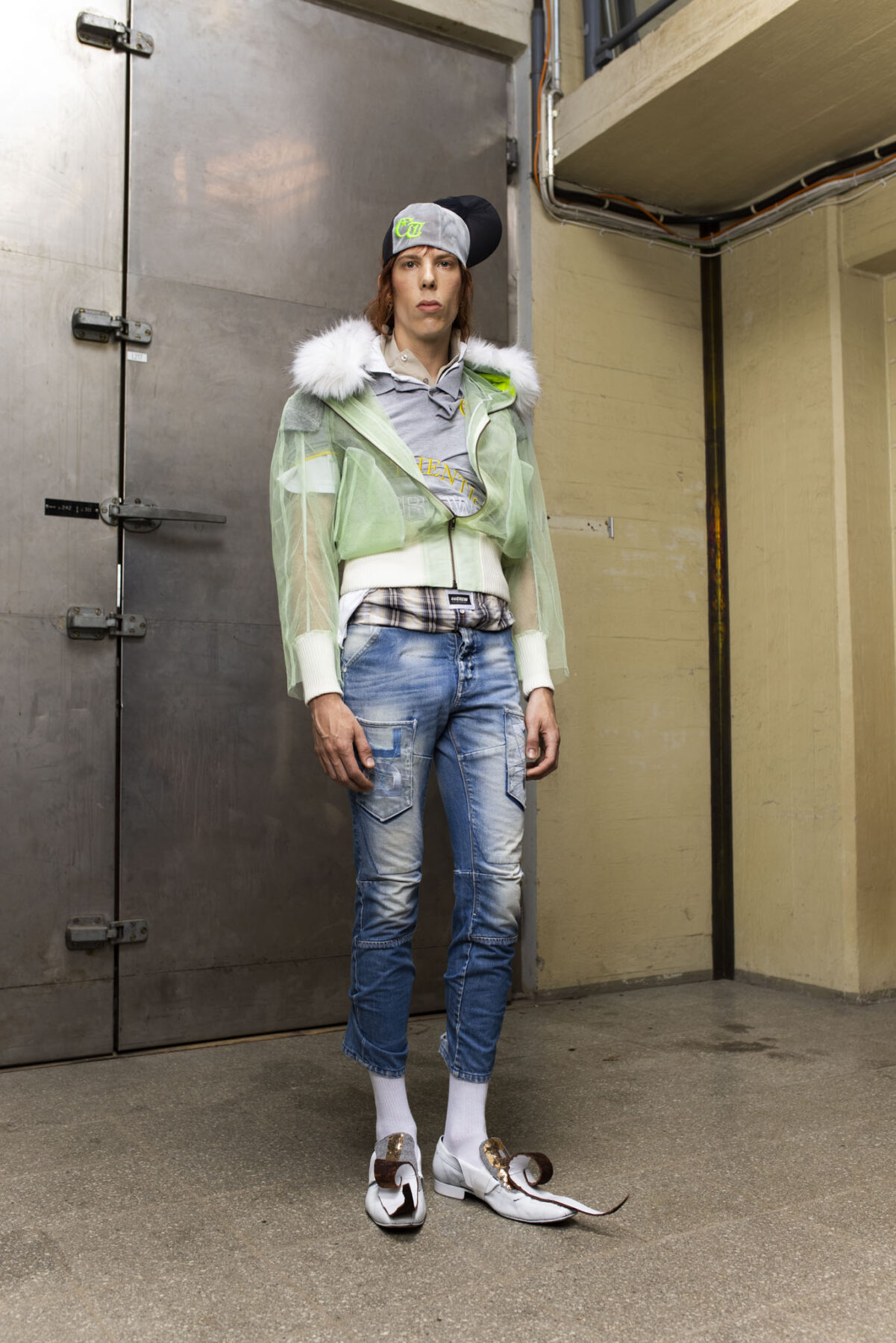 IK_03
IK_03

Iris Kareoja MA Graduate collection Photographer: Sofia Okkonen
IK_03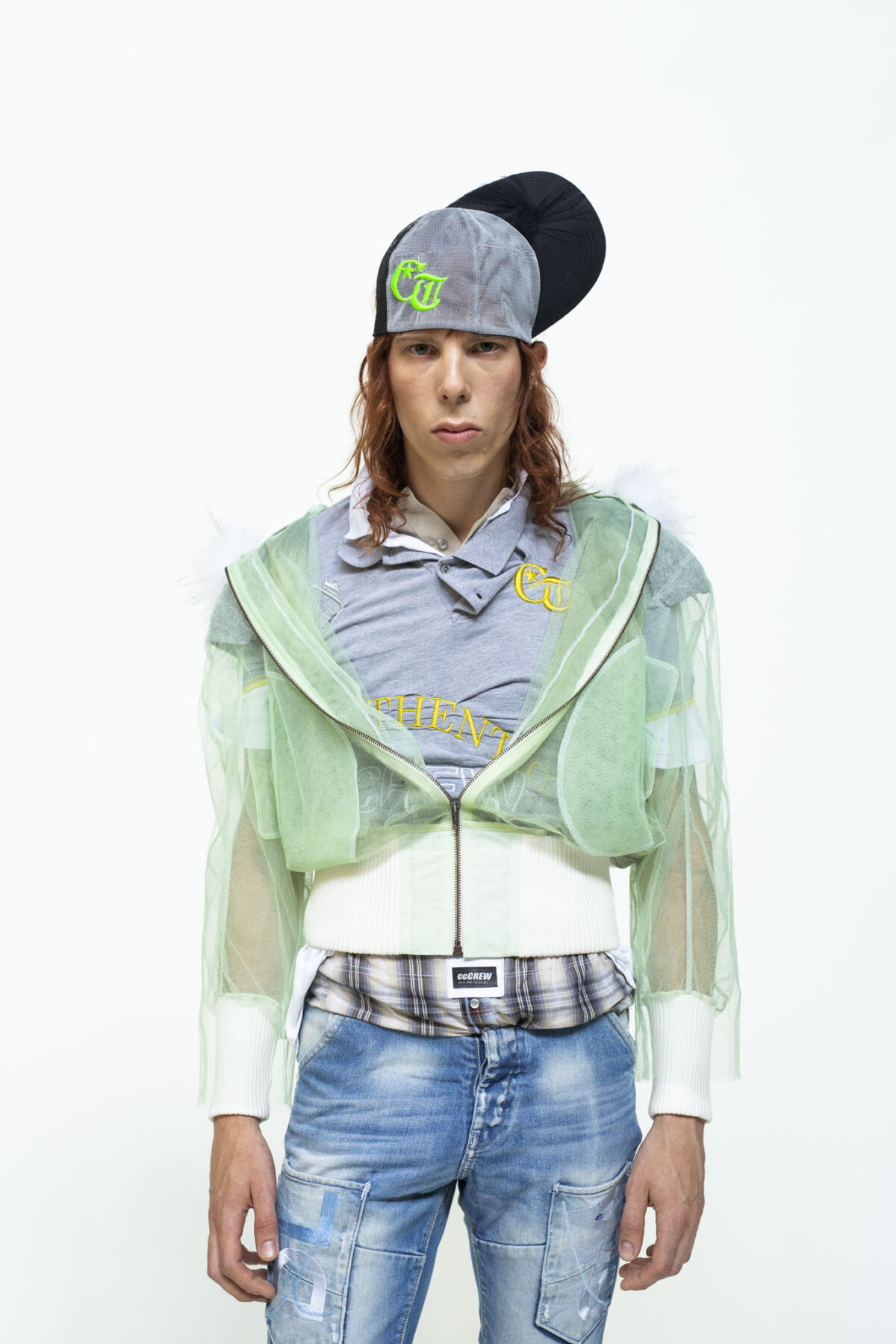 IK_04
IK_04

Iris Kareoja MA Graduate collection Photographer: Sofia Okkonen
IK_04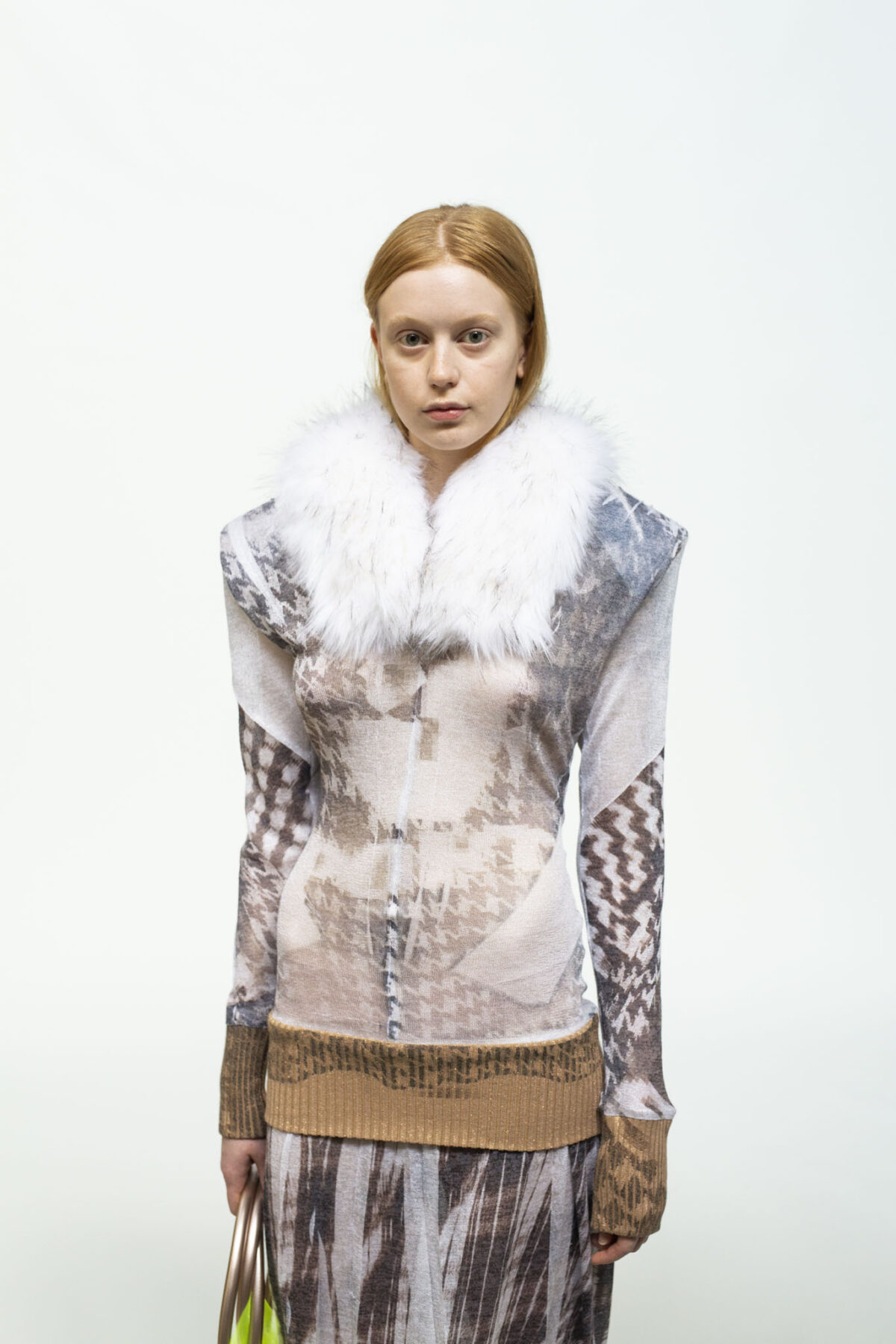 IK_05
IK_05

Iris Kareoja MA Graduate collection Photographer: Sofia Okkonen
IK_05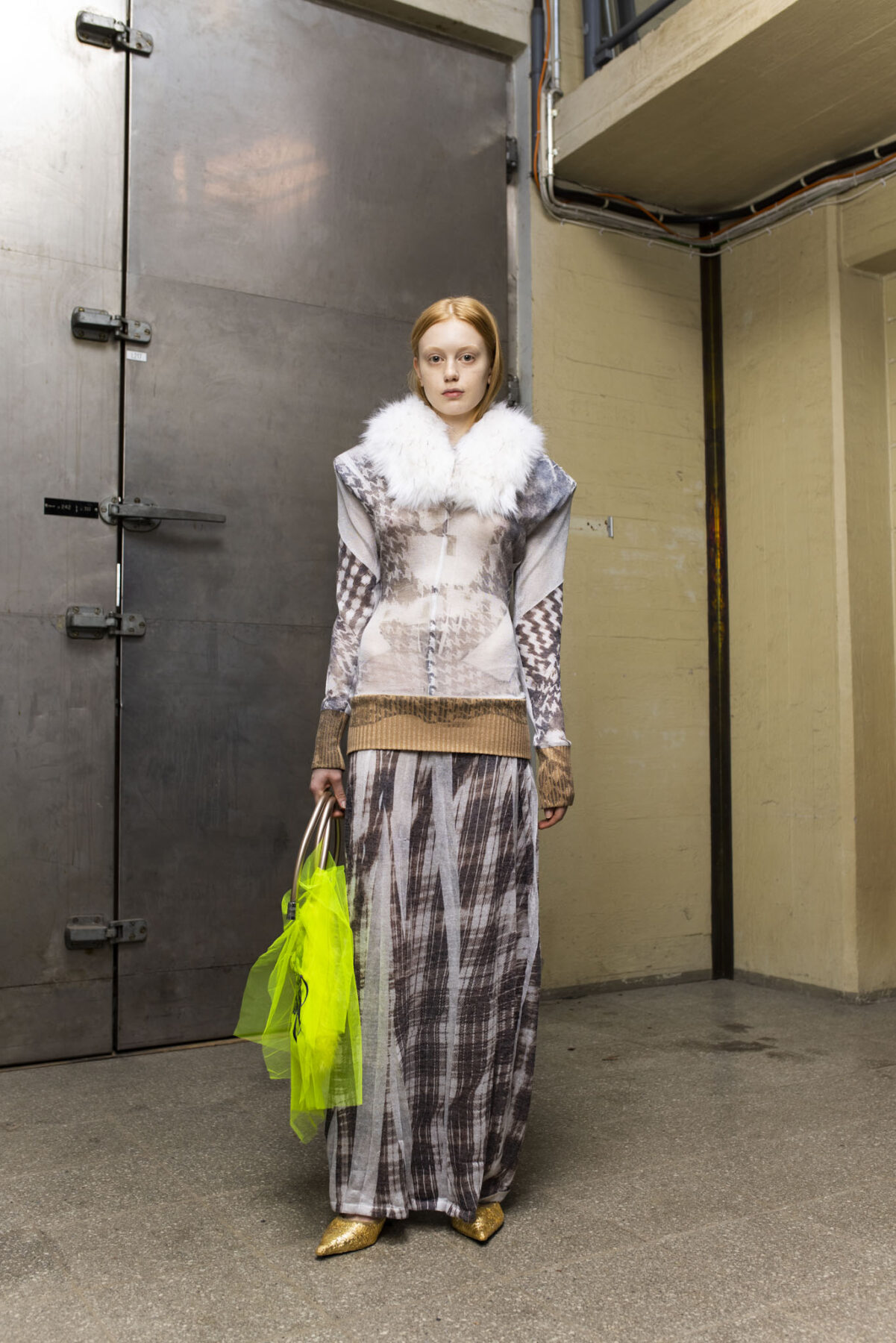 IK_06
IK_06

Iris Kareoja MA Graduate collection Photographer: Sofia Okkonen
IK_06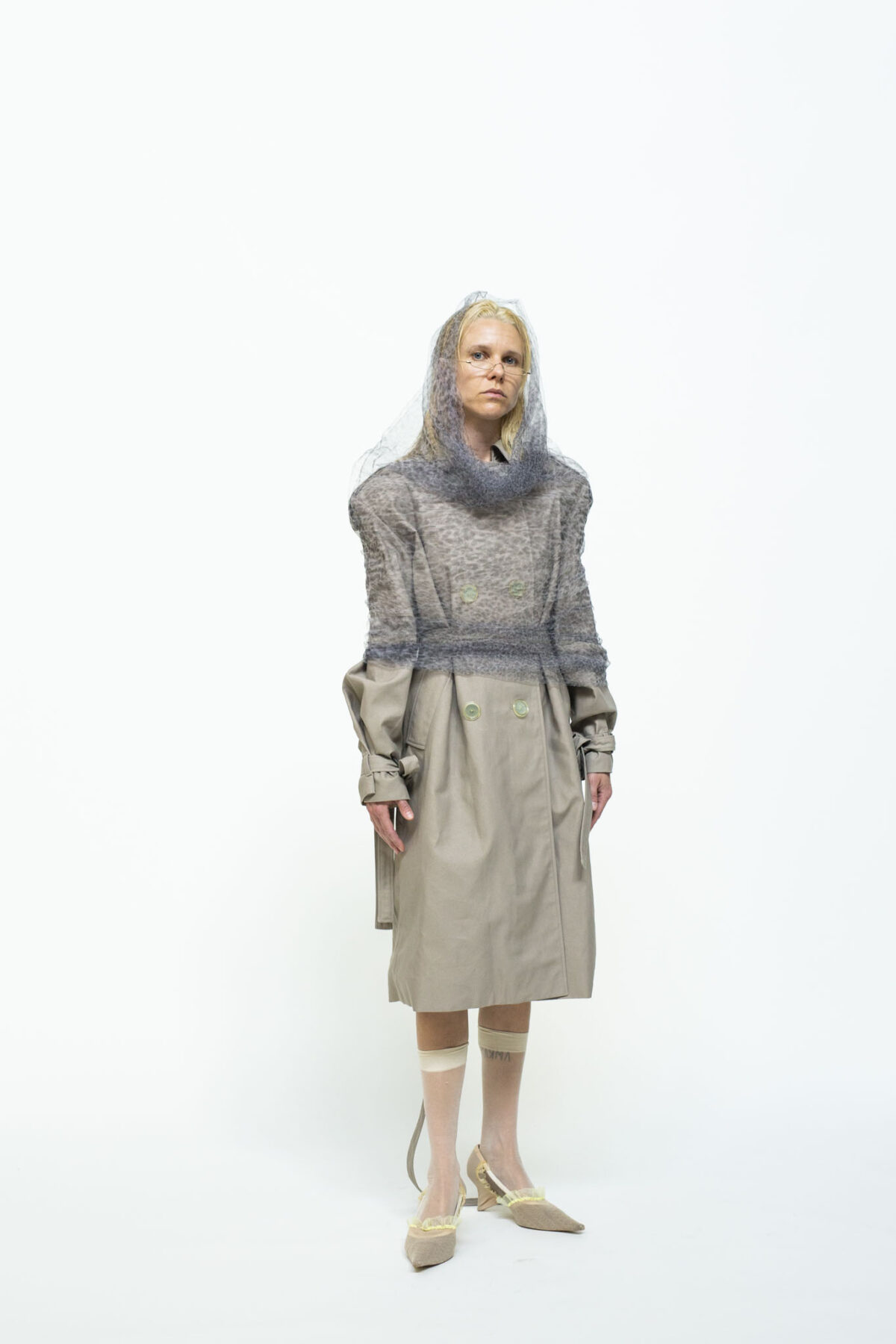 IK_07
IK_07

Iris Kareoja MA Graduate collection Photographer: Sofia Okkonen
IK_07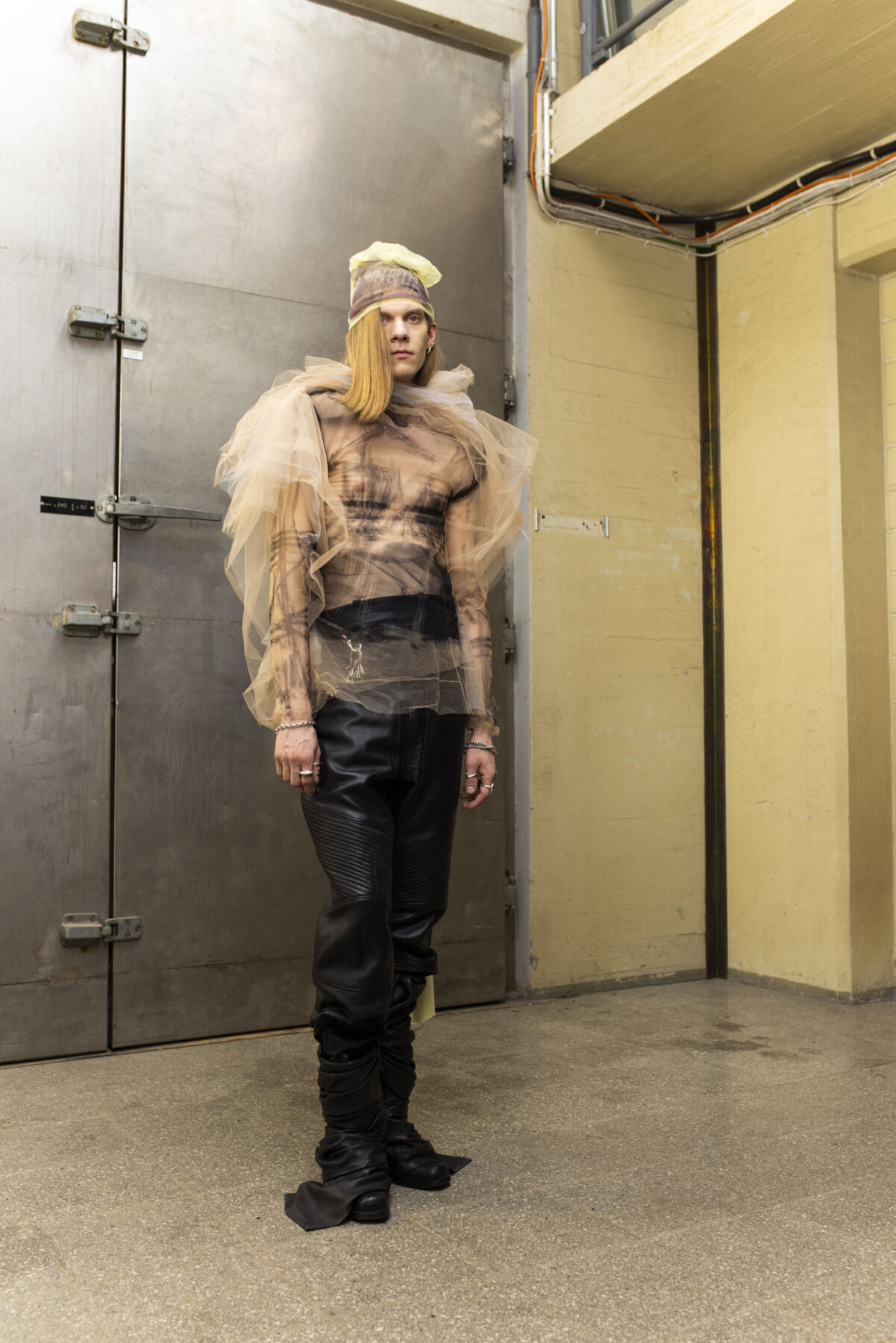 IK_08
IK_08

Iris Kareoja MA Graduate collection Photographer: Sofia Okkonen
IK_08…type beat
In her collection, Kareoja approaches the design process through curation and meditation of existing imagery, rather than through initial novelty.
– I see clothes as readymades, subjected to endless reproduction resulting in the loss of their original context, Kareoja explains.
Kareoja’s collection investigates the power which lies in the (re)production of images, and the way the act relates to social reality as well as expressions of power and taste. This includes making observations about the role of a designer as a mediator of culture and meaning. Her work heavily builds on the notion of an artwork as a shared, shapeshifting entity with evolving meanings.
– This is the concept I wish to translate into my collection.
Inspired by Hans Eijkelboom’s street photography, Kareoja observes fashion as a means of social distinction as well as a means of seeking group belonging. The line-up consists of inconsistent, yet familiar sartorial references with various connotations.
– I wanted to study perception through the use of print: to what extent can you strip something of its functional properties while still generating graspable visualizations, Kareoja asks.
Kareoja claims that fashion designers often create sartorial reproductions of some sorts, carried out by referencing and appropriating existing imagery and signs. For her, research for the collection had to do with cultivating introspection around the design practice. She wanted to explore why and how the specific visual elements are selected, and what could be the semiotic and experiential reasonings behind the choices. For Kareoja, this perspective problematized the concept of intuitive design choices.
– I thought about how creative processes are often described as “intuitive”, and what it really means. As I have gotten further in my process, the felt sense of intuitive decision-making has become something undeniable yet hard to describe. I have had to prove some of my initial hypotheses wrong, as I have not been able to dismantle these processes through a semiotic framework alone.
Contact information:
Iris Kareoja
+358503202096
@bratan.bro
Enni Lähderinne
(ma) EL_01
EL_01

Enni Lähderinne MA Graduate collection Photographer: Sofia Okkonen
EL_01 EL_02
EL_02

Enni Lähderinne MA Graduate collection Photographer: Sofia Okkonen
EL_02 EL_03
EL_03

Enni Lähderinne MA Graduate collection Photographer: Sofia Okkonen
EL_03 EL_04
EL_04

Enni Lähderinne MA Graduate collection Photographer: Sofia Okkonen
EL_04 EL_05
EL_05

Enni Lähderinne MA Graduate collection Photographer: Sofia Okkonen
EL_05 EL_06
EL_06

Enni Lähderinne MA Graduate collection Photographer: Sofia Okkonen
EL_06Otherwordly Bodies
Drawing from her personal journey as a wearer of medical support braces during her formative years, Enni Lähderinne’s graduate collection seeks to unveil the embodied experiences inherent in the connection between the garment and the wearer – an endeavor to tangibly visualize the profound synergy between the two.
Central to Lähderinne’s vision is a zero-waste pattern system meticulously crafted during her master’s studies, unveiling the delicate equilibrium between the body’s form and the garments it adorns. Each movement, each breath imprints upon the fabric, shaping not only the clothes but also the very essence of the surrounding space.
– I aimed to illustrate the depth of connection and self-awareness that emerges when an additional layer exists between oneself and clothing, ultimately transforming every experience. These garments imbue impressions upon the skin, serving as tangible reminders – a fleeting yet indelible imprint of embodied sensations, Lähderinne says.
Lähderinne selected materials and shapes meticulously. She is especially fascinated by how fabrics retain the memory of the body’s touch. For her, garments acquire significance when they bear the imprint of the wearer’s body.
– The essence of my collection centers on the recognition that the body imparts an enduring mark upon the clothes it adorns, imbuing them with both meaning and form. Just as clothing functions as a mirror reflecting the self, it also serves as a canvas upon which our identity is molded.
This is further stressed by Lähderinne’s knitwear. It is crafted from monofilament which challenges the conventional notions of softness while seamlessly integrating the garments with the body.
– It is a fusion inspired by the imprints left by medical braces on the skin, Lähderinne explains.
Rooted in personal encounters with Scheuermann’s disease, a condition involving an abnormal, excessive curvature of the spine, and the embrace of a medical brace designed to cure it, Lähderinne’s work challenges traditional fashion analysis, which often overlooks the experiential and embodied dimensions of dress. By extending the boundaries of the body through the fusion of knitwear and denim, her designs offer a transformative experience – a delicate armor that both shields and reveals, empowering the wearer to command the gaze upon them and reclaim agency over their narrative.
The collection also includes garment-size jewelry which Lähderinne designed in collaboration with her father, who shares the same condition as the designer.
– The jewelry not only encapsulates the essence of the medical brace and Scheuermann’s disease but also serves as a tangible expression of a shared journey with my father. The jewelry represents a meaningful collaboration that has empowered and strengthened us both.
Contact information:
Enni Lähderinne
+358 405186322
@mennienni
Ema Uršič
(ma)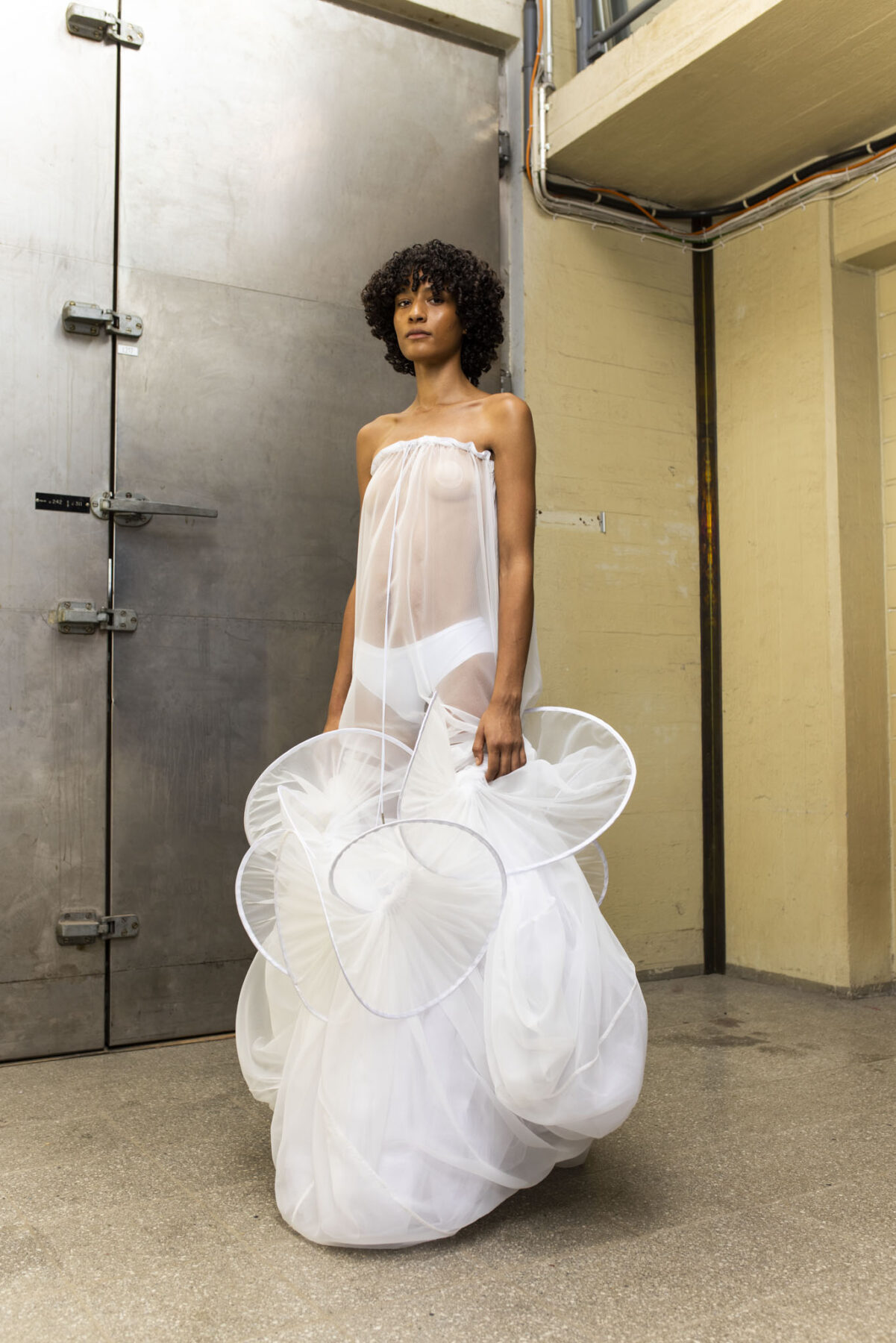 EU_01
EU_01

Ema Uršič MA Graduate collection Photographer: Sofia Okkonen
EU_01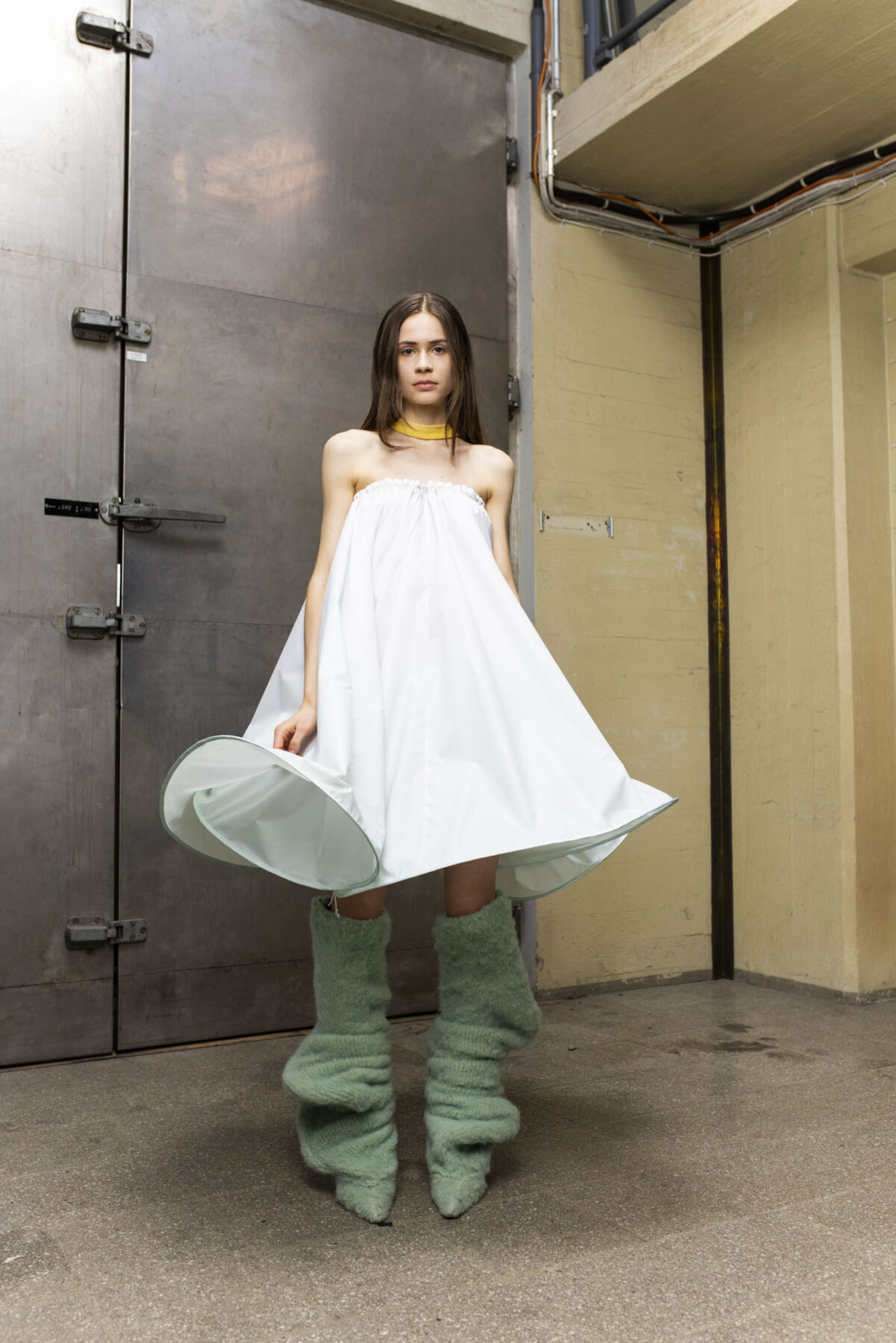 EU_02
EU_02

Ema Uršič MA Graduate collection Photographer: Sofia Okkonen
EU_02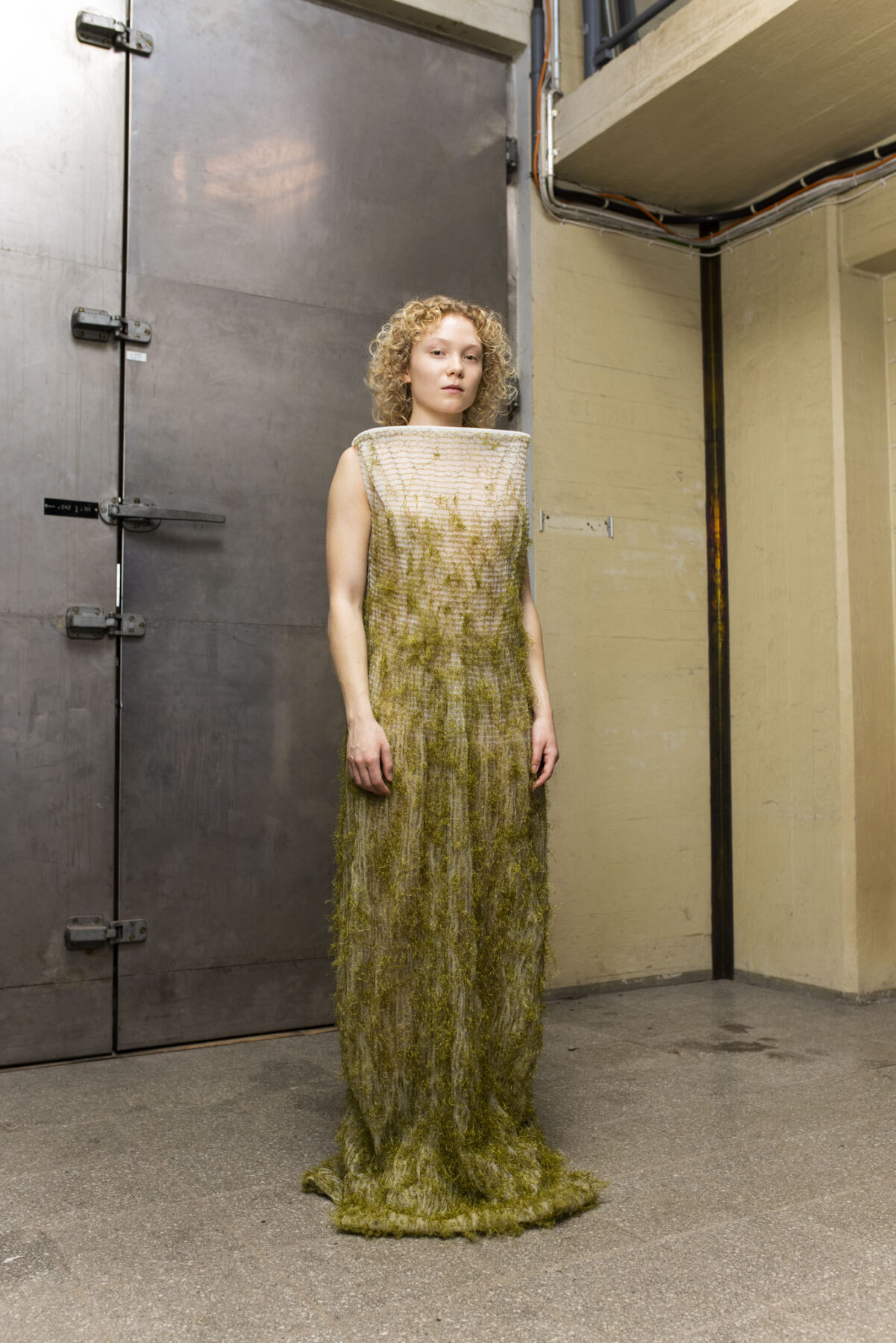 EU_03
EU_03

Ema Uršič MA Graduate collection Photographer: Sofia Okkonen
EU_03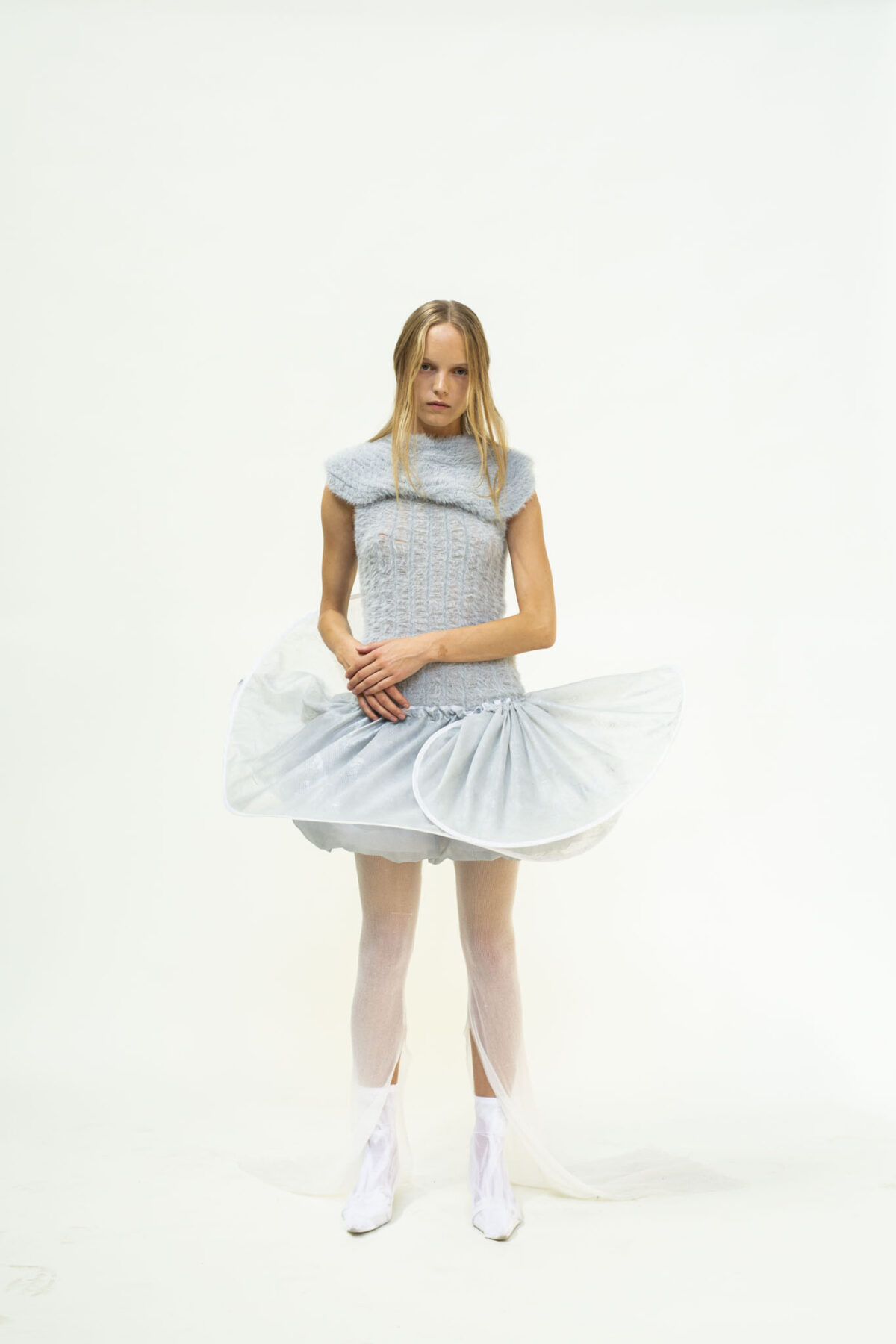 EU_04
EU_04

Ema Uršič MA Graduate collection Photographer: Sofia Okkonen
EU_04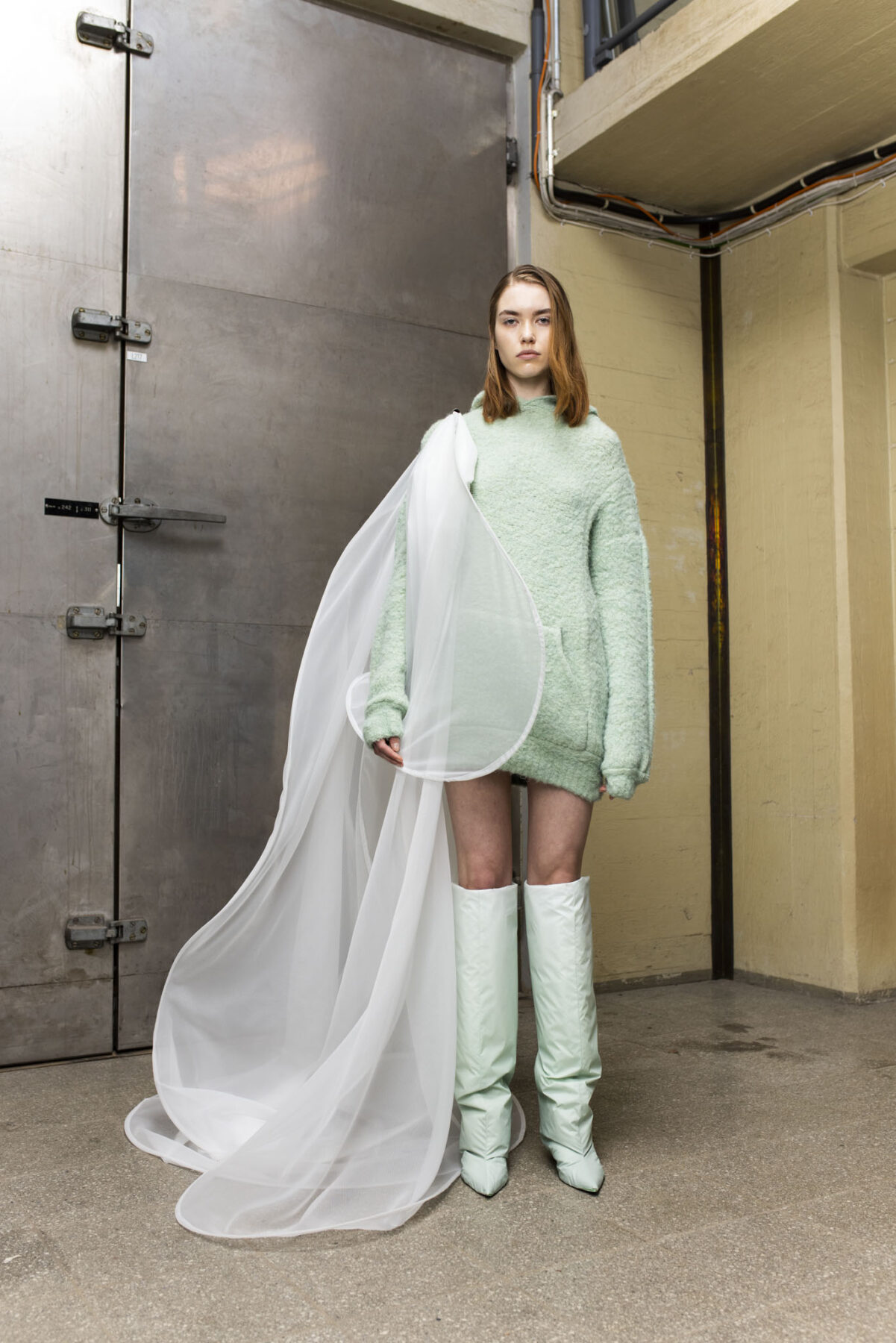 EU_05
EU_05

Ema Uršič MA Graduate collection Photographer: Sofia Okkonen
EU_05Crafting Identities
In her graduate collection, Ema Uršič explores the themes of identity and belonging, especially how the intersection of personal history and cultural heritage narrates one’s design process. The longing for belonging has drawn Uršič to reconsider what it means to be defined by the place and people such as family and nationality. Inspired by the nostalgic journey into her Slovenian roots, the designer explains,
– When I was little, I experimented with adapting my parents’ clothes. In my thesis project I am reflecting on what it means to be a designer and how our personal history shapes our design decisions.
Central to the collection is the manipulation of shape and proportion, echoing Uršič’s childhood memories of play and adaptation of oversized garments borrowed from her parents’ closet. This playful yet poignant approach transforms familiar forms into new expressions of fit and function.
The embodied knowledge in Uršič’s work extends beyond shaping garments; it profoundly influences the textile creation process. Inspired by a deep sense of nostalgia and cherished artifacts, she delves into the realms of knitting and printing to bring her textiles to life.
– My collection is marked by a meticulous handwork approach, essential for infusing each piece of fabric with stories and memories. Through this intimate engagement with the material, I craft textiles that are not merely decorative but are imbued with the essence of her past experiences.
Contact information:
Ema Uršič
+38641431423
@emmaursic
Eetu Saarentausta & Eemil Halme
(ba)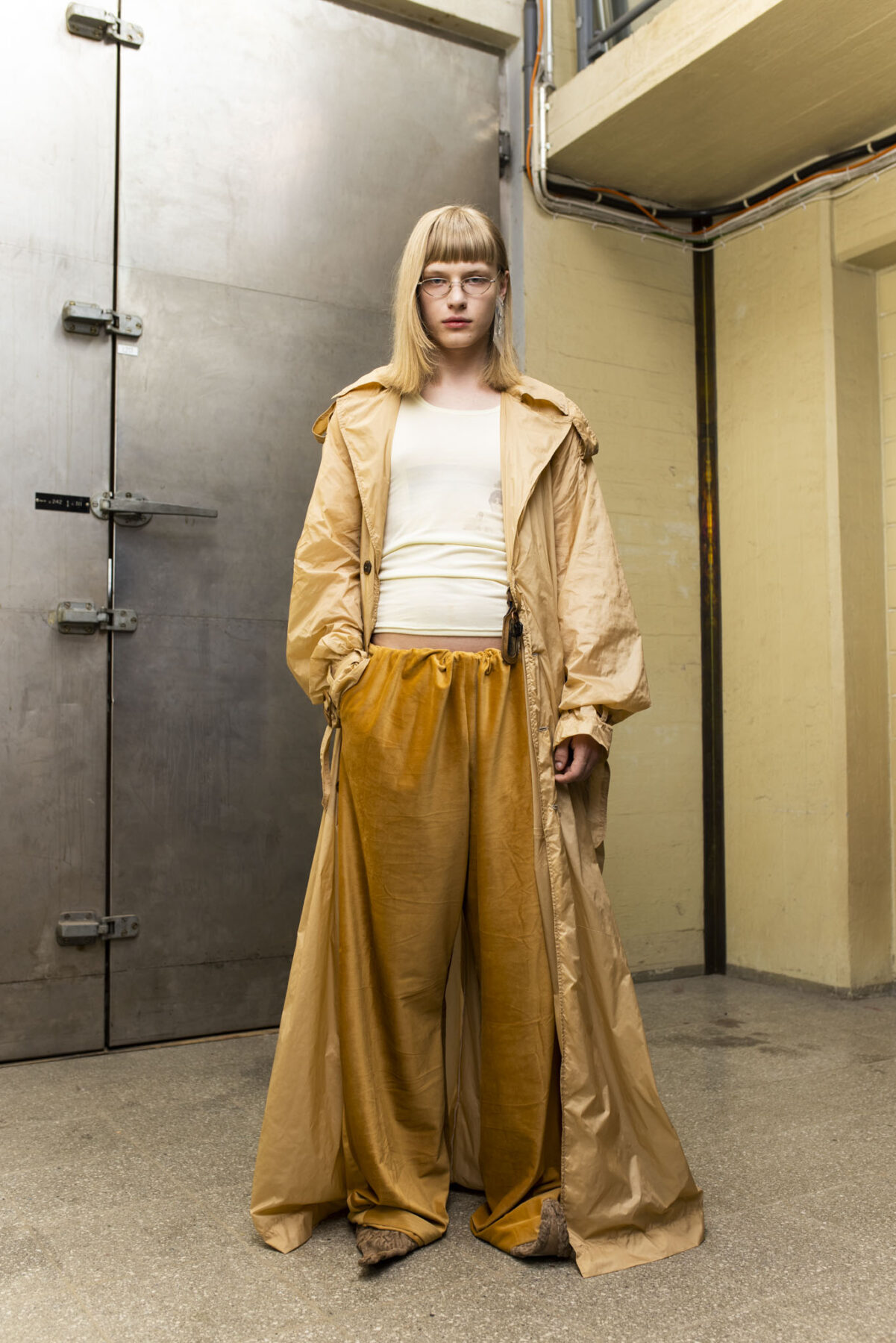 E&E_01
E&E_01

Eemil Halme & Eetu Saarentausta BA Graduate colaborative collection Photographer: Sofia Okkonen
E&E_01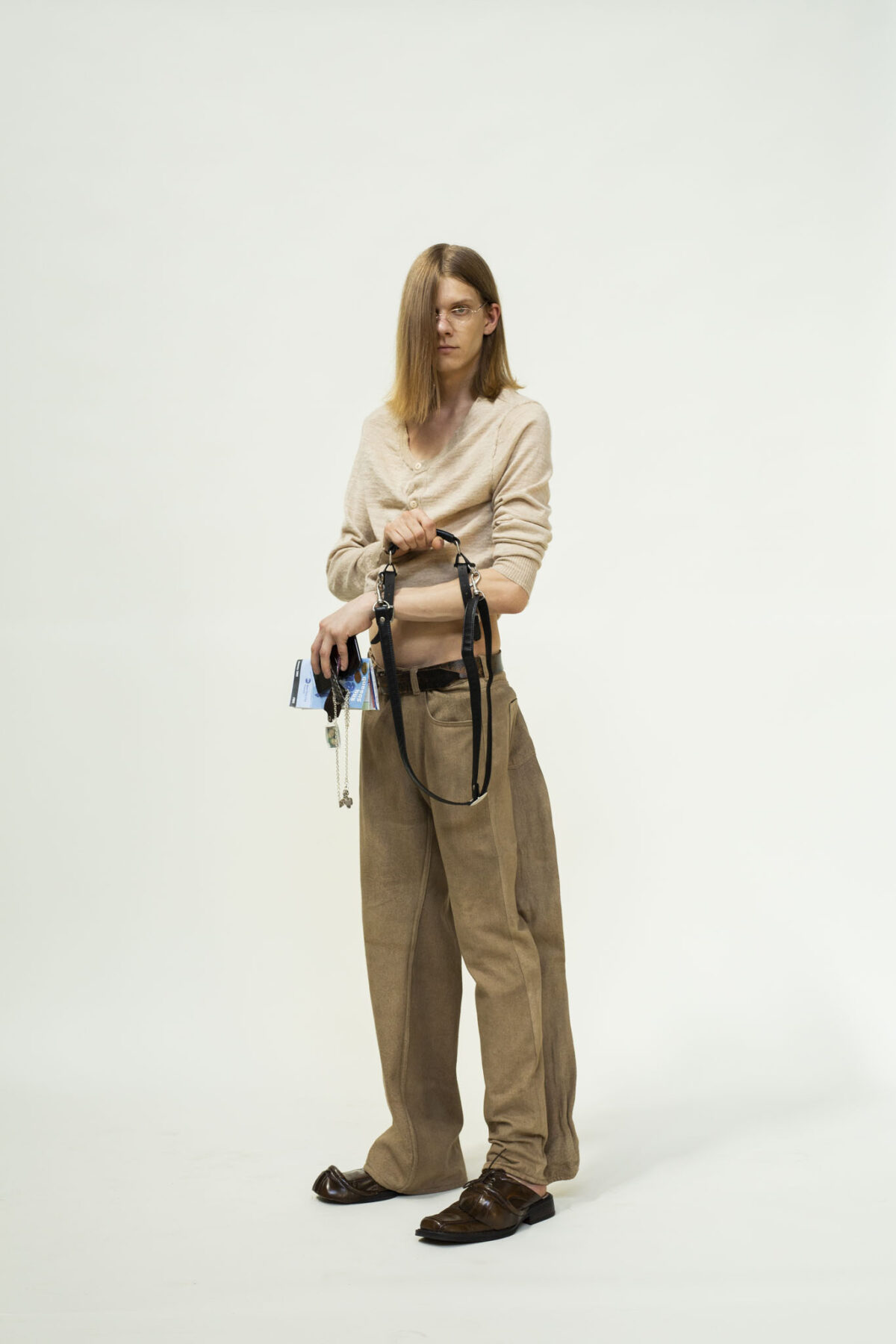 E&E_02
E&E_02

Eemil Halme & Eetu Saarentausta BA Graduate colaborative collection Photographer: Sofia Okkonen
E&E_02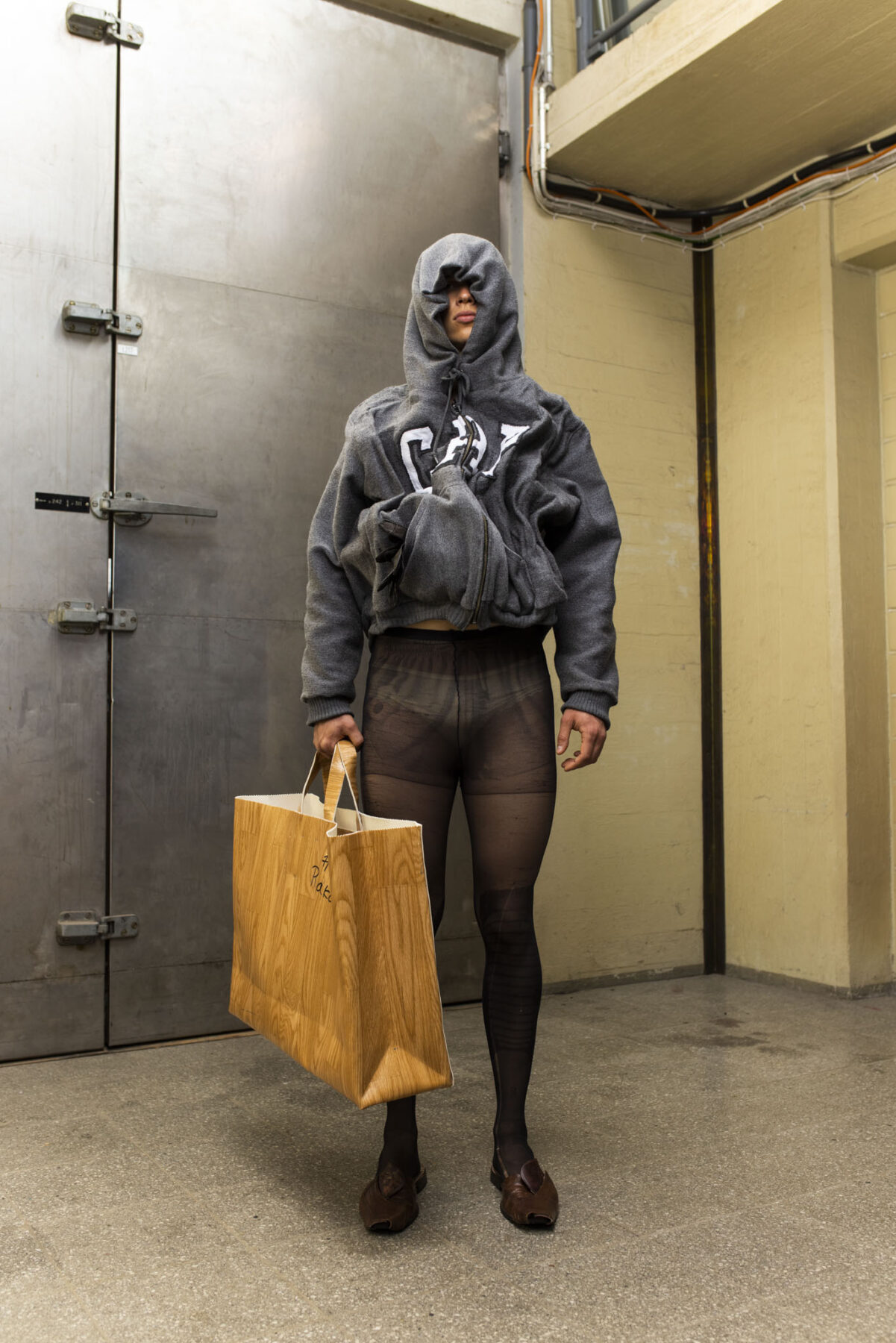 E&E_03
E&E_03

Eemil Halme & Eetu Saarentausta BA Graduate colaborative collection Photographer: Sofia Okkonen
E&E_03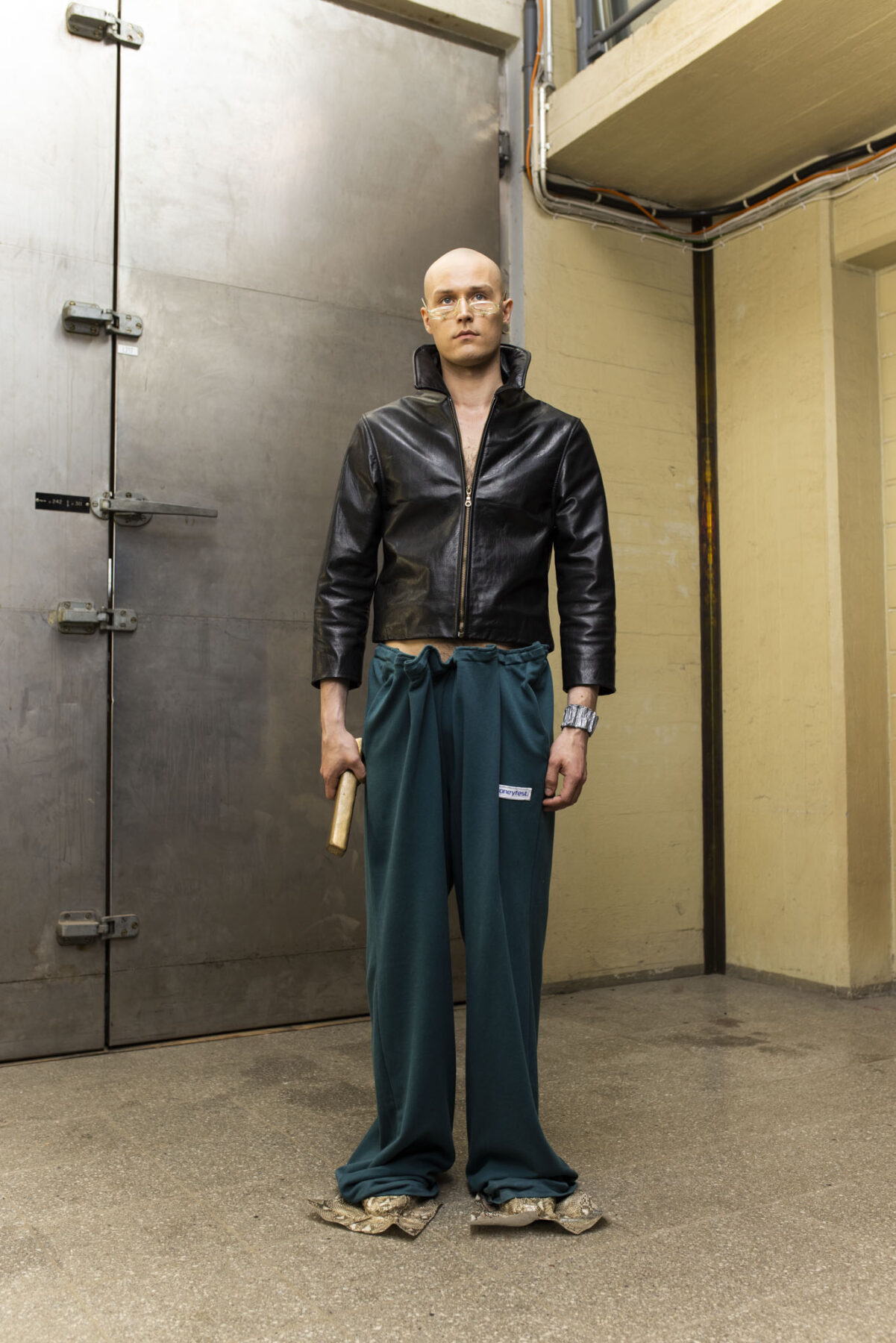 E&E_04
E&E_04

Eemil Halme & Eetu Saarentausta BA Graduate colaborative collection Photographer: Sofia Okkonen
E&E_04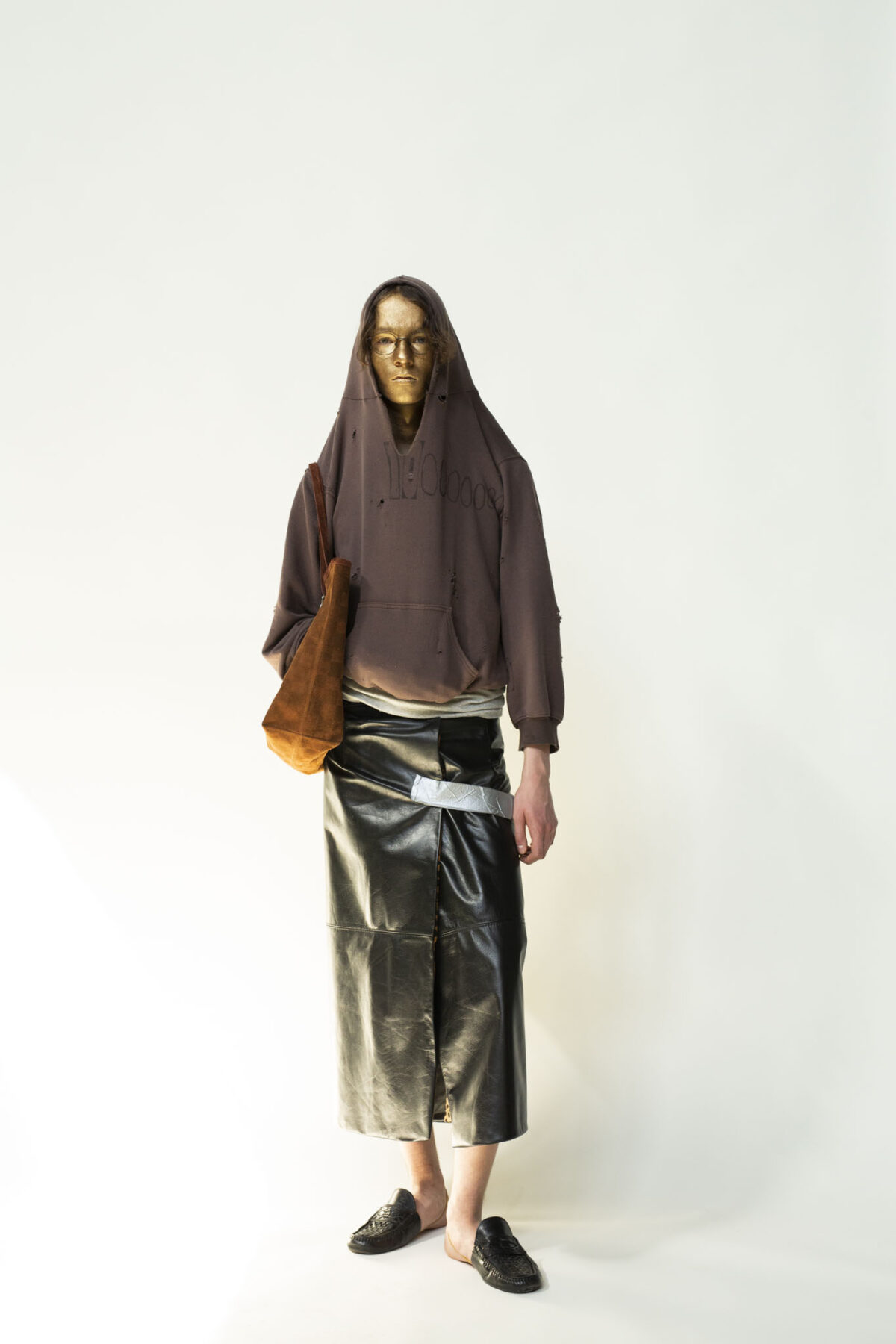 E&E_05
E&E_05

Eemil Halme & Eetu Saarentausta BA Graduate colaborative collection Photographer: Sofia Okkonen
E&E_05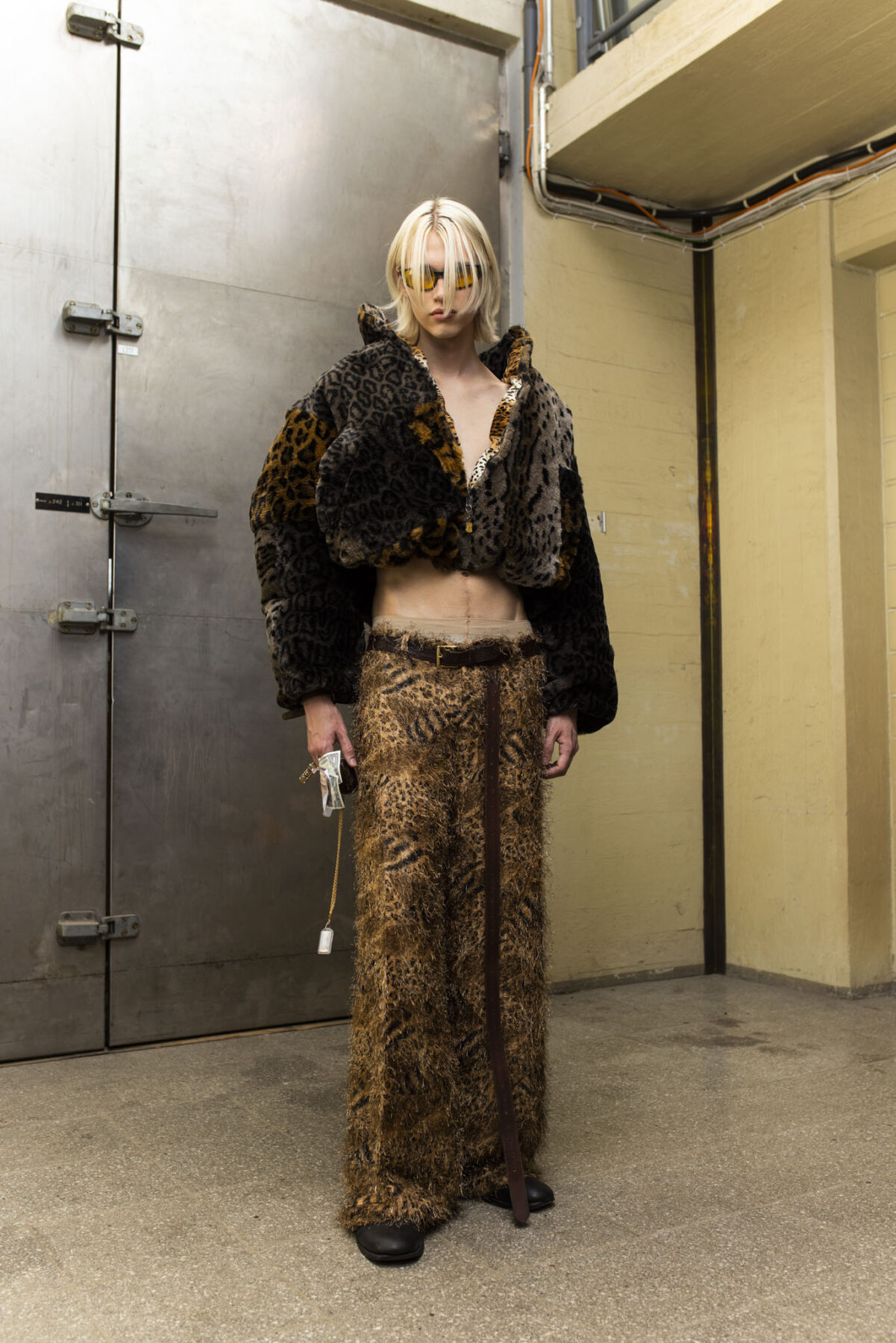 E&E_06
E&E_06

Eemil Halme & Eetu Saarentausta BA Graduate colaborative collection Photographer: Sofia Okkonen
E&E_06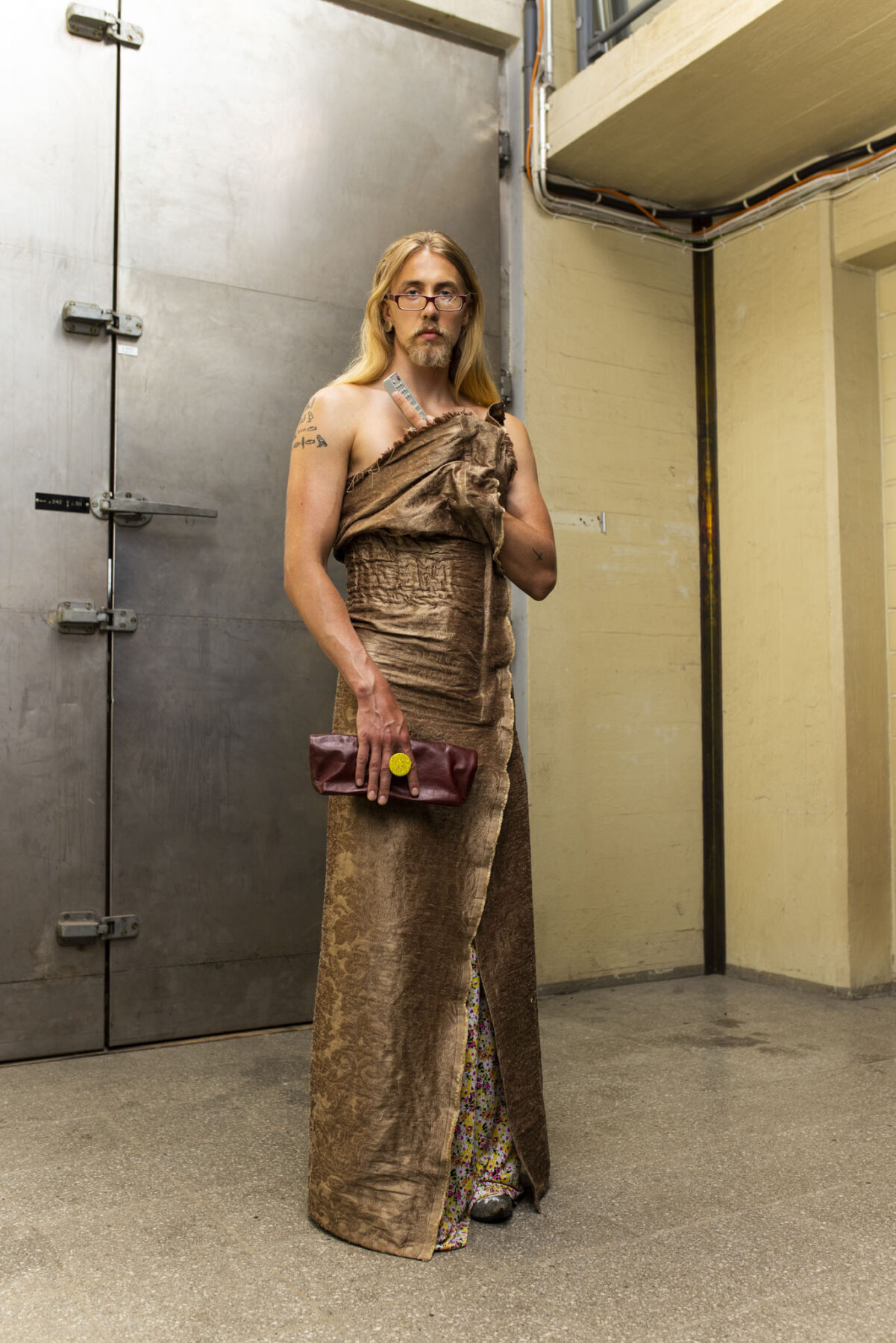 E&E_07
E&E_07

Eemil Halme & Eetu Saarentausta BA Graduate colaborative collection Photographer: Sofia Okkonen
E&E_07Rakastaja / Lover *
Eemil Halme’s and Eetu Saarentausta’s method of working thrives in a state of tediousness. A selection of found garments act as a guide, a starting point to a research procedure that ends up in them seeing garments rather as systems than as pieces of clothing. A practice that is obsessively monitoring garments state of being, trying to find the points to poke at but also letting go of the control as much as possible. The end result celebrates the mundane in all its glory.
– I like to compare this way of almost overanalyzing a piece of clothing to an act of repeating a word until it either loses all its meaning or the meaning kind of twists. I feel like thats what we do: let the garment distort itself while we watch and press pause at some point, Halme explains.
Materials vary from visibly elegant to trashy, but they all share the same, coincidental nature. Dumpster dived textiles are raised from their cheap and abandoned state to a spotlight. What was in a way insufficient and waste, is now something that actually sets the terms.
The collection is a riddle and contrasts within it create characters that are at the same time recognisable, relatable but ultimately absurd: half-dressed looks, awkwardly fitting attire and accessories that don’t necessarily make sense.
– Collaboration is a key factor in our work. Lines between different fields of work have been blurred, everything has been a collaborative effort. I think thats essential. The kind of trust our working method draws from is peculiar: for us it’s obvious and seamless but its nature is tricky to put in words, Saarentausta summarises thei pair’s work process.
*The word “Bachelor’s thesis” was ran through a manual machinery using Google-translator as a tool. After being repeatedly translated from one language to another, the machine transformed the word from academic dryness to something universally warm and simple: “Rakastaja / Lover”.
Contact information:
Eemil Halme
+358 449999939
@71w33
Eetu Saarentausta
eetu.saarentausta@aalto.fi
+358 404163833
@eee.tu